- Longest Active Touring Streaks
- Crue Album Vince Neil Hates
- Rolling Stones Tour Kickoff
- Rockers Toured in 1984 & 2024
- Wetton's Widow on New Asia


How an Unused Jimi Hendrix Album Cover Led to Journey’s Scarab
Near the end of the video for Journey 's new single " The Way We Used to Be ," an animated proxy of guitarist Neal Schon appears to transform into a dung beetle. It would be an odd visual choice if not for the insect's importance in Journey lore, appearing — in various fantastical forms — on multiple album sleeves.
But why a beetle to begin with? The answer involves another rock giant.
"We got the job to do a Jimi Hendrix album cover," visual artist Stanley Mouse told NBC Bay Area in 2017, referencing his creative partner Alton Kelley. "And just as we finished it, [Hendrix] died, so the album cover never came out.
"But it was a scarab beetle with wings — very art nouveau, all done, airbrushed," he added of the image, prints of which are currently available for sale under the title "Power of Soul." "And when we got back to San Francisco … I knew the bass player in Journey, and he came over and said, 'Hey, can you do us an album cover?' So we morphed the Jimi Hendrix beetle into the Journey emblem, and that's where the Journey scarab was born."
It may be an unusual choice for a cover centerpiece, but the scarab immediately stood out on the front of Journey's sixth LP, 1980's Departure , as a rainbow-hued winged creature flies among the planets. Journey obviously dug the vibe: Two projects from the following year, the live LP Captured and blockbuster Escape , reworked the bug into new contexts.
The meaning of these images didn't need to be decoded: They're just striking as abstract art pieces. But Mouse, a regular collaborator in the psychedelic scene (including the Grateful Dead ), offered his own trippy explanation for the iconography.
"I did the Captured album in 1981, and it is a scarab that carries its eggs in a dung bowl," Mouse told the Washington Post in 2015. "When the eggs hatch, the babies feed off the dung and become beetles. It’s the regeneration of life. Escape is the beetle breaking out of a planet, which was the dung ball he was pushing around."
Asked if the band was aware of this meaning, he replied: "I didn’t even know about it. Some Japanese media people came to interview me about it. So I had to do some research. I went into ancient Egyptian mythology and learned myself."
By this point, Mouse had been a Journey regular for years, having earlier co-created sleeves with Kelley for 1978's Infinity and 1979's Evolution . But the succeeding dung-y era could be the most distinctive: bold enough to warrant picking the LPs off the racks, weird enough to keep fans intrigued years later.
The beetle also became a signature Journey reference, even spilling into other forms of media. A 1982 Journey Escape Atari game tasked users with guiding the band to the scarab spaceship amidst "hordes of Love-Crazed Groupies, Sneaky Photographers, and Shifty-Eyed Promoters," according to the manual .
Other artists prepared modified scarabs that appeared on subsequent Journey album covers – including 2001's Arrival , 2005's Generations and 2011's Eclipse – but the image remained crucial for Mouse on a personal level.
"I was working with [Kelley] for many years and that came to an end just before Escape ," he recalled in Neil Daniels' 2012 book, Don't Stop Believin': The Untold Story of Journey . "We did a few Journey covers together. I did the Escape art by myself and, now that I think about it, the album was well named for my escape.
"I had escaped many things at that time when I look back at it," Mouse continued. "I had an agent that was also Journey's marketing agent, Jim Welch. My lady was pregnant with my daughter at the time (might be something to read into that). My influence was from a German artist who did a similar bursting, breaking-out smashing explosion. I don't recall his name, but it left a big impression on my mind. … You might say Captured and Escape was some 'breakthrough' art for me."
Journey Solo Albums Ranked
See Neal Schon Among Rock’s Forgotten Supergroups
More From Ultimate Classic Rock
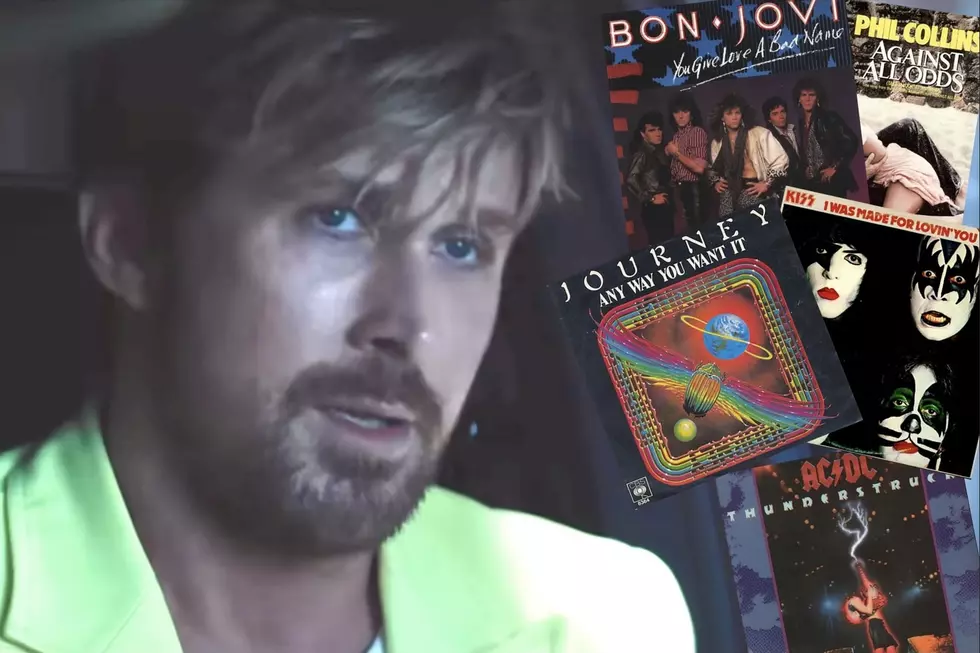
Overthinking It
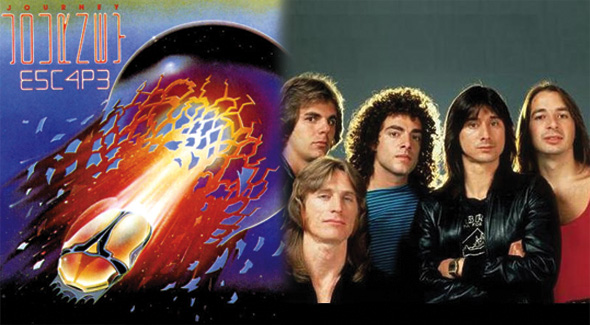
Album Covers That Blow My Mind: Journey’s Escape
A deconstruction of the cover art for the journey album escape ..
[This is the first in what will hopefully be a series of deconstructions of album covers that blow our minds .]
Journey’s seventh studio album, “Escape,” was released in 1981 and spawned no less than four hit singles: “Who’s Cryin’ Now,” “Still They Ride,” “Open Arms,” and everyone’s favorite karaoke/wedding/cryptic Soprano ‘s soundtrack choice, “ Don’t Stop Believin’ .” As if that somehow weren’t enough, these songs all come wrapped in fantastically mind-blowing cover art:
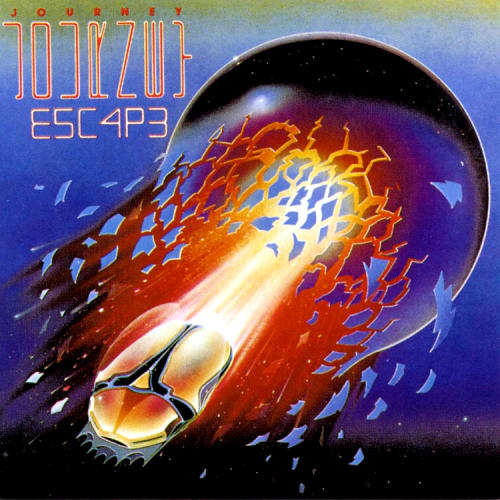
What’s so mind blowing about this?
The Birth of “Leet Speak”?
Did you notice the strange spelling of “Escape” (or rather, “E5SC4P3”) on the cover of this album? Looks pretty “1337,” doesn’t it?
Im in ur st3r30 rockin ur d00dz
Overthinking It readers are probably familiar with (and at least partially annoyed by) the prevalence of “1337” or “leet” speak across the internet. For the uninitiated, leet speak is the substitution of letters with numbers or other symbols to create a symbolic language decipherable only be a select–or shall I say elite–or shall I say “leet”–few.
Though leet speak became widespread with the proliferation of online gaming, in particular, Doom, the practice originated back the early 1980’s, when its use was limited to an actually somewhat “elite” corps of hackers and other sophisticated computer users to mask illicit activity (software piracy and porn distribution) from BBS administrators.
Hmm. Early 1980’s. You mean, like 1981 early?
Obviously, it’s a stretch to think that either the band Journey or the artist responsible for this album cover invented leet speak, or was even aware of its existence at the time. Yet, despite my best attempts at googling, I couldn’t find a more specific date for the birth of leet speak other than “the early 80’s,” which leaves open the oh-so-slight possibility that Steve Perry was teh 0r1g1n4l h4x0rs.

d0nt st0p bl3v1ng w00t!
Even if the leet phenomenon and the Journey album art are causally unrelated, the two combined do result in some pretty rich irony. Leet speak was originally used by an elite few to mask the true nature of contraband material from both the unknowing masses and from the authorities. Journey, on the other hand, was the polar opposite from “contra”-bands (pun intended) like AC/DC or Judas Priest and strove to maximize its appeal among the unknowing masses.
So why use the cryptic spelling of E5C4P3 on its album cover? Perhaps to convey a sense of mystical other-worldliness to go along with…
The Star Ship Scarab Beetle
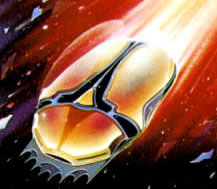
Power ballads. The final frontier.
By now, you’re probably used to seeing the scarab beetle in association with Journey–it’s featured prominently on their mega-selling Greatest Hits compilation, of which I am a proud owner–but at the time of Escape , it was only the second instance out of their seven studio albums to use the scarab beetle on its cover. The previous album to do so, Departure , was released a year prior to Escape, and also featured other-worldly imagery, but Escape kicks things up several notches with its depiction of a warp-speed beetle busting out of some sort of spherical object.
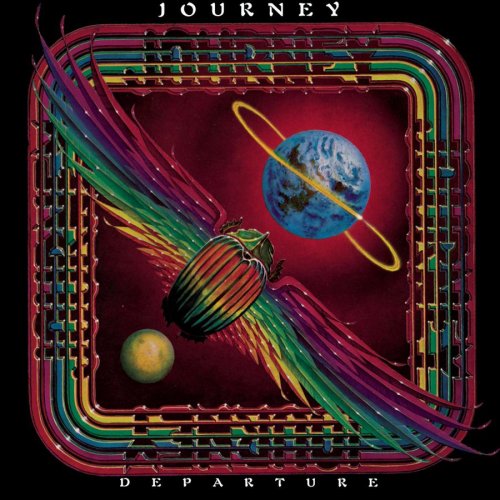
Dude, it’s a dung beetle.
(Updated April 23, 2017: Twitter user @raycoopteacher pointed out that Journey released a live album Captured that featured the dung beetle prior to Escape. )
Google mysteriously comes up short in providing an explanation as to why the band chose to incorporate the scarab beetle on its album covers. Fortunately for us, that allows us to create our own interpretation.
First, a quick primer on Egyptian mythology: the scarab beetle was notable for a couple of things: first, it’s a dung beetle. Yup, the band Journey chose the same beetle that begins its life eating from the ball of shit that it was born into, then later rolls its own ball of shit into which it will plant its own eggs. Nothing says “80’s power pop/rock” like shit-eating beetles, right?

So that makes Steve Perry the shitty Paul McCartney?
Instead, let’s examine the other thing that the dung, er, scarab beetle is notable for. It’s a symbol of the Egyptian god, Khepri, who in turn is a symbol of rebirth, the sun, and creation. The solar association helps make some sense of the Departure album art–the beetle in that image is one of several heavenly bodies depicted–but that still leaves a lot to be explained for the star ship beetle on the cover of Escape.
The best explanation I can provide centers around the rebirth and escape elements. Rebirth, in the case of Journey, refers to the band itself: they started out as a jazz fusion/progressive rock group, but with the addition of singer Steve Perry in 1977, were reborn as a straight pop group. As for escaping, well, that one’s easy: “They took the midnight train, goin’ anywhere…” Granted, a dung beetle traveling at light speed is several steps removed from the midnight trains referred to in “Don’t Stop Believing,” but you get the idea.
Bonus Video Game Postscript:
Or maybe I’ve got it wrong. Perhaps the scarab beetle is meant to be a vehicle for the band to escape from groupies and unscrupulous promoters:
Yup, that’s the Journey video game based on the album Escape. Hmm, it looks rather difficult. Perhaps only the most “elite”—or dare I say, “1337”—players could truly master this one.
And now it all comes together.
23 Comments on “Album Covers That Blow My Mind: Journey’s Escape”
Nothing about the countdown progression of “5-4-3” in the l33t speak letters?
No one has noticed the word “HOLY” in the breaking glass at the top?
The scarab beetle looks like a computer mouse to me. A rocking computer mouse.
I thought the same, I think the artist of the cover is a prophet , it took a message of God and put it on a draw, in 1981 mouses were not that broadly used , and if you google it, they were kind of square , this ship looks like a 2000’s mouse. and another coincidence is that the artist last name is Mouse. could you decipher the message
Mlawski amazing you mention the beetle looks like a computer mouse, as the artist who came up with the cover is named Stanley Mouse…. no kidding. Hmm..
@Sharper: good catch. I wonder where the 2 and 1 are.
Something else that I didn’t get around to overthinking: the way “Journey” is tilted 90 degrees on its side. I desperately want there to be some sort of hidden message. The N and E become a Z and W sideways. Could that be a clue?
In terms of the name Journey on its side, perhaps the artist wants us to view the cover at the angle so the word journey is standing upright and legible. I’m still looking… help me out here
@mlawski: ME FRIGGIN’ TOO!! So could that be intentional, as well? It would fit with the leetspeak, wouldn’t it? Did computer mice look like that yet?
Um, how could you forget the glaringly obvious Freudian subtext- here not a phallus, but the oddity of sperm actually escaping from the egg? Although to be fair (and the space theme helps this) it could equally be a fully formed fetus and the womb.
Ouch, that childbirth looks quite painful. Look at all the rips, and the deep red… Poor space woman metaphor.
Maybe it’s because my time zones are all messed up, and maybe I’m severely jet lagged, and maybe, just maybe it’s the result of a deranged thought process, or just too simple a mind, but am I the only one seeing the phallic representation here?
Journey’s live album “Captured” thus the next being Esc4p3(between Departure and Esc4p3) also featured the Beetle on the cover as well as the infinity symbol, which started with the album “Infinity”. Esc4p3 was the first album with Jonathan Cain, who replaced original keyboardist Gregg Rolie, so it kind of was an escape from their past sound. The original covers also had raised letters and art.
Recently I saw videos from the flat earth society (not that I believe it is) and it looks like the beatle is breaking free of the alleged dome that keeps humanity trapped inside. It could symbolize ascension and our souls being able to join with cosmic consciousness, freed from the confines of what some feel is a prison planet.
Mark Lee, I guess you are over thinking it. The band has always been fixated on the future and celestial travel, which they featured on the album covers. The members are seen floating like zero gravity, being transported on Look into the Future, Evolution, Departure, Captured, Escape and Frontiers. All had space travel as a theme one way or another…it’s the band’s JOURNEY together. I remember the tilted letters when the album Escape was released and it made you thing it was some alien writing. The Scarab was also a symbol of transformation which the band adopted in late 70’s. You have to realize we landed on the moon in 69 and the band was formed a couple of years later.
Journeys Music (with Steve Perry,of course,)transports the fans minds,hearts,and souls, to a whole other dimension. Journey has always poured its heart and soul in to it’s music. That is why Journey and it’s music has always resonated with me, and all it’s other devoted fans. I do not care if the music of Journey is esoteric in any way,shape,or fashion, they will always be The best to me,and all there worldly fans. Steve Perry is and always, shall be known, as the heart and soul of Journey. #1 fan, and admirer, for life.
I’ve taken the beetle to be a Jungian reference.
Diving in to The Red Book, it seems to be about synchronicity, awakening, and awareness of the human journey.
Like many bands of the mid 70’s- early 80’s, Journey presented their message/beliefs in their album covers. The limited access to see these bands in media platforms (tv award shows, later MTV), other than in concert, made album covers a big part of a fan’s ‘experience’. Journey was a leader in giving fans some amazing album covers.
Nobody has yet mentioned that their covers represented their belief in Astral Projection, an out of body experience, and reincarnation. Thus the connection with the Egyptian Scarab (Beetle), space travel, pyramids. This belief was shared with other bands in that era – Earth, Wind, and Fire is a good example.
As far as the Leet message, computer coding was in its infancy back in 81. If you were in a high school math class you may have been introduced to something called FORTRAN. This is what you’re seeing on E5C4P3.
https://www.deviantart.com/leathurkatt-tftiggy/art/Journey-Album-Covers-404525347
Departure Captured Escape
I think it’s as simple as that. The sphere the beetle is escaping from is the same one it’s captured in on the cover of the previous album.
You can almost make out Holy Horus in the cracking orb.
Almost zero people knew about 1337 at this point. However, it’s likely that the among the few people who did know, there were Sound Engineers if they were making/experimenting with computer sound creation/manipulation, which at that point was extremely low level programming. They’d certainly be what we’d consider 1337. Also, amongst the 1337 community there has always been a very close affinity and connection with such low level sound and music programming. Also, this is the type of music that alot of the 1337 computer creators and manipulators listened to. Also the fact that the cover points to Egyptian Gods and far-reaching ideas WAY outside the mainstream makes it far more likely to have had more meaning to the 1337folk. It’s entirely possible that this album cover created the movement, and 1337 users adopted it in tribute, at least for much of it. There would be a single handful of people who would have used it at that time, and in 81 you could pretty much say whatever you wanted in IRC, the entire internet was Dark web at that point. The fact that Journey is flipped 90 with a font design purposefully intended to be confusing for the layman and appear foreign is the very essence of 1337, and points to the E5C4P3 being their own original concept as well. Very likely they started the movement, not the band directly, but Sound Engineers and Designers of the day on the project.
Also, the Breaking out theme probably really resonated with the smarter, more technically elite people of the day, as it represents really the movement of the entire internet at that point, and the liberating ideas of the global perspective seeking to break limits and barriers and dogmatic views and beliefs oppressing and limiting the masses of the day. In truth, the cover represents currently much of what many people on the internet still feel today. It seems just as relevant to all of the people who are currently breaking free of the mainstream ideologies, looking beyond common beliefs and mass media consumption, breaking through the barriers that have been put in place to keep us confined, to an interspatial, limitless journey far beyond what “they’d” like us to believe. It really represents much of the Dark Web today.
It’s Osiris,or Baal or (INSERT OTHER CULTURES SUN GOD HERE), aka SATAN. They are obviously Satan worshipers.
The spaceship beetle bursting from the sphere, to me, is an obvious follow up to the album art for Captured. The cover art is spherical and the band members are shown looking trapped in a sphere on the back. Clearly they “escaped” from being “captured” on their next album by bursting through in a space beetle. I was a little surprised this wasn’t in the blog post, or am I the only one with this opinion?
All this talk about beetles and Egyptian mythology and no mention whatsoever about crediting the artist(s) who created it. One should think think that would be – oh I don’t know – maybe the very first thing that you would bring up.
does the word between journey and escape spell or mean anything? it almost looks like a word upside down and backward .
Add a Comment
Click here to cancel reply.
The Scarab Beetle: A Symbol of Mystery, Myth, and Magic
Published by ALKEMYSTICA on 11/12/2023 11/12/2023
Throughout history, certain creatures have captivated human imagination, inspiring myths, legends, and mystical beliefs. Among these creatures, the scarab beetle stands out as a symbol of profound significance in various cultures. Often associated with the underworld, rebirth, and transformation, the scarab beetle was closely associated with the sun god Ra and played a crucial role in the Egyptian belief system, particularly concerning magic and the underworld. In this exploration, we delve into the rich history and symbolic meanings of the scarab beetle, uncovering its profound influence on human culture and spirituality.
Ancient Egypt: The Divine Khepri
In the annals of human history, perhaps no civilization revered the scarab beetle more than ancient Egypt. Known as “Khepri” in Egyptian mythology, the scarab beetle was known for its unique life cycle and was deeply intertwined with creation and transformation.
Khepri ( ḫprj ) is derived from the Egyptian language verb ḫpr, meaning to “develop”, “come into being”, or “create The beetle’s life began as a humble larva, eggs which had been laid in dung and which emerge fully grown. In this way, the scarab beetle seems to have been created out of nothing.
This analogy of burrowing into the earth, resemble the sun sinking beneath the horizon. In this stage, Khepri was seen as representing the idea of death and the underworld . Egyptians believed that the sun god Ra traveled through the underworld during the night, only to reemerge at dawn, just as Khepri emerged from the earth.
Khepri was depicted as a giant scarab or a man with a scarab for a head. Just as the scarab beetle rolled the dung balls across the earth, Khepri rolled the newly born sun across the sky, symbolizing the sun’s daily rebirth.
Khepri was a solar deity and was often times seen as an aspect of Ra, along with another solar deity Atum. (A-toom) Khepri was the morning sun, Ra was the midday sun, and Atum was the sun in the evening.
The ancient Egyptians believed that the scarab beetle possessed the power of transformation and rebirth, mirroring the sun’s journey. This symbolism was applied to the deceased as well, as they were believed to undergo a similar journey in the afterlife.
Scarabs as Symbols of Good Luck
Scarabs are well known as being symbols of good luck. Scarab amulets were popular and worn by both the living and the deceased. Three types of scarabs, that seem to have been used in funerary practices were known as heart scarabs, pectoral scarabs and naturalistic scarabs. These scarabs were placed on the mummies to protect and guide the deceased’s soul safely through the underworld. The scarab’s significance in Egyptian funerary rites emphasized its role in the afterlife, where the dead would undergo a transformation much like the beetle’s metamorphosis from a lowly dung roller to an elegant, winged insect.
Commemorative scarabs were sometimes given as royal gifts or propaganda in support of Egyptian political purposes and had been found inscribed with royal names.
Egyptian scarabs were carried by traders into Mesopotamia and the Mediterranean to sell as good luck charms, so, Egyptians weren’t the only culture to ascribe great importance to the scarab beetle. In ancient Greece, the scarab was associated with the god Ares , symbolizing protection and good fortune. It was believed to have protective properties, warding off evil spirits and bringing good luck to its wearer.
Additionally, Sardinia had developed an industry for producing scarabs, which were then imported into ancient Rome, where they were often used as talismans and amulets, believing to possess powers of protection and healing. Rings made of scarab beetles were considered to be military symbols and used during battle. Many roman graves dated from 400 AD were found to have had artificial scarabs.
Not only used for good luck, but also for healing, Some ancient papyrus documents even attest to the scarabs being used in traditional medicine. And in medieval Europe the beetle was used in folk medicine, often times extracting the Oil obtained from the larvae and being used as a cure for scratches and other wounds as well rheumatism and anemia.
Transformation and Resurrection
The scarab beetle’s association with transformation and resurrection is a common thread throughout its history. In many cultures, the scarab’s ability to roll balls of dung across the ground and then lay its eggs within them was seen as a metaphor for transformation. This lowly creature demonstrated the power of life emerging from death and decay.
In ancient China, the scarab symbolized the cycle of life, death, and rebirth. It was considered a representation of transformation and spiritual awakening.
Similarly, in some Native American cultures, the scarab’s presence was believed to herald positive change and transformation. Among the Hopi tribe, the scarab beetle was considered a symbol of endurance, as it could thrive in harsh desert conditions.
Scarabs in the Underworld
The underworld often played a significant role in scarab mythology. Similar to Egyptians, in the Mayan culture, scarabs were associated with the Sun God Kinich Ahau and were also linked to the underworld and death. It was considered a guardian spirit that could ward off evil forces and ensure safe passage to the afterlife. By Using, amulets and talismans on the deceased, or in the tombs, for protection and guidance.
Magical and Occult Significance
Scarabs are also featured prominently in the realm of the occult. Throughout history, these beetles have been used in various magical and mystical practices. They were often carved into amulets, inscribed with symbols and spells, and worn for protection or to invoke specific energies.
In Western esoteric traditions, scarabs have been associated with the concept of transformation and personal growth, as well as having the power to overcome obstacles. Spells and rituals involving scarab imagery are designed to help individuals break free from stagnation, achieve personal growth, and embrace change in their lives.
For this, Its symbolism is also sometimes present in alchemical texts, where it is associated with the transformation of base substances into gold, reflecting the alchemical goal of achieving spiritual enlightenment and perfection.
Modern Symbolism
In modern times and popular culture, the scarab beetle still holds symbolic significance, although it may not be as widely recognized or revered as it once was.
In music, We can see the rock band Journey, from the 80’s, used the scarab beetle as their main logo and in the cover art of the albums, including their greatest hits, departure and escape.
In literature, P. G. Wodehouse’s first Blandings novel – Something Fresh (1915) – involves the pilfering of a rare Egyptian scarab (a “Cheops of the Fourth Dynasty”) as a key plot device.
In film, we see In Stephen Sommers action adventure movie’ The Mummy (1999), the scarab is depicted as an ancient, deadly beetle, killing whatever or whoever it sees and eating it’s entire body, including the organs.
And for lovers of Tarot, there is Lo Scarabeo , the Italian Tarot card making company based out of Torino, Italy. Scarabeo being the Italian word for Scarab. Here, you can find tarot cards , oracle cards and more.
And in video games we see the scarab beetle in Tomb Raider, The last revelation from 1999, with Lara Croft being attacked throughout the game by deadly scarab beetles and also Scarabs being used as the monetary unit of planet Sauria (originally known as Dinosaur Planet) in the 2002 video game Star Fox Adventures .
In Conclusion
The scarab beetle’s mythological, historical, and occult significance is a testament to its enduring power as a symbol of transformation, rebirth, and protection. From ancient Egypt to distant cultures around the world, the scarab has been revered and respected for its connection to the cycles of life, death, and resurrection. Its mystical appeal persists even in the modern era, where it continues to inspire individuals seeking personal growth and transformation. The scarab beetle’s journey through human history is a reflection of the timeless fascination with the mysteries of life, death, and the forces that shape our existence.
What does The Scarab Beetle symbol represent for you? Let us know in the comments below, share the article…and come back for the next one!
Video version here :
Interesting sources, additional info, images, credits, attributions and other points of views here :
https://en.wikipedia.org/wiki/Khepri
https://ancientegyptonline.co.uk/khepri/
https://www.britannica.com/topic/scarab
https://digitalcommons.unl.edu/cgi/viewcontent.cgi?article=1093&context=entomologypapers
https://pixabay.com/videos/beetle-insect-bug-flowers-scarab-65825/
Leave a Reply Cancel reply

Your email address will not be published. Required fields are marked *
Save my name, email, and website in this browser for the next time I comment.
Related Posts

Myth, History and Symbolism Occult
Nicolas flamel: medieval french alchemist, philanthropist and immortal.
Nicolas Flamel, a figure shrouded in mystery and legend, is often remembered as one of history's most enigmatic alchemists. Born in the 14th century in Paris, Flamel's life and legacy have become intertwined with tales of alchemy, mystical pursuits, and the quest for the philosopher's stone.

Alchemy and the Healing Arts – Unveiling the Mysteries of Ancient Wisdom
Alchemists sought to transmute base metals into gold, discover the philosopher's stone, purify and elevate the human mind, body and spirit and unlock the secrets of immortality. They sought to bring the body to a perfect state of harmony and being.

Sun worship and Solar symbolism – Myth and History
Sun worship has been a prevalent aspect of human civilization throughout history, with various cultures and civilizations venerating the sun as a symbol of divine power, life, and renewal. This practice has roots in ancient times and continues to influence religious and cultural beliefs in many societies.
Start believin': The story of Journey's Infinity album
By 1978, Journey had a loyal muso following but were still looking for their breakthrough. What they needed was a singer would could turn their improvisations into anthems. Cue one Steve Perry...
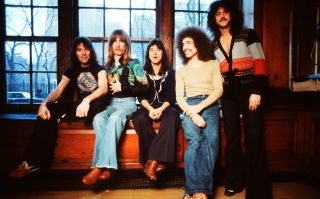
“If I had the chance I would do it all again exactly the same way,” says Steve Perry. “I swear to God. I would not hesitate for a minute.”
Steve Perry is on the phone. The commonly held notion that he’s a dark and sombre recluse couldn’t be further from reality. He’s a veritable ball of energy, dispensing charm and cheer like it was going out of fashion. Before long he’s singing down the phone, and hinting that he wants to stop kicking his heels and put a ‘section’ together (that’s old-school parlance for a band).
We’re hooked up to talk about Journey’s fourth album, 1978’s Infinity. Steve doesn’t give many interviews, but he speaks at length and opens his heart about a record that changed his life, and the course of history for his band;
a record that heralded the arrival of one of the greatest voices of our time, and set Journey on a crash course for superstardom that would ultimately result in their 1981 anthem Don’t Stop Believin’ becoming, in 2009, the best-selling song from the 20th century on iTunes (currently seven million downloads and counting).
All the facts and figures in the Journey story complete a cluster of astonishing accomplishments which are the envy of the music industry. Achievements that, in today’s music marketplace, would be almost impossible to duplicate. For a good 12 years, Journey took position at the very top of the food chain, releasing album after album of instantly recognisable songs all embellished with clear-cut hooks and melodies to die for.
These are records that have stood the test of time, and because of the musicianship inherent in each and every song they have never sounded dated. In many ways, then, Journey were not only pioneers of a style but they were also uniquely aloof – in a league of their own and a world away from the processed, hard-on-the-ears clamour of similar-sounding acts trying to carve out a slice of the same market.
When all is said and done, it was Steve Perry’s presence that really cemented the band’s reputation. Prior to his arrival Journey had been a fairly inconspicuous and mainly instrumental fusion outfit, looking to muscle in on the jazz-rock scene perpetrated by the likes of Weather Report and the Mahavisnu Orchestra.
Classic Rock Newsletter
Sign up below to get the latest from Classic Rock, plus exclusive special offers, direct to your inbox!
Great players, Journey’s early style and meticulous arrangements would, inevitably, limit their appeal unless radical changes were implemented. Their sound had attracted stellar critical reviews but, as a commercial entity, they were stuck in a rut. Not surprisingly, at the behest of their label, Columbia, changes needed to be made, a radical remodelling of the band was demanded to expand their appeal.
Infinity marked Perry’s initiation into the world of professional recording, a milestone in contemporary aural acrobatics. Within the confinement of 10 songs he effortlessly switched from breezy improvisation ( La Do Da ) to epic bombast ( Wheel In The Sky ), providing a template from which future creative diamonds would emerge, forever cementing the appeal of Journey and securing his place in rock’s vocal Hall Of Fame.
- Steve Perry on Infinity, track by track
- Journey’s Cain says it’s time for band to put Neal Schon spat behind them
- Def Leppard and Journey announce massive 58-date North American tour
Unlike the brusque delivery of British blues-belters such as Coverdale and Rodgers, Perry’s reference points evolved from diverse and somewhat unexpected sources, including the sweet soul sounds of Sam Cooke and Smokey Robinson.
Born in California in 1949, Steven Ray Perry was of Portuguese extraction. The family’s original name of Perrera was quickly anglicised to Perry when the family had entered the US, to disguise the fact that they were European immigrants (a common policy back then to improve employment opportunities). Growing up, his epiphany moment was hearing the Sam Cooke song Cupid on the radio while riding in his mother’s car. From that moment on, becoming a musician was all he dreamed of.
By his teens, Perry was a veteran of several garage bands, singing and drumming with names such as The Nocturnes, Dollar Bills, Ice (also featuring future producer Scott Matthews) and The Sullies. He even joined a Toronto-based unit called Privilege and toured Canada.
“They were a 12-piece brass group that had played in my home town near Fresno,” says Perry. “I was so blown away by how amazing they were I kept in touch with the guitar player, one of two brothers, Andy and Harry Krawchuk, and they hired me for a few months. I toured Canada with them – they were a very high-end covers band.”
By the mid 70s, Perry focused all his energies upon infiltrating the music business and moved to Los Angeles, where he formed a band called Pieces alongside experienced musicians like Cactus/Beck Bogert & Appice bassist Tim Bogert, guitarist Tim Denver Cross and drummer Eddie Tuduri. Sadly no deal was forthcoming. Bogert and Tuduri then moved to the UK to join British prog rockers Boxer.
In order to support himself, Steve took a gig as a second engineer at Crystal Studios while piecing together his next outfit, called Alien Project (the group occasionally switched to the moniker of Street Talk, which Steve later used for the title of first solo album). It was this unit that caught the ear of a couple of labels, including Chrysalis and Columbia. The latter’s A&R man, Michael Dilbeck, was hot to sign them.
The group featured drummer Craig Krampf who would later go on to become an in-demand session musician.
“Craig had some contacts in the business,” says Steve, “enough where he could pick up the telephone and call them. He was really good at hustling and got us into Chrysalis and Columbia. Michael Dilbeck was one of the Columbia people who heard Alien Project and liked it. He talked with Don Ellis who was running the West Coast office. They were thinking of signing the band.
“Back in those days, the sweetest thing that could happen was signing to a record label and making a record – that was the pathway of dreams for all of us. Michael liked the band, but I must say the demo got kind of shelved a little bit, meaning he liked it but wasn’t really moved to sign us right away. So we were kind of vacillating, thinking should we go back to Chrysalis who had been pretty excited. Then the next thing that happened was, someone at Columbia decided to go around Michael and send my demo tape to Herbie Herbert, Journey’s manager, in San Francisco.”

It’s impossible to talk about Journey without the towering presence of their manager Herbie Herbert, a bear of a man with a personality and reputation that, at times, has almost seemed to eclipse (pun intended) the band. Think Peter Grant, if he weren’t quite so intimidating and wasn’t surrounded by henchmen with fists at the ready. Herbie loved music and loved Journey. He dedicated his life to their needs and to the advancement of their career. He had a vision and nobody was gonna fuck with it, and recruiting a vocalist to the group was paramount to his plan.
In Steve Perry, Herbert had found the proverbial needle in the haystack – a vocalist with unlimited range, unique delivery and looks that killed. The consummate frontman, in fact. There is every reason to believe that Perry singlehandedly rescued Journey from interminable underachievement.
“This is where its gets complex,” Steve says, of his initial meeting with Herbert. “Herbie had already heard my name. I was mentioned to him by one of his team, Jackie Villanueva. Jackie had a friend in Frisco by the name of Larry Luciano who, as it happens, was a childhood friend of mine. We had grown up together. Larry had moved up there and become friends with Jackie and the Santana clan. That’s when he and Larry became friends with Herbie.
“Larry told him that he had a cousin called Steve Perry and that I was a pretty good singer and he should check me out. That never came to fruition until the guy at Columbia sent the Alien Project demo tape to Herbie, who saw the name and thought, ‘Steve Perry… Hmmm… Larry’s cousin?’ And of course it was. Then Herbie called me up and said, ‘I love the way you sing, I love what you’re doing and I love the band.’”
However, this budding relationship between Herbert and Perry was suddenly derailed due to the tragic death of Alien Project’s bassist Richard Micheals Haddad, who was killed in an automobile accident on the July 4th weekend. The rest of the band felt like the rug had been pulled from under their feet.
“We were due to resume talks with the labels after that weekend but, of course, it never happened,” says Perry. “I started to pack it in and called my mom to say, ‘I’m coming back home.’ It felt like the closer I got to achieving my dream, the bigger something in my life would say ‘no’. At that point I’d never been so close to someone who had died and I thought, ‘I’m not supposed to do this.’
"I was so distraught and knocked back by it all. But my mother said, no, don’t give up – something will happen. And that’s when I got a telephone call from Don Ellis, who said, ‘I’m sorry to hear about your bass player, but Herbie Herbert has your tape and he loved it. We have Journey on Columbia and we’d love you to be the singer of that band. What do you think about it?’
“I had seen Journey come to town and play many times in LA and I knew that my voice with Neal Schon’s guitar would be like salt and pepper.
"I knew that if I could ever work with him that would be a dream. It was Neal who really attracted me to that set up.”
Journey’s origins go right back to the beginning of the 70s, with the band members based in San Francisco, the centre of hippy counterculture. Keyboard player Gregg Rolie was a founding member of Santana, immortalised by the group’s stunning appearance at the Woodstock festival. The footage of Rolie trashing the living daylights out of his organ during Soul Sacrifice became iconic.
Guitar prodigy Neal Schon was also cooking up a name for himself in the Bay Area, not only as another alumni of Santana but also by working his way through a number of musical cabals, including Latin rockers Azteca and the Golden Gate Rhythm Section. Joining Journey on bass was Ross Valory and second guitarist George Tickner, both of whom were from the curiously named Frumious Bandersnatch. The band’s first drummer was Prairie Prince from fellow SF band The Tubes, but he was quickly replaced by British ex-pat Aynsley Dunbar, who had moved to the US to play with Frank Zappa’s Mothers Of Invention.
Journey’s interest in experimental jazz-fusion was confirmed on their self-titled debut album issued in 1975. A classy work, the album resonates with a surety beyond their recent formation, all players coming across as both fluid and experienced. Neal Schon in particular rips up his fretboard like combination of Jeff Beck and Robert Fripp. Check out the seven-minute long Kahoutek where he trades call-and-response licks with Gregg Rolie.
Surprisingly for such complex music, the album sold moderately well, reaching No.138 on the Billboard chart. After George Tickner bailed out of the band, their next two albums – 1976’s Look Into The Future and 1977’s Next – repeated the pattern, with Gregg Rolie making a concerted effort to deliver reasonably effective vocals atop what was clearly a jazz-fusion fanfaronade.
Despite the concerted efforts of both Columbia Records and Herbie Herbert, it was clear that Journey had reached a sales ceiling. They could continue no further in an upward trajectory unless major changes were implemented. Effectively this meant adding a proper vocalist/frontman and modifying the musical direction. It was a bitter pill to swallow but the band took it on the chin and cast their net to see what was possible.
They settled on Californian Robert Fleischman, who teamed up with the band in June 1977, at the request of label president Bruce Lundvall, who asked Robert to fly to San Francisco and see the band. Fleischman rapidly assimilated with his new bandmates, co-writing a handful of songs, three of which – Wheel In The Sky, Anytime and Winds Of March – would later surface on Infinity . Pretty much an unknown, Fleischman was, at one point, in the running to replace Peter Gabriel in Genesis for their A Trick Of The Tail album, a move scuppered when Phil Collins made a last-minute decision to step up to the microphone.
Things were moving swiftly – if not completely smoothly – when, as previously mentioned, Steve Perry’s name entered the frame. Fleischman had been out on the road with Journey during the summer, supporting Emerson, Lake & Palmer, and matters had progressed to the point where it was understood by all that Robert was their new vocalist. Behind the scenes, however, Robert had apparently been ruffling feathers. Herbie was seemingly concerned that Fleischman was unwilling to relinquish his previous manager, well-known US concert promoter Barry Fey. A reputed incident where Robert allegedly refused to go onstage unless the band played newly written material may not have helped matters either.
By now Herbie and Columbia were coming to the same opinion: that Steve Perry would be the better option for Journey frontman. Matters accelerated when Herbie asked Steve to go out on the road with the band to get to know each other. Fleischman was unaware of his diminishing status within the set up, which resulted in an uncomfortable situation. Perry’s presence in the Journey camp was explained by passing him off as Jackie Villanueva’s Portuguese cousin.
“That really only happened one time,” says Perry. “I think it was when they were playing a show at Long Beach Arena, and I don’t think Robert was actually performing with the band – he was doing soundchecks with them. I think they had pretty much told him he was going to be the singer. I was also told that internally they were conflicted about it. I said to John Villanueva [brother of Jackie, and also part of Herbie’s management team] at the Oakland Coliseum,
‘Do you think this could really happen?’ And he said ‘yes’. So I was hanging around, waiting for my opportunity.
“Actually, it should be pointed out – and I only found this out a few years later – that the label had told the band that if they didn’t get a singer they were going to drop them.”
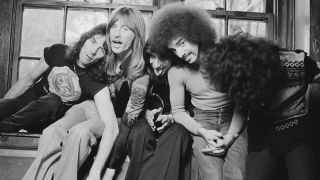
Gregg Rolie has some further insight.
“At the time Neal and I were looking for someone with more of an edge, but Herbie brought us Steve Perry,” he says. “We thought that he was a bit of a crooner and we were looking in a different direction. Robert is a great singer, but there was a lot of politics with the record company and various other things that took place there. They’re two very different singers.
“Steve actually came out on the road with us as my keyboard tech John’s cousin,” confirms Gregg. “We had to make the change, and it was a difficult thing to do, but Robert made a bit of a mistake. We were opening for ELP and he kind of made an ultimatum in Fresno, that he wanted us to play the new songs, but we were just trying to get the band across. We wanted to do the older material because it was more in keeping with the audience.
“He said he wouldn’t go on and that was a mistake on his part. Herbie made the decision right there to fire him. Nothing was really written in stone until that happened. For me, it’s now water under the bridge. I like Robert a lot and I liked what he brought to the situation. Robert has more of an edge but they’re both quality guys. It’s always a struggle.”
Did Steve feel that he had been forced upon the band by the label and Herbie?
“He [Herbie] said in essence, if not the actual words, ‘This is your new singer, deal with it,’” says Perry. “I don’t think I would have been in the band if Herbie had not just said, ‘Look guys, get used to it, keep going and shut the fuck up and write the music.’ Herbie and I have had a lot of artist/management collisions across the years.
"We accomplished so much together but it’s almost normal that artists and management have their issues. That being said, had it not been for Herbie my life would be profoundly different right now. He gave me my chance.”
Gregg: “In the end we made the right choice. Quite frankly, Herbie presented it as ‘this is your new singer’ and we were like, OK. And the fact is, he was absolutely right. Y’know, the proof is there.”
Did the band embrace Steve or were they a little apprehensive?
“You have to remember that the band had recorded three records and toured extensively,” says Perry. “Herbie was very talented in his ability to get that band to open for some very big acts – ELP and Santana – and play big outdoor shows. However, even though that was happening, they weren’t selling enough records. I think they wanted to make it on their own terms, so maybe it was a little weird for them to have to bring in a singer.
“Neal Schon was the guitar prodigy and stood centre stage. The group was built by Herbie around Neal, showing off his virtuosity. They had more of an instrumental Mahavishnu Orchestra thing going on, so it was a transition for them. Sure, I think we had our moments of difficulties with me being the new guy, so for a while I had to sort of walk on thin ice.
“It was a ‘let’s do it and see’ kind of attitude, and I had to prove myself, and I understood that, I really did. I can’t fault them for any hesitancy, because yes, they had a following before I joined them and they had fans out there that wanted the band to be successful as a fusion-based band with Gregg Rolie singing a little bit and Neal, Ross and Aynsley going off into fusion rock.
"When I joined I think they were concerned whether the fans would embrace me. Some did and some didn’t, and it was difficult walking out there. I remember one time we were in Paris I had a [camera] flash cube thrown at me and hit me in the eye.”
Gregg: “Perry wasn’t nervous, and if he was, it sure didn’t show. He knew he was good and he was co-writing a lot of the material. When you co-write, you get pretty comfortable about what you are doing, because it’s customised for you.”
How did Gregg Rolie feet about all this - he had, after all, been the band’s vocalist up until this point?
“I do believe in my heart that Gregg wasn’t that excited about the idea," says Perry, "but on the other hand he was certainly amenable and open-minded. We wrote Feeling That Way together, sharing vocals, and that was cool. In fact that’s the song where I would walk out on stage.”
From Gregg Rolie’s perspective, the situation was clear. “I expected to still sing a couple of songs here and there, but Steve was our lead singer,” he says. “I was stretched pretty thin playing four keyboards, harmonica and singing lead. With Santana I was the lead singer, and with Journey I was lead also. So, I’d never shared vocals before.
"I wanted to continue to do that – I looked at it like, well, The Beatles didn’t do so bad with four singers. So the more the merrier, and I still feel that way about it, but it just slowly got to be less and less.
“Eventually the band got built around Perry,” Gregg continues. “He came in at it slowly and it evolved into this situation where we were writing songs for an actual lead vocalist, which is totally different from where early Journey and Santana came from. Back then we had vocals, but it was really about the solo work and then, slowly, it became more about the lead vocals. It was great for me because I became a much better songwriter.”
It was the beginning of a new chapter for both of them. Blessed with an appealing personality, good looks and a voice from heaven, Perry soon became the focal point of attention. It was now time to unleash his talent in the studio by recording Journey’s fourth and pivotal album, Infinity .
The plan was simple: write songs, hire a producer, select a studio and make an album that would set out their stall for the next 10 years or more. Steve immersed himself in songwriting with all the band members, but mainly with new creative partner Neal Schon, eventually securing co-writing credits on eight of the 10 songs.
Steve and Neal struck up a strong rapport and quickly established a beachhead, strengthening the band’s sound and setting in place a new direction. The emphasis was now on fully formed songs with melodies, hooks and the sort of contemporary buff that made the competition quake in their boots.
The choice of producer was inspired. Band, management and label all agreed on Roy Thomas Baker, the flamboyant British studio craftsman who had worked with some of the most influential rock bands around, including Free and – most importantly – Queen.
After seeing the band live in Santa Monica, RTB (as he is affectionately known) and his trusted engineer Geoff Workman rendezvoused with the band at His Master’s Wheels Studio (formerly Alembic Studios), located on Brady Street in downtown San Francisco.
“They put me in a little apartment on Bay Street,” remembers Steve. “I went to SIR [Studio Instrument Rentals, a well-known rehearsal room] every day and wrote songs with band.
“Then, all of a sudden RTB comes in. We had enormous respect for him, because he’d produced Queen and Free. He was so much fun. The studio [His Master’s Wheels] had an old Neve console and a large tracking room, and the next thing you know he was really giving us a different sound.
“Neal’s doing what we called ‘violin guitars’. Roy had me stack all the vocals on a 40-track machine, and I really enjoyed that process. Also, Geoff Workman was so instrumental that we ended up grabbing him to do one of the records [ Departure ] without RTB.
“We rehearsed the material quite a bit before we recorded it so everything was ready to go before Roy got there. What Roy gave us was the opportunity to try different textures and ideas, but the foundational aspect of the songs and the arrangements were done. He really gave us a direction, and from there the band found itself.”
“I have fond memories of working with Roy and Geoff,” says Gregg. “Roy was very into experimentation, and quite wild in the studio. The multi-tracking of guitars and vocals was a brand new thing for us – all the layering. It was intense work. He created a sound which a lot of the guys didn’t like because it was so edgy, but I happened to dig it.
“Those tracks had a specific sound to them, which is what a good producer does. He was, and still is, a real character. Him and Workman both – they were fun to be around. Workman did a lot of the heavy lifting, inasmuch as getting things done.
“Geoff had worked with Roy for a long time and knew what he wanted. If Roy disappeared for a couple of hours, Geoff just carried on because he knew what they were doing as a team. We used the same team on the next album, Evolution . It got us on the map.”
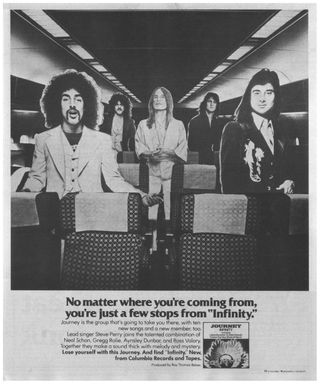
Not surprisingly, the biggest impact was the quality and strength of Steve Perry’s vocals.
“I certainly discovered the depth of multi-tracking, as I never had a chance to work on a 40-track machine before,” says Perry. “I’d never had the ability to do eight root notes and then bounce them to one track, then wipe those and do the eight thirds, wipe those then do eight fifths and eight octaves and so on – and suddenly you have a big stack like on Anytime . When they are layered and smeared tight they just really block up. Roy knew how to do that.”
But despite the good vibes and enthusiastic progress, the glue soon came unstuck when a studio prank backfired…
“One night we went out for sushi and drank a bit of Sake,” laughs Steve. “Roy drank a little bit more Sake than most of us, along with a couple of the road crew. When they got back, Scotty [Ross, roadie] remembered a story about how Roy had once chased Freddie Mercury around the studio with a fire extinguisher.
“So Scotty decided to be funny and grabbed one of the studio extinguishers and chased Roy. Then Roy grabbed an extinguisher to reciprocate and fired it off, but it was one of those dry chemical types. The next thing we knew was that we couldn’t breathe – it had sucked the oxygen right out of the room and we couldn’t see in front of us for the smoke. So we ran outside thinking, ‘Oh my God, what the hell happened there?’ After a while we walked back in and the place looked like it had snowed, everything was covered in white powder. The problem was that the console, the recording tape and everything had this fine, very abrasive powder all over it.
“The Neve console was ruined. We had to quickly remove the tape because the dust would eat the oxide, so we moved to Cherokee Studios in Los Angeles to finish the vocals.”
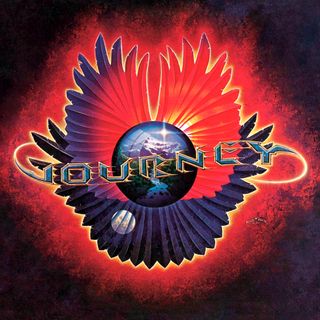
With the album completed, a design makeover followed. The band brought in renowned San Francisco artists Alton Kelley and Stanley Mouse (real name Stanley George Miller). The duo had first hooked up with San Francisco’s counter-cultural doyens the Grateful Dead (designing their album covers) and legendary West Coast promoter Bill Graham (designing his gig posters). During the early 70s they had formed the Mouse Studio, and helped rebrand Journey by designing and standardising their cover art, including Infinity’s colourful flaming wings. The pair also came up with a Journey logo.
Says Perry: “Bruce Lundvall was the president of Columbia at the time, and he quipped that, in order for us to make another record with me singing, we would have to sell one million units. Hence the reason we stayed on the road for 298 shows that year. We started touring in February and didn’t come home for almost a year.
“ Wheel In The Sky was the first single. Neal and I went to a pizza place, and I went over to the jukebox and saw a Wheel In The Sky 45 in that machine – an ecstatic feeling. I didn’t tell Neal, I just put two quarters in, pushed the button and sat down and the song started. Neal looked at me and started laughing. It was a monumental moment. Back then if you were starting to show up in jukeboxes it was a sign that you might be finally starting to happen. My mom had an eight track in her car and she would play the cassette to everybody saying, ‘That’s my Steven.’”
Although the tour emphasised the band’s growing stature, it also highlighted that while Aynsley Dunbar was an exceptional rhythm king, he was perhaps too complex for the way Journey’s music was developing.
“Van Halen were the opening act on the tour,” remembers Steve. “They were a brand new band back then. We were doing 3,000-seat auditoriums and they were killing us every night. It was eye-opening. We were keeping up with them, but they were certainly making us be a better band. They were so musically simple.
“Well, I was a drummer before becoming a singer and one of the things about being a drummer is that I’m kind of hard on other drummers. Foundationally you can have a really great band, but if the drummer doesn’t measure up you’re not going to do very well. But if you have a mediocre band and a great drummer you’re going to do better. So we’d do soundchecks and sometimes Aynsley might not be there or be off doing something like radio promotion and I would do soundcheck for him – set his drums up and play a few songs. It started to be apparent to Neal and to myself that the band sounded different with me because I’m a slamming R&B-style drummer, as opposed to a jazz-fusion drummer like Aynsley.
“Aynsley’s style had been perfect up to when the band changed style. As the music evolved, we started to work up some of our new ideas with me playing drums, and they didn’t sound as good with Aynsley playing them. So we toyed with that for a while, but occasionally we kept being reminded about it while jamming new ideas for the follow-up record. And then we saw Steve Smith playing drums with Ronnie Montrose, who was also one of our support bands, and we thought, ‘Help, what do we do now? Because this guy sounds like the cat.’ We started hanging out a lot – the next thing is we made a switch.”
Journey’s run of success continued with their follow-up albums, from Evolution through to blockbusters such as Escape, Frontiers and Raised On Radio .
Their continued uphill trajectory was an unprecedented triumph, propelling the band into increasingly larger arenas and stadiums, right the way through to the late 80s, before they implemented a (theoretically) indefinite and somewhat strained hiatus. With hindsight, the appointment of Steve Perry and the creation of the Infinity album was one of the pivotal moments in the development of modern rock.
“I liked the songs, I liked the edge and I liked the dual vocal stuff,” reflects Gregg Rolie. “The band had a lot of colour to it and I think we could have explored more of that. Infinity for me personally was a big change; writing songs for singing rather than writing songs for playing. The addition of harmonies and multi-track vocals… we’d never sung harmonies like that before.
“Also, the songs were great: Patiently, Winds Of March, Lights … Later it started going away from where I thought it should have been, but I’m only one member of the band so you’ve gotta roll with it. On Infinity there was still solo and instrumental work influencing how it sounded – it still had that vibe of being alive. It was always powerful. We actually carried that edge into the Evolution album.”
“If I had the chance I would do it all again exactly the same way,” says Steve Perry in conclusion. “I swear to God. I would not hesitate for a minute.”
Journey are on tour now. This article was first published in Classic Rock presents AOR, issue 11
Derek’s lifelong love of metal goes back to the ’70s when he became a UK underground legend for sharing tapes of the most obscure American bands. After many years championing acts as a writer for Kerrang! , Derek moved to New York and worked in A&R at Atco Records, signing a number of great acts including the multi-platinum Pantera and Dream Theater. He moved back to the UK and in 2006 started Rock Candy Records, which specialises in reissues of rock and metal albums from the 1970s and 1980s.
“Like Volare, the marriage of voices flies free in a spirit of joy.” Punk icons Iggy Pop and Siouxsie Sioux have re-recorded The Passenger for an ice cream advert
Eddie Van Halen was a Meshuggah fan, according to son Wolfgang: “He said, ‘The drummer better be paid the most!’”
Can headphones cause hearing loss? "It's more than likely that you are listening to your favourite bands at ear-damaging levels, and you might not even be aware of it"
Most Popular
The Hidden Meaning Behind These Album Covers
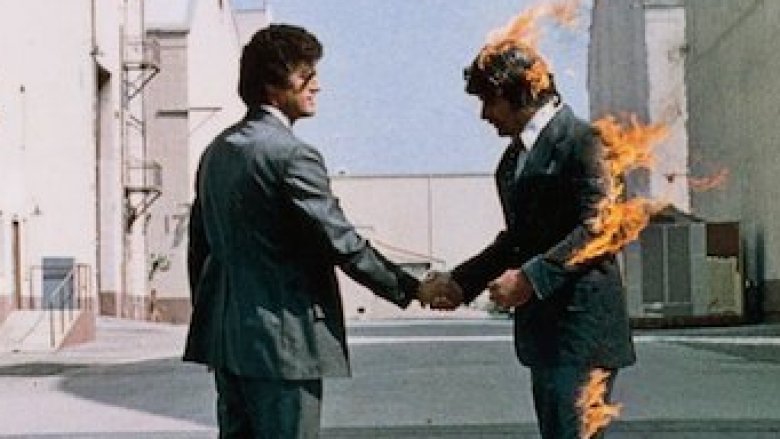
An album cover is almost as important as the music contained on the record or CD within. (Or, you know, the list of iTunes tracks next to a thumbnail image of that artwork.) A great piece of album art can tie an album together, give listeners something to cool to look at while they groove to the tunes, or provide clues about the inspirations behind the music ... or just be an obtuse series of nonsensical, random images. Here are some famous album covers in which there's far more than meets the eye, which is to say they actually do have a point.
Mumford and Sons - Babel (2012)
The most banjoing-est band on Earth broke through in a huge way with Babel, its second album of hard-charging, old-timey American folk music as performed by a bunch of English guys in vests. The cover of the record counteracts how seriously the band takes itself and its music, depicting the band sitting on a bench (some of them are even smiling!) while behind them, in front of a pub, there is much revelry, dancing, a guy in a crazy costume, and even a horse. They're partying so hard there's no way they're listening to Mumford & Sons, except they probably are because all those people are friends, relatives, or employees of Mumford & Sons. Band member Ted Dwane told Fuse that his girlfriend runs "an immersive theater company, and they came in and got everyone to go crazy. So everyone was being unnaturally fast in the background." So that explains the blurry look. But why such a chaotic image? Dwane said the band wanted the Babel cover to capture the spirit of their "Gentlemen of the Road" tour, particularly its "party vibes."
The White Stripes - Elephant (2003)
The "brother-sister" (actually ex-husband-wife) Detroit folk-punk duo released their fourth album, Elephant, in 2003, which boasted one banger after another, like "Seven Nation Army" and "The Hardest Button to Button." The sound that came out of just two musicians was huge, kind of like ... an elephant. Jack White says the grand beast appears on the jacket. In Jason Draper's A Brief History of Album Covers (via Diffuser ), White claims, "If you study the picture carefully, Meg and I are elephant ears in a head-on elephant. But it's a side view an elephant, too, with the tusks leading off either side." OK, well, all that seems to be there are the Whites in their usual classic Nashville finery, along with an amplifier and a cricket bat. But if Jack White says there's an elephant on Elephant, there must be an elephant on Elephant . (To be fair, if you squint, you can see the rough shapes.)
Tool - 10,000 Days (2006)
Tool has always catered to the discerning metalhead. Its music is complex, and its lyrics are inscrutable, as if Judas Priest went to grad school. It follows that the band's album covers are as cryptic and weird as its songs. The artwork of the band's 2006 album, 10,000 Days, depicts a creepy, somewhat ancient-looking face with deep eyes. Then a closer look reveals it's three faces; it's like one of those Magic Eye pictures but with more existential dread. The picture is part of a painting called Net of Being by psychedelic artist Alex Grey, who gets his inspiration from ingesting hallucinogenic substances such as LSD, mescaline, and ayahuasca. The cover of 10,000 Days doesn't mean much in particular, although Grey told The Examiner (via AlexGrey.com ) that anytime somebody takes one of those drugs, "The visions that people encounter during these journeys are often deeply symbolic."
Rihanna - Anti (2016)
Over the past decade and change, Rihanna has evolved from a singer of throwaway dance singles into a complex and challenging musician. Her album covers have evolved, too. Gone are the glamorous, sexy shots adorning Good Girl Gone Bad and A Girl Like Me. In their place: provocative, thoughtful covers like ANTI. The 2016 album features an artfully out-of-focus image of a child, wearing a crown and holding a black balloon, against a white and blood-red background, along with some Braille messages. It's the work of an artist named Roy Nachum. "He sees things beyond the surface, which is why we even decided to collaborate," RiRi said at the album's cover launch party. (Yeah, the cover is so tight it got its own launch party.)
Nachum started with a real childhood snapshot of the singer, taken on her first day of daycare at age five. "The crown over the eyes is a symbol for the music," Nachum told Rolling Stone. "Here, I painted the young Rihanna bringing something new." The Braille message, for those who don't read Braille with their eyes, is from a poem called "If They Let Us" by Chloe Mitchell. An excerpt: "I sometimes fear that I am misunderstood. / It is simply because what I want to say, / what I need to say, won't be heard." As this is the album that includes some of Rihanna's boldest work ever, message received.
Coldplay - X&Y (2005)
Coldplay's third album offers up another round of that dreamy, sleepy, inoffensive music that's cool enough for the alternative rock station but lame enough for that "listen at work" station. And yet, the same old Coldplay isn't expected from the album's refreshingly weird cover: It's a blue background, and then some random, rainbow-colored blocks that looks like somebody made a cartoon appetizer out of Lego. Those colorful shapes are actually a graphical visualization of the Baudot code . That's an early telegraph communication system patented by French inventor Emile Baudot in 1874. Used concurrently with the more familiar Morse code, the Baudot system transmitted readable messages as ones and zeroes, assigned five-character sequences for every letter, number, and punctuation mark (e.g., B = 10011). On X&Y , the different colors and sizes of the blocks correspond to different bits and their letters, which spells out ... the album's title.
Kanye West - The College Dropout (2004)
Not too many artists have a mascot. Sure, Iron Maiden featured its monstrous Eddie the Head on stage and on album jackets, and the '70s/'80s soft rock/country group Pure Prairie League put a cartoon cowboy on the front of all its records. And then there's Kanye West's "Dropout Bear," who first appears on the front of the rapper's game-changing 2004 debut The College Dropout, sitting forlornly on some gym bleachers. Plain Pat, West's manager at the time, confirms that it's Yeezy himself inside the bear suit, and also that the bear doesn't have any much meaning at all. "The bear just happened to be at the school where Def Jam had booked the photo shoot for the album," Plain Pat told Complex in 2014.
The Black Keys - Brothers (2010)
Sometimes, you can sell something just by saying it plain. Black Keys drummer Patrick Carney's brother Michael designed the cover of Brothers . Michael came up with the idea to just put words on a sleeve (meta, self-referencing words on a self-aware sleeve) when everyone decided to do something different from the standard album covers they'd done earlier. According to the New York Times , Michael suggested text that read, "This is an album by the Black Keys. The name of this album is Brothers" against a black background. He also thought the raw, simple cover reflected a similar sensibility in the band's bluesy, rootsy rock. But as the Black Keys' songs often recall music of the past, that cover is extremely evocative of the cover of blues legend Howlin' Wolf's 1969 LP The Howlin' Wolf Album . That one had black text on a white background (as opposed to the Black Keys' mostly white on black) and read, "This is Howlin' Wolf's new album. He doesn't like it. He didn't like his electric guitar at first either."
Arcade Fire - Neon Bible (2007)
The cover of Arcade Fire's second album is a static image — we're not into the era of Harry Potter-style moving images for covers quite yet — but upon a closer inspection, does it look like the pages of that open book made of light are in motion? Well, good, because that was the intent of cover artist Tracy Maurice, part of the same Montreal art community that spawned Arcade Fire. Once the band had decided on Neon Bible for a title, Maurice erected a 7-foot-tall book made out of neon — you know, like a neon bible. The band and Maurice planned to bring the piece on the road and hang it "as a backdrop at live shows, but it turned out it was too fragile to transport," Maurice told Billboard . For the cover, Maurice filmed the flickering sign with a 16 mm camera, then overlaid three separate frames to create that eerie image.
So what is a "neon bible"? Arcade Fire leader Win Butler took that from the novel of the same name, a lesser work by A Confederacy of Dunces author John Kennedy Toole. Butler told AV Club that while he's read the book, the name is a coincidence. "I just jotted it down in my notebook and kept coming back to it," he said.
Kendrick Lamar - To Pimp a Butterfly (2015)
No pimps, no butterflies, just two dozen or so mostly African-American men and boys of all ages celebrating in front of the White House. Photographer Denis Rouvre took the striking black-and-white photo of Lamar and a bunch of the rapper's family and friends, many of whom Kendrick Lamar told Mass Appeal he's known since elementary school. (Lamar is among them — he's the guy holding the baby.) Lamar's idea was taking those close to him "around the world and letting them see things that I've experienced," such as the White House, where he met with Barack Obama, the first American president to embrace hip-hop.
Not among the celebrants: a dead judge with his eyes literally X-ed out. The judge is there as a losing counterpoint to Lamar's family and friends, some of whom have criminal backgrounds. "You look at these individuals, you look at them as bad people, or a menace to society, but they're actually good people. Just a product of their environment," Lamar explained. "And the one person that hurts their life is a judge ... handing out football numbers of years and not giving these kids a chance at life."
Radiohead - Kid A (2000)
Radiohead's most experimental album to that point (since surpassed every time Radiohead releases an album) was its trippy masterpiece Kid A. Oddly, it's not the Radiohead album that included the song "Knives Out," because Kid A 's dreamy, science-fictiony cover art was painted with knives (and sticks) instead of paintbrushes. "I got these huge canvases for what became Kid A, and I went mental using knives and sticks to paint with and having those photographed and then doing things to the photographs in Photoshop," designer Stanley Donwood explained to NME. The result was an image that Donwood says was intended to suggest "landscapes of power," specifically "some sort of cataclysmic power existing in landscape." Donwood was successful because "some sort of cataclysmic power" is a succinct and perfect explanation of Kid A.
Jay-Z - Magna Carta Holy Grail (2013)
Hov's 12th album is one his few releases that doesn't feature his familiar face. Instead, it's got a black-and-white photo of a couple of statues from antiquity. The source of those sculptures remained a mystery for about a week, until the Metropolitan Museum of Art in New York cracked the case: It was one of theirs. The museum tweeted a side-by-side comparison of Magna Carta Holy Grail and the sculpture Alpheus and Arethusa. While it looks like it came from Ancient Greece (nude dudes, tight curls), it was created in the 16th century by Italian artist Battista di Domenico Lorenzi. Lorenzi drew on a Greek myth about the river god Alpheus' pursuit of a nymph named Arethusa, who tries to escape by transforming into a stream. Of course, he's a river god, and soon his water overtook hers. (Classic river god/nymph stuff.) Why Jay-Z picked this particular sculpture for an album jacket remains a mystery. But it is a piece (and story) about transformation, kind of like how Jay-Z elevated himself from drug dealer to wildly successful entrepreneur and entertainer. (Or maybe, like most pop culture made by Jay-Z or not made by Jay-Z, it's about Beyoncé.)
Dr. Dre - The Chronic (1992)
Fans of '90s West Coast rap, here's a truth bomb: Dr. Dre and his protégé and frequent collaborator Snoop Dogg are very big fans of marijuana. One clue to their enjoyment of the herb is the fact that Dr. Dre titled his first post-N.W.A. album The Chronic. That's a slang term for extremely strong marijuana. Another hint that Dre enjoys the sticky icky: the album's art suggests the packaging used on Zig-Zag rolling papers for decades. (Marijuana is encased into a rolling paper to create a cigarette-like thing called a "joint," you see.)
Joy Division - Unknown Pleasures (1979)
Joy Division's debut album is a goth-rock classic, but it wasn't an immediate success. It grew in status and influence over the years, certainly helped in part by countless cool people wearing T-shirts depicting the record's mysterious cover. It's a series of close-set squiggly lines that form mountain-like peaks in the middle. Cover designer Peter Saville explained in the short documentary Data Visualization Reinterpreted: The Story of Joy Division's Unknown Pleasures Album that the images came from the 1977 edition of the Cambridge Encyclopedia of Astronomy.
It's a visualization, or plot of data, of radio telescope readings picked up from a pulsar. Pulsars are incredibly dense, compressed, rotating stars, in which proton and electron currents moving inside create a magnetic field. The combination of rotation and magnetization form a radio beacon as the star travels through space. Each time the star spins around, a radio telescope captures that signal, which astronomers can then plot on a grid. The one used on Unknown Pleasures is a "map" of the first pulsar ever discovered.
New Order - Power, Corruption, and Lies (1983)
After the death of singer Ian Curtis, Joy Division necessarily evolved into New Order. The band brought along its favorite designer, Peter Saville, who designed the cover for many of its records, include Power, Corruption & Lies. When Saville heard the title, he later told The Guardian that he thought it sounded " Machiavellian ," as in reflective of the dark and ruthless writings of 16th-century Italian political theorist Niccolò Machiavelli. His most famous work is The Prince, and so Saville headed to the National Portrait Gallery in London in search of a portrait of a "dark prince" to use as an album cover.
Does that seem a little on the nose? Saville agreed while at the museum, finding it "too obvious." He and his girlfriend exited through the gift shop, where Saville picked up a postcard of a painting of flowers by 19th-century French artist Henri Fantin-Latour. Saville's girlfriend told him that ought to be the cover. "It was a wonderful idea," Saville said. "Flowers suggested the means by which power, corruption, and lies infiltrate our lives. They're seductive." Heady stuff for an album of synth-pop.
Fleetwood Mac - Rumours (1977)
Sometimes, things that might seem important in a piece of art or an album cover really aren't that significant at all, but that alone can make them significant. Such is the case with the cover of Fleetwood Mac's monster hit Rumours, which members of the band recorded in between breaks from fighting with each other. Just two of the band's five musicians appear on the cover: singer Stevie Nicks and drummer Mick Fleetwood. While Stevie Nicks dances in witchy black clothing (as Stevie Nicks is wont to do), Fleetwood holds his bandmate's hand and stands grandly. Also, two little balls dangle in front of his crotch.
They're the kind one might find dangling from the flushing chain on an old-timey toilet — which is exactly where Fleetwood discovered them years earlier. In 2009 he told Maui Time that he was playing a gig one night and after "a couple of glasses of English ale," he used the facilities, saw the balls, and swiped them. Then he went out on stage with the tiny spheres "hanging down between my legs." Thereafter, they became something of a lucky charm ... until he lost them at a gig somewhere. (Happy ending: he hired a carpenter to make him a new pair of balls.)
Pink Floyd - Wish You Were Here (1975)
Aubrey Powell co-founded a design studio called Hipgnosis, which frequently worked with Pink Floyd , including its album Wish You Were Here. According to Powell's book Vinyl . Album . Cover . Art, ( via Rolling Stone ), the album's lyrics "were all about insincerity and absence" and how the recording industry is "a moveable beast that actually takes casualties with it" ... such as ex-Pink Floyd guitarist Syd Barrett, who officially left the band in 1968 because of mental health issues. (He's also the inspiration for the Wish You Were Here standout "Shine On You Crazy Diamond.") Hipgnosis's other chief creative, Storm Thorgerson, wanted to reflect that tone (prominent in songs about destructive and empty promises, like "Welcome to the Machine" and "Have a Cigar") and mock the music industry by literally depicting the then-common expression, "I've been burnt," i.e., "ripped off." He suggested two guys in suits shaking hands — the internationally recognized image of businessmen making a deal — but with one of them on fire. They hired a stunt man, and lit him on fire, and a photographer snapped the iconic image on the 15th shot. (Poor stunt man.)
Beastie Boys - Licensed to Ill (1986)
Back in the '80s, the Beastie Boys enjoyed an image as the rude, crude, party-crashing princes of hip-hop. But there was a dark, wry, even satiric sensibility hidden beneath the surface. For instance, the group's party-positive bro anthem "(You Gotta) Fight For Your Right (To Party)" was intended as a joke to make fun of songs like Brownsville Station/Motley Crüe's "Smokin' in the Boys Room" and Twisted Sister's "I Wanna Rock." That song appeared on Licensed to Ill, which has a cover laced with jokes and commentary.
In 100 Best Album Covers (via Diffuser ), Beasties producer Rick Rubin said that while the album was being made, he read the salacious Led Zeppelin biography Hammer of the Gods. "In the book, there is a photograph of the Led Zeppelin private jet and the idea of this cover came from that," Rubin explained. "The Beastie Boys were just a bunch of little guys and I wanted us to have a Beastie Boys' jet. I wanted to embrace and somehow distinguish, in a sarcastic way, the larger-than-life rock 'n' roll lifestyle." That's why the cover shows a jet, and the fully extend gatefold shows the rest of the jet smashed into a mountain. But because the Beastie Boys worked on so many levels, there's another, more puerile joke hidden on the Licensed to Ill cover. The plane's serial number is "3MTA3." Held up to a mirror, it reads, "EAT ME."
Led Zeppelin - Houses of the Holy (1973)
Hipgnosis did a lot of work for Pink Floyd, but that band wasn't the only beneficiary of its creepy-meets-pretentious aesthetic. The company produced the artwork for Argus, an album by the relatively obscure prog-rock band Wishbone Ash . Led Zeppelin guitarist Jimmy Page saw it, liked the vibe, and asked Hipgnosis co-founder Aubrey Powell to create the art for an upcoming album from his band. As he related in his book Vinyl . Album . Cover . Art (via Rolling Stone ), Page didn't yet have a title and refused to describe the nature of the music or the lyrics. "Meet me in three weeks, and come up with some ideas. You know the kind of band we are," Page instructed.
One of the sketches Powell brought to the meeting was a visualization of the end of Arthur C. Clarke's sci-fi classic Childhood's End. "There was this image of all the children of the Earth rising up in this great firestorm and going up into outer space," Powell said. The drawing of kids rising upward strongly reminded Led Zeppelin singer Robert Plant of the imposing basalt columns that make up a formation in Northern Ireland called Giant's Causeway. A few weeks later, Powell organized a photo shoot on those rocks — which included, well, naked children, along with their parents, some chaperones, and makeup artists.
Santana - Abraxas (1970)
Except for slapping on the words "Santana" and "Abraxas" (the name of a deity in the Gnostic faith, also found in Herman Hesse's 1919 book Demian ), the cover is a whole-cloth repurposing of an existing painting. It's called Annunciation, and it was made in 1961 by a German-born, Palestine-raised artist named Mati Klarwein . Created in the pastiche/collage style out of folk art and cultural iconography from around the world, the album's imagery has some deep spiritual meanings. In an In the Studio with Redbeard interview, front man Carlos Santana said the cover "signifies the annunciation of this angel Gabriel to Mary. Mary is the black lady at the center of the cover, and Gabriel is the angel with the congas between his legs." Now you know.
David Bowie - Blackstar (2016)
The too-good-for-this-world-anyway David Bowie died in January 2016, saddening and shocking anyone who ever cared about music. He'd just released his latest album, Blackstar, a couple days earlier to rave reviews. ( Pitchfork gave it an 8.5 out of 10; NPR called it "feral, instinctive," and also "brutal and finessed.") The sad truth is that Bowie had been privately dealing with terminal cancer , and Blackstar was his intended swan song. The songs, and even the album's cover, are full of insights only the Goblin King/Ziggy Stardust/The Thin White Duke could provide.
One of those is the title and striking primary cover image: Blackstar and a black star, respectively. That's an alternate way to describe a black hole, a collapsed star that sucks in everything that comes near. It all makes for an apt and striking metaphor for human mortality, particularly when that mortality is the result of the unrelenting, life-sucking destructiveness of cancer. Jonathan Barnbrook designed five covers for Bowie, including Blackstar. "This was a man who was facing his own mortality," Barnbrook told Dezeen . The symbol of a black star on white "has a sort of finality, a darkness, a simplicity, which is a representation of the music." Barnbrook further explained that "the idea of mortality is in there, and of course the idea of a black hole sucking in everything, the Big Bang, the start of the universe, if there is an end to the universe." What have you been doing lately?
chroniclesdengen.com
Helpful blog for everyone, why is there a beetle on journey albums.
2020-08-01 editor Useful Tips 0
Instead, let’s examine the other thing that the dung, er, scarab beetle is notable for. It’s a symbol of the Egyptian god, Khepri, who in turn is a symbol of rebirth, the sun, and creation.
Why does Journey use a scarab?
‘ So we morphed the Jimi Hendrix beetle into the Journey emblem, and that’s where the Journey scarab was born.” “When the eggs hatch, the babies feed off the dung and become beetles. It’s the regeneration of life. Escape is the beetle breaking out of a planet, which was the dung ball he was pushing around.”
What is Journey’s best selling album?
Greatest Hits Greatest Hits is a compilation album by the American rock band Journey, originally released in 1988 by Columbia Records. It is the band’s best-selling career disc, spending 554 weeks on the Billboard 200 album chart (more than any other compilation album, except for Bob Marley’s Legend disc, in history).
What was Journey’s number one hit of all time?
Don’t Stop Believin’ # 1 – Don’t Stop Believin’
What is the meaning of the scarab beetle?
Since the scarab hieroglyph, Kheper, refers variously to the ideas of existence, manifestation, development, growth, and effectiveness, the beetle itself was a favourite form used for amulets in all periods of Egyptian history. …
When did Steve Augeri leave Journey?
About Steve Augeri Drawing on a range of diverse musical influences to deliver a unique take on the genre of melodic rock, Steve Augeri is an American rock singer best known as the lead vocalist for the rock group Journey from 1998 to 2006.
What Journey album is faithfully on?
Frontiers Faithfully/Album
Why is Don’t Stop Believing popular?
That show in particular became highly influential on music sales. They resurrected “Don’t Stop Believin'”, bringing the original cast back to sing it again in the 2015 final season. That blitz of placements, not it’s endurance on classic rock radio station playlists, is why the song is so popular now.
How did Journey get their start?
The San Francisco band got its start in 1973. Santana’s former road manager, Herbie Herbert, recruited two of that band’s members (Gregg Rolie and Neal Schon) and former Steve Miller Band bassist Ross Valory to form the Golden Gate Rhythm Section—the band that later became Journey.
What year did Journey release faithfully?
1983 Faithfully/Released
“I did the Captured album in 1981, and it is a scarab that carries its eggs in a dung bowl,” Mouse told the Washington Post in 2015. “When the eggs hatch, the babies feed off the dung and become beetles. The beetle also became a signature Journey reference, even spilling into other forms of media.
What is on the Journey Escape album cover?
The album cover features a futuristic, scarab-shaped space cruiser with razor blades at the front exploding out of a glass planetoid. Stanley Mouse, best known for his work with the Grateful Dead and Steve Miller Band, designed this cover along with plenty of other Journey albums.
What happened to the original singer of Journey?
Perry took a hiatus, effectively dissolving the band he’d helped make famous. He did not disappear completely — there was a solo album in 1994, followed in 1996 by a Journey reunion album, “Trial by Fire.” But it wasn’t long before Mr. Perry, now 69, explained why he left, and why he’s returned.
Greatest Hits is a compilation album by the American rock band Journey, originally released in 1988 by Columbia Records. It is the band’s best-selling career disc, spending 680 weeks on the Billboard 200 albums chart (more than any other compilation album, except for Bob Marley and the Wailers’ Legend, in history).
Is escape journey finished?
Escape Journey was published in English by SuBLime from September 11, 2018 to April 9, 2019.
Who’s Crying Now release date?
1981 Who’s Crying Now/Released
Does journey have a number one hit?
They have had nineteen Top 40 singles in the U.S. (the second most without a Billboard Hot 100 number one single behind Electric Light Orchestra with 20), six of which reached the Top 10 of the US chart and two of which reached No. 1 on other Billboard charts, and a No. 6 hit on the UK Singles Chart in “Don’t Stop …
Why is scarab beetle on Journey album cover?
Google mysteriously comes up short in providing an explanation as to why the band chose to incorporate the scarab beetle on its album covers. Fortunately for us, that allows us to create our own interpretation. First, a quick primer on Egyptian mythology: the scarab beetle was notable for a couple of things: first, it’s a dung beetle.
What was the previous album of journey called?
The previous album to do so, Departure, was released a year prior to Escape, and also featured other-worldly imagery, but Escape kicks things up several notches with its depiction of a warp-speed beetle busting out of some sort of spherical object. Dude, it’s a dung beetle.
When did the Beatles Magical Mystery Tour come out?
Please note: Magical Mystery Tour(1967) was originally released as a double 7″ EP in the UK, and as a full-length album in North America and elsewhere. This page contains links to features on The Beatles’ albums, in chronological order of release.
Why is the beetle on the cover of escape?
It’s a symbol of the Egyptian god, Khepri, who in turn is a symbol of rebirth, the sun, and creation. The solar association helps make some sense of the Departure album art–the beetle in that image is one of several heavenly bodies depicted–but that still leaves a lot to be explained for the star ship beetle on the cover of Escape.
Copyright © 2024 | WordPress Theme by MH Themes
The Best Journey Albums of All Time
One of the biggest bands of the late 1970s and early 1980s, Journey is considered one of the best rock bands of all time. List of the best Journey albums, including pictures of the album covers when available. This Journey discography is ranked from best to worst, so the top Journey albums can be found at the top of the list. To make it easy for you, we haven't included Journey singles, EPs, or compilations, so everything you see here should only be studio albums.
If you think the greatest Journey album isn't high enough on the list, then be sure to vote for it so it receives the credit it deserves. Make sure you don't just vote for critically acclaimed albums; if you have a favorite Journey album, then vote it up, even if it's not necessarily the most popular.
If you want to know, "What is the Best Journey album of all time?" or "What are the top Journey albums?" then this list will answer your questions. List ranges from Escape to Frontiers and more.This list of popular Journey CDs has been voted on by music fans around the world, so the order of this list isn't just one person's opinion. Use this list to build your own just like it that fits your opinions of where everything should be ranked.
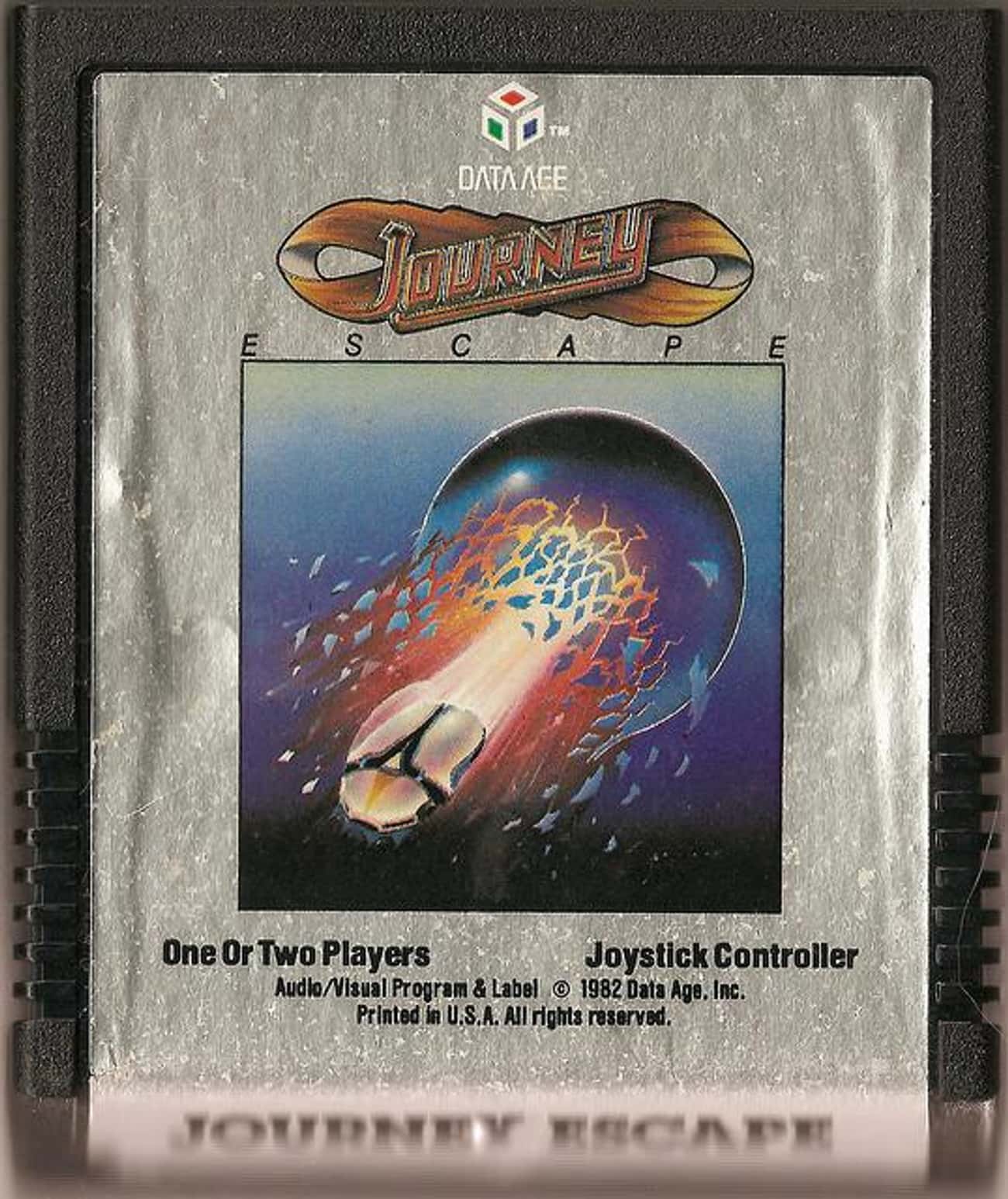
1. Don't Stop Believin' 2. Stone in Love 3. Who's Crying Now 4. Keep On Runnin' 5. Still They Ride 6. Escape 7. Lay It Down 8. Dead or Alive 9. Mother, Father 10. Open Arms
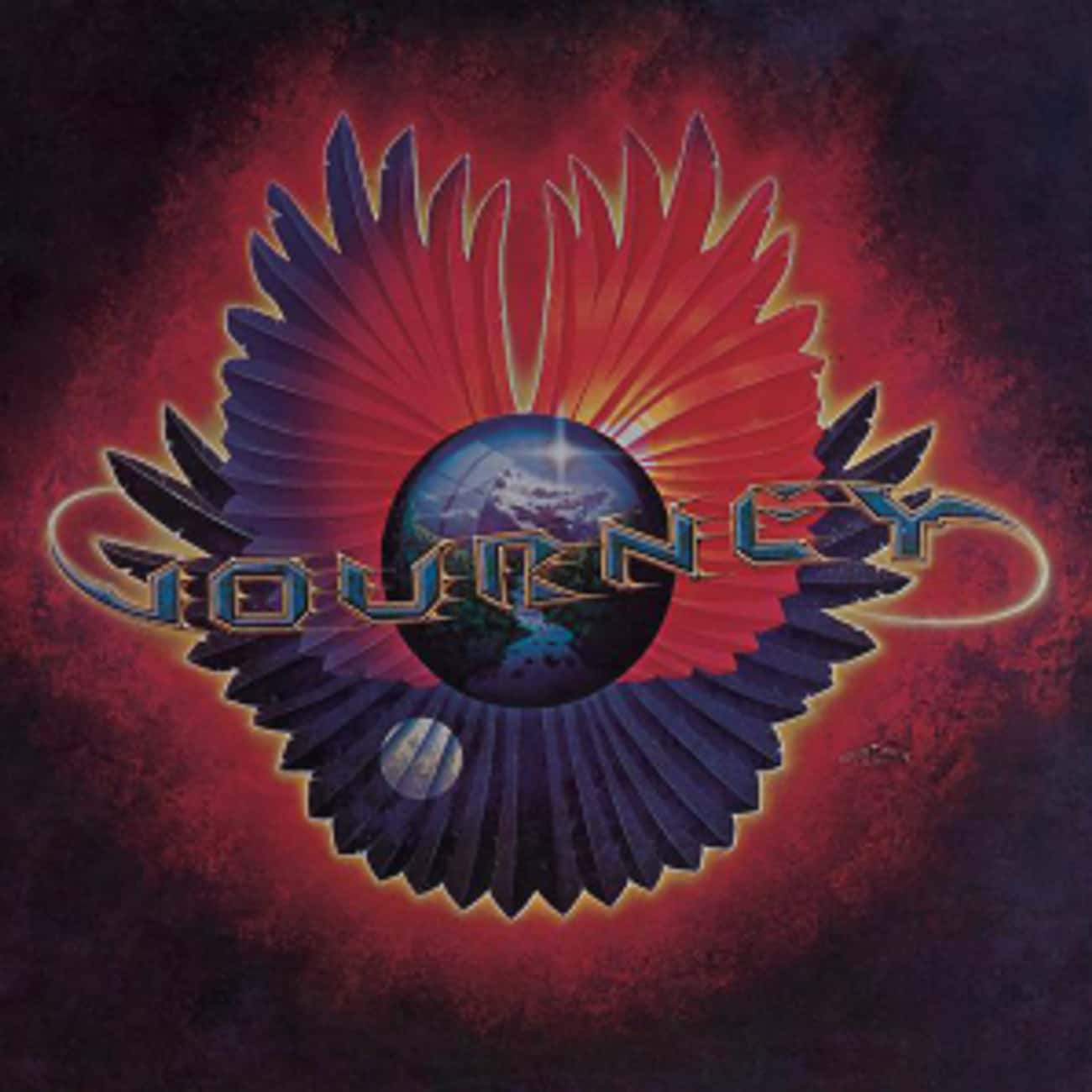
1. Lights 2. Feeling That Way 3. Anytime 4. Lă Do Dā 5. Patiently 6. Wheel in the Sky 7. Somethin' to Hide 8. Winds of March 9. Can Do 10. Opened the Door
- # 1156 of 1,703 on The Greatest Albums of All-Time
- # 137 of 333 on The Greatest Album Covers Of All Time
- # 49 of 77 on Albums You're Guaranteed To Find In Every Parent's CD Collection
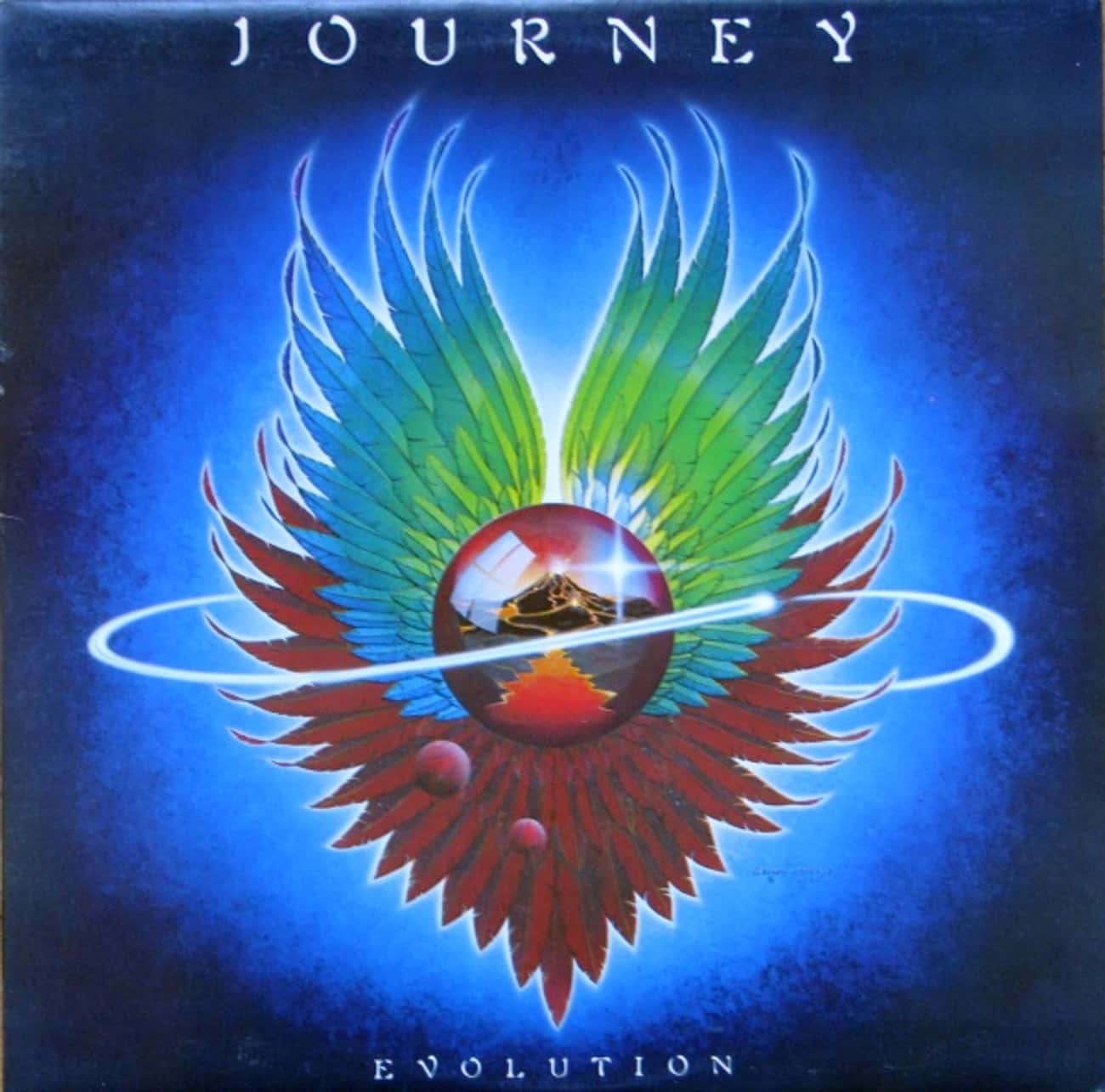
1. Majestic 2. Too Late 3. Lovin', Touchin', Squeezin' 4. City of the Angels 5. When You're Alone (It Ain't Easy) 6. Sweet and Simple 7. Lovin' You Is Easy 8. Just the Same Way 9. Do You Recall 10. Daydream 11. Lady Luck

1. Separate Ways (Worlds Apart) 2. Send Her My Love 3. Chain Reaction 4. After the Fall 5. Faithfully 6. Edge of the Blade 7. Troubled Child 8. Back Talk 9. Frontiers 10. Rubicon
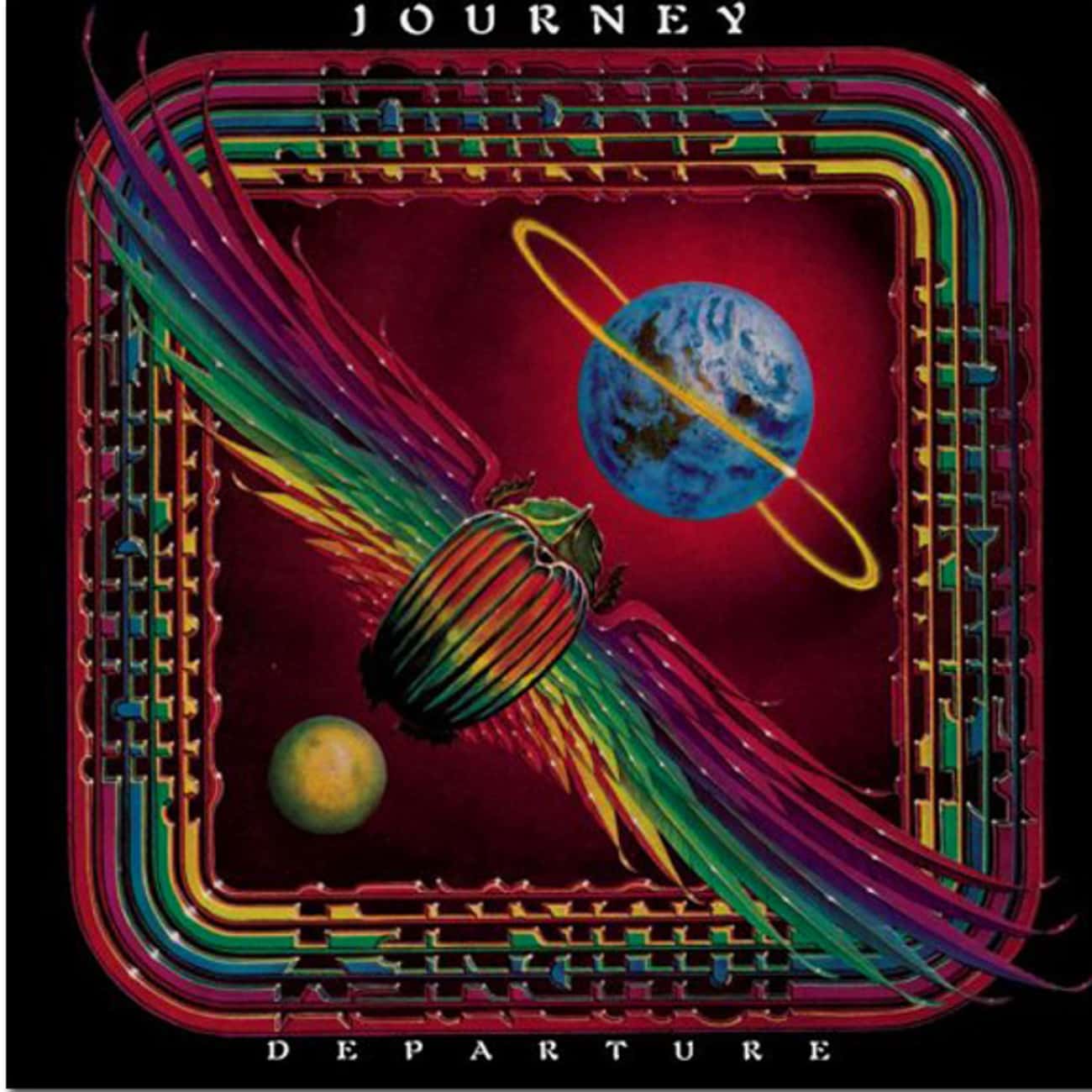
1. Any Way You Want It 2. Walks Like a Lady 3. Someday Soon 4. People and Places 5. Precious Time 6. Where Were You 7. I'm Cryin' 8. Line of Fire 9. Departure 10. Good Morning Girl 11. Stay Awhile 12. Homemade Love
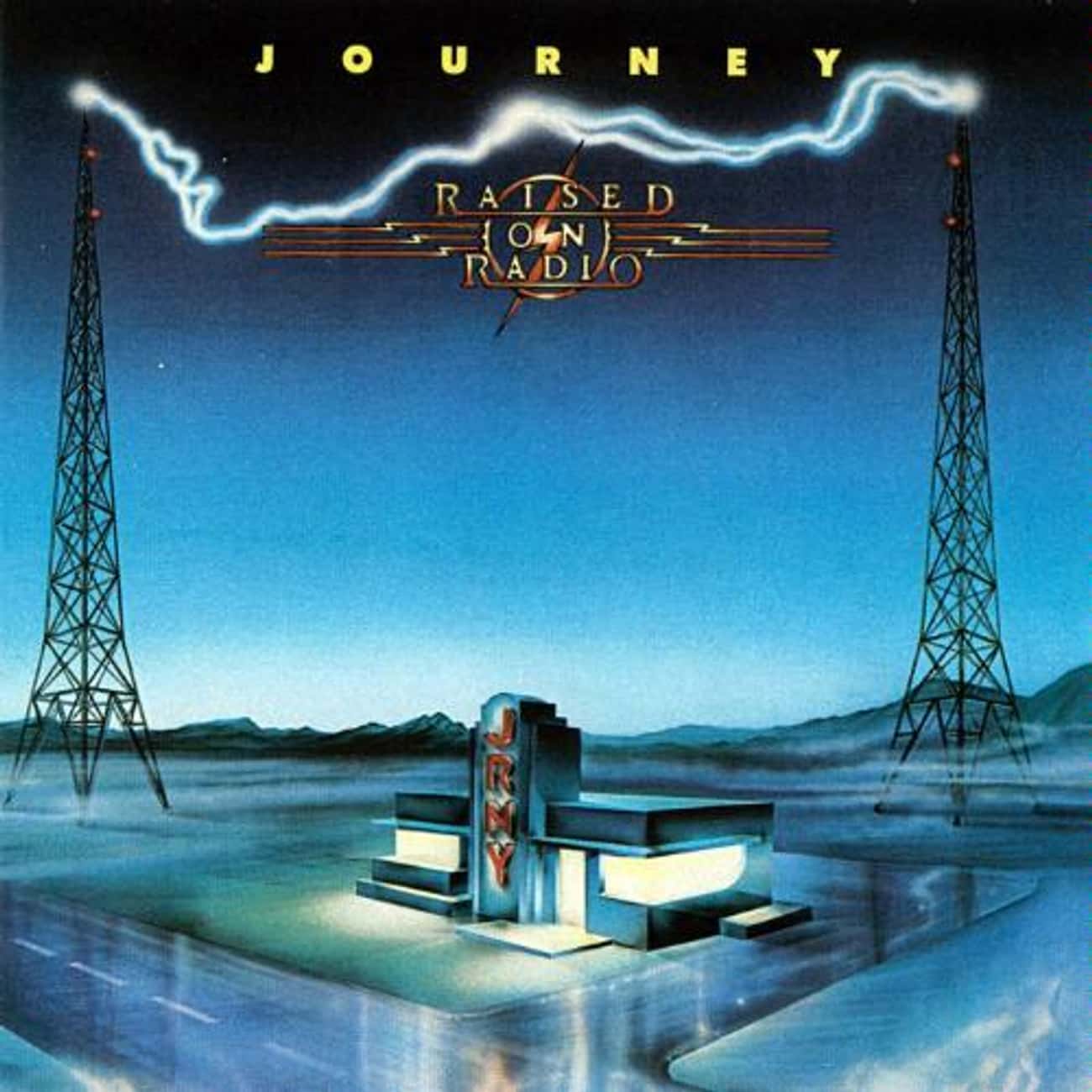
Raised on Radio
1. Girl Can't Help It 2. Positive Touch 3. Suzanne 4. Be Good to Yourself 5. Once You Love Somebody 6. Happy to Give 7. Raised on Radio 8. I'll Be Alright Without You 9. It Could Have Been You 10. The Eyes of a Woman 11. Why Can't This Night Go On Forever

Trial by Fire
1. Message of Love 2. One More 3. When You Love a Woman 4. If He Should Break Your Heart 5. Forever in Blue 6. Castles Burning 7. Don't Be Down on Me Baby 8. Still She Cries 9. Colors of the Spirit 10. When I Think of You 11. Easy to Fall 12. Can't Tame the Lion 13. It's Just the Rain 14. Trial by Fire 15. Baby I'm a Leavin' You 16. I Can See It in Your Eyes
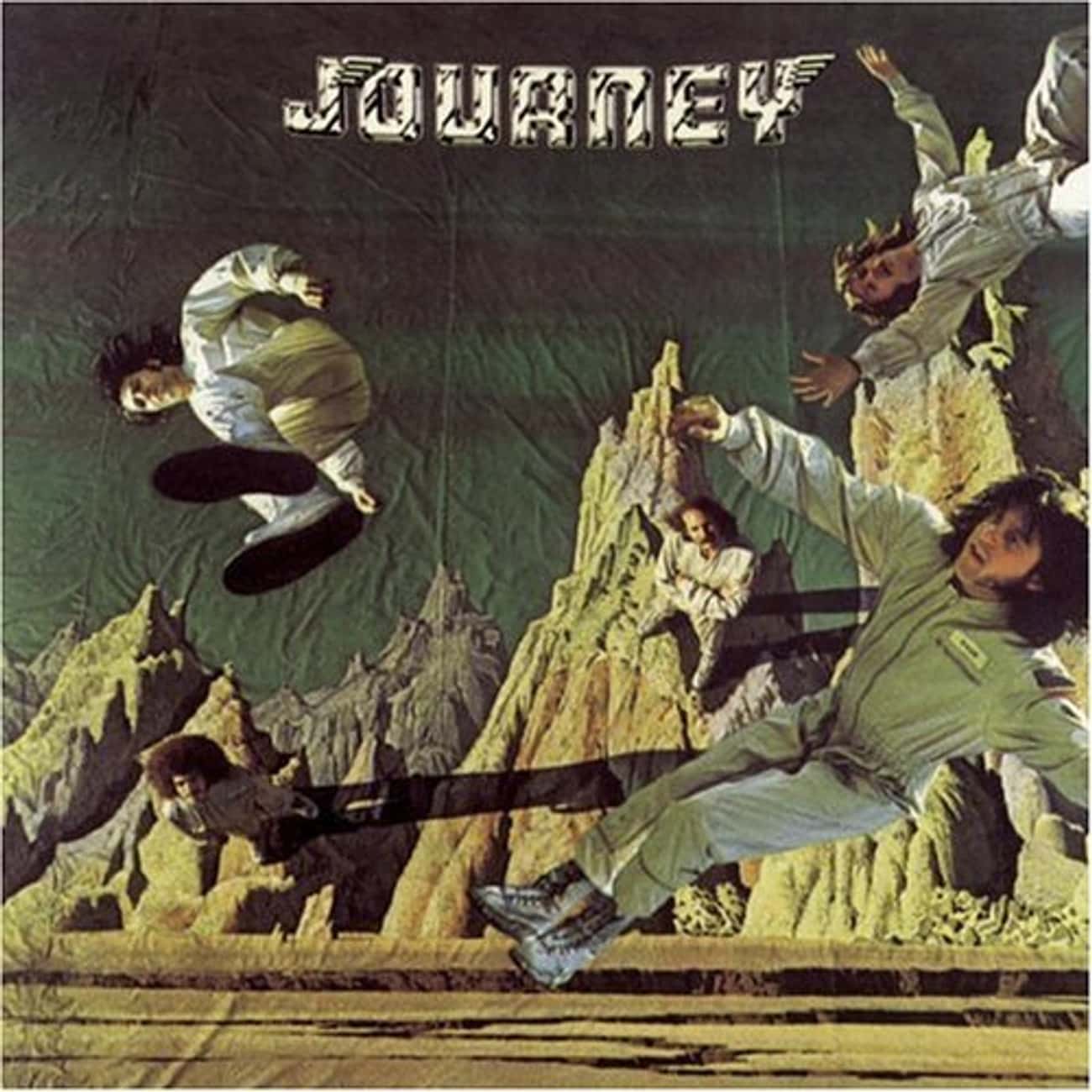
1. Of a Lifetime 2. In the Morning Day 3. Kohoutek 4. To Play Some Music 5. Topaz 6. In My Lonely Feeling/Conversations 7. Mystery Mountain
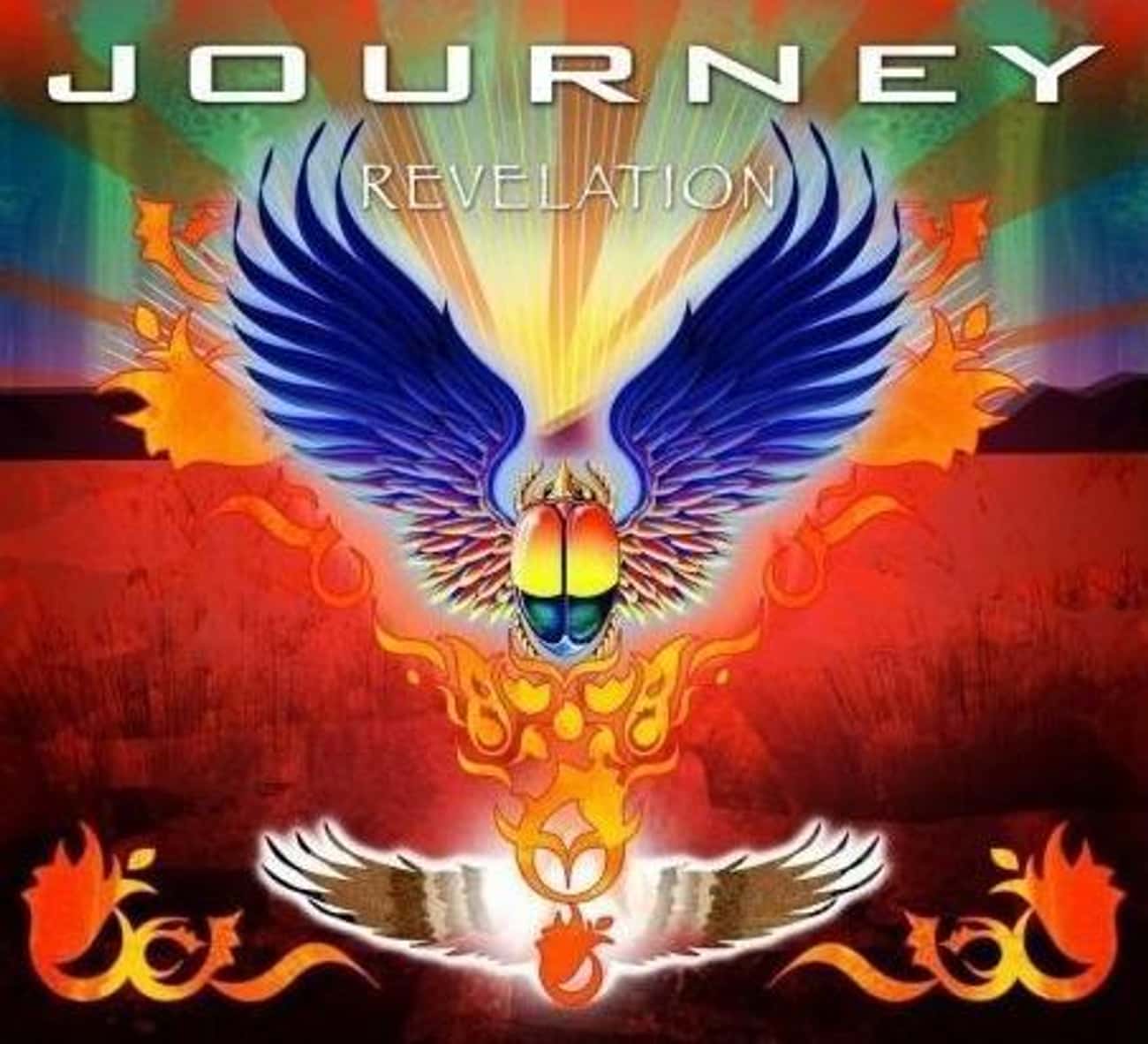
1. Never Walk Away 2. Like a Sunshower 3. Change for the Better 4. Wildest Dream 5. Faith in the Heartland 6. After All These Years 7. Where Did I Lose Your Love 8. What I Needed 9. What It Takes to Win 10. Turn Down the World Tonight 11. The Journey (Revelation) 12. Let It Take You Back 13. The Place in Your Heart
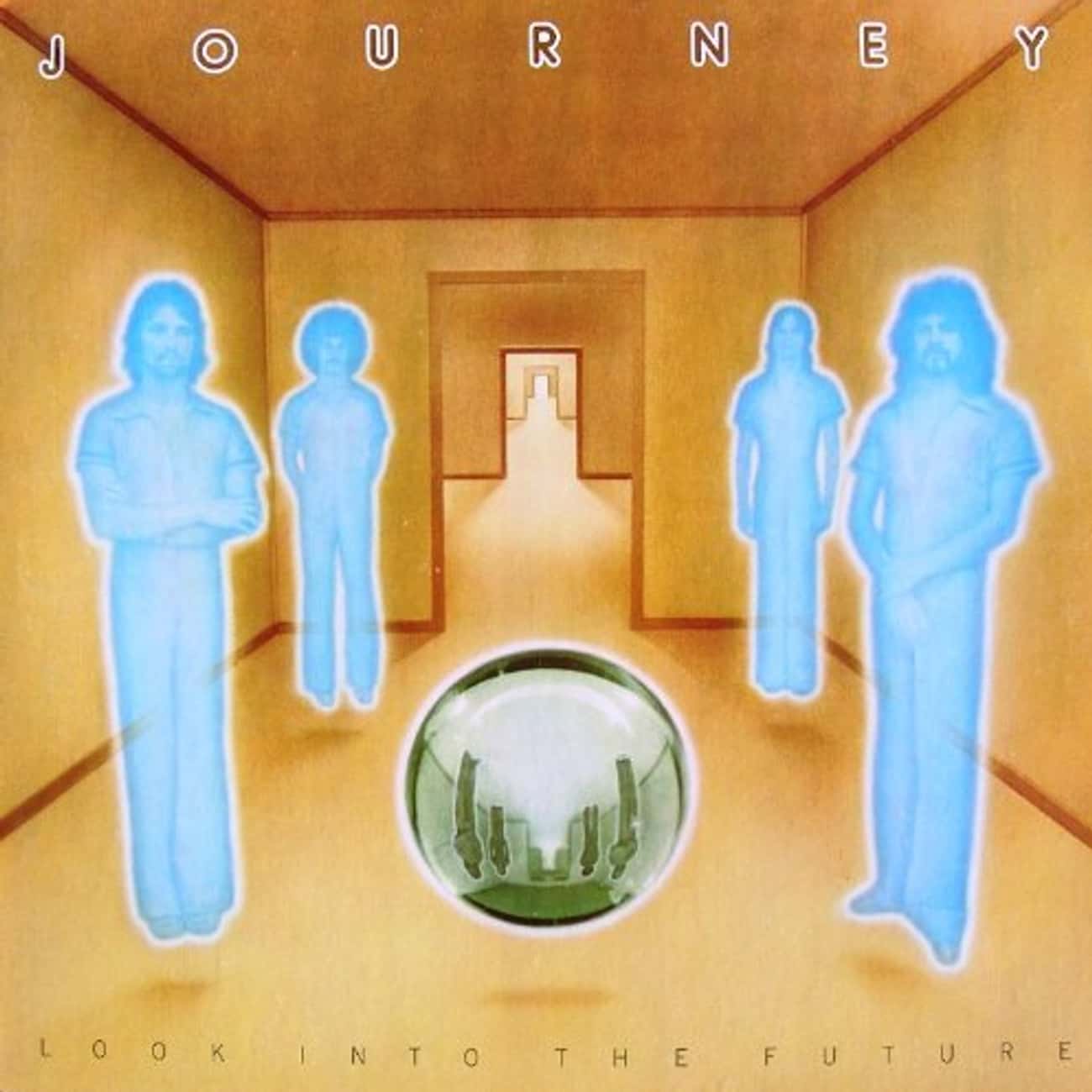
Look Into the Future
1. On a Saturday Nite 2. It's All Too Much 3. Anyway 4. She Makes Me (Feel Alright) 5. You're on Your Own 6. Look into the Future 7. Midnight Dreamer 8. I'm Gonna Leave You

1. City of Hope 2. Edge of the Moment 3. Chain of Love 4. Tantra 5. Anything Is Possible 6. Resonate 7. She's a Mystery 8. Human Feel 9. Ritual 10. To Whom It May Concern 11. Someone 12. Venus

1. Higher Place 2. All the Way 3. Signs of Life 4. All the Things 5. Loved by You 6. Livin' to Do 7. World Gone Wild 8. I Got a Reason 9. With Your Love 10. Lifetime of Dreams 11. Live and Breathe 12. Nothin' Comes Close 13. To Be Alive Again 14. Kiss Me Softly 15. We Will Meet Again
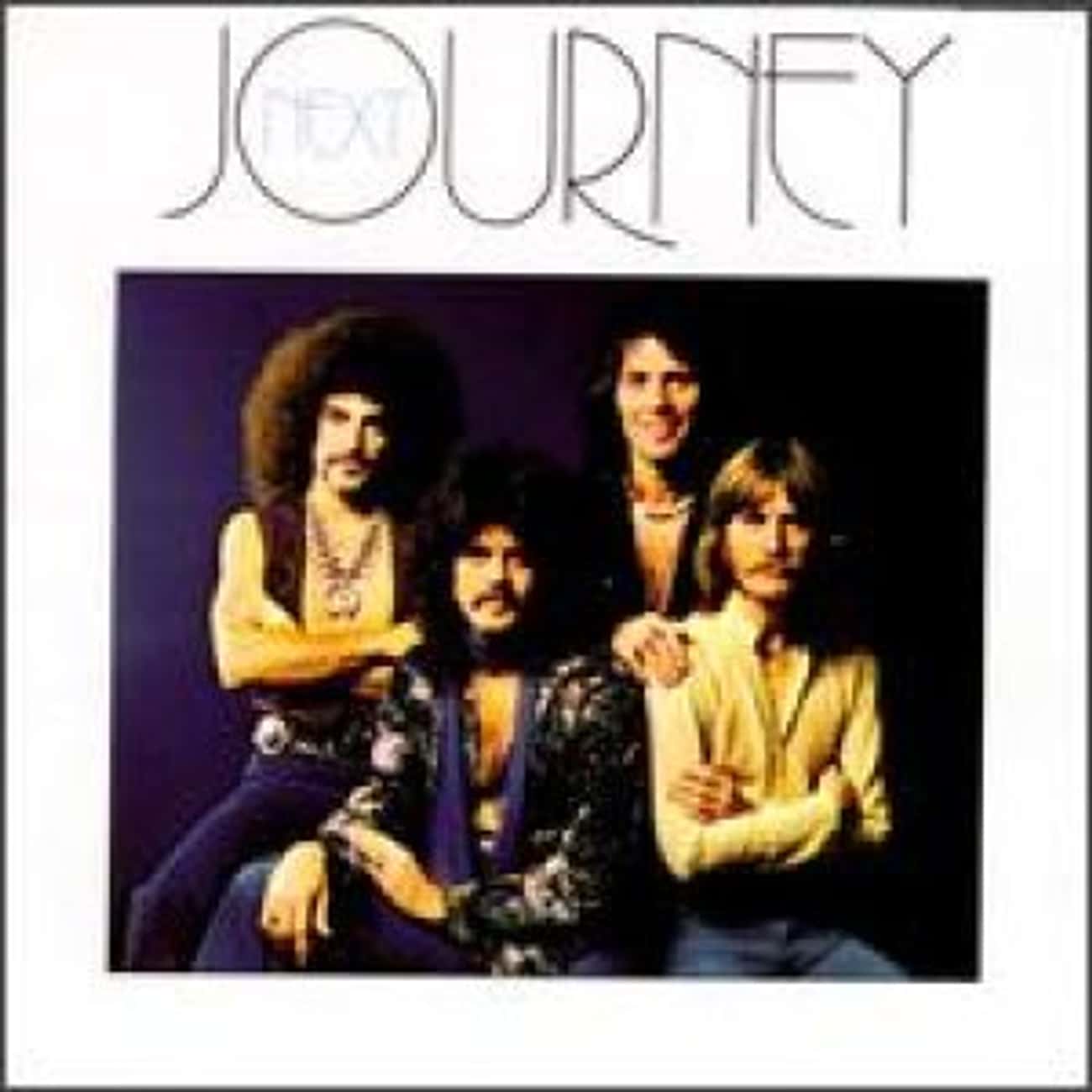
1. Spaceman 2. People 3. I Would Find You 4. Here We Are 5. Hustler 6. Next 7. Nickel and Dime 8. Karma

Generations
1. Faith in the Heartland 2. The Place in Your Heart 3. A Better Life (lead vocal: Castronovo) 4. Every Generation (lead vocal: Cain) 5. Butterfly (She Flies Alone) 6. Believe 7. Knowing That You Love Me 8. Out of Harms Way 9. In Self-Defense (lead vocal: Schon) 10. Better Together 11. Gone Crazy (lead vocal: Valory) 12. Beyond the Clouds 13. Never Too Late (lead vocal: Castronovo) 14. Pride of the Family (lead vocal: Cain)
- Progressive Rock

The cultural relevance and shock value of an album cover can have a significant impact on its reception. Most of them have hidden meanings. Album covers can go down in history as the most creative artwork of all time, thereby leaving a lasting impression on pop culture. However, that doesn’t necessary imply that they were flawless; some of them were simply contentious enough to pique interest and draw attention to the album. Here’s our pick of some of the most iconic album covers of all time!…
Iconic Album Covers of All Time And Their Symbolism
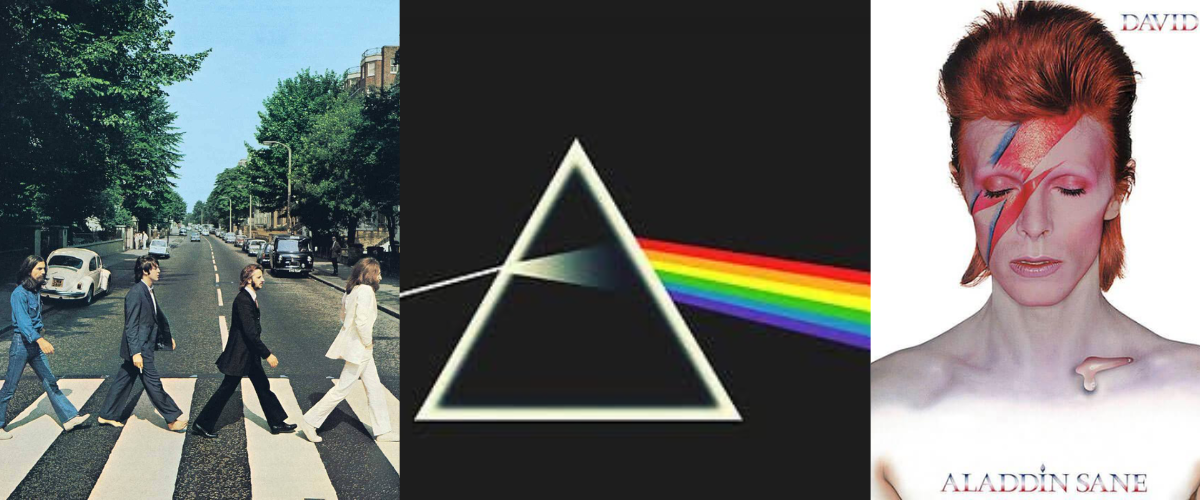
The cultural relevance and shock value of an album cover can have a significant impact on its reception. Most of them have hidden meanings. Album covers can go down in history as the most creative artwork of all time, thereby leaving a lasting impression on pop culture. However, that doesn’t necessary imply that they were flawless; some of them were simply contentious enough to pique interest and draw attention to the album. Here’s our pick of some of the most iconic album covers of all time and their symbolism!
The Beatles, Abbey Road (1969)
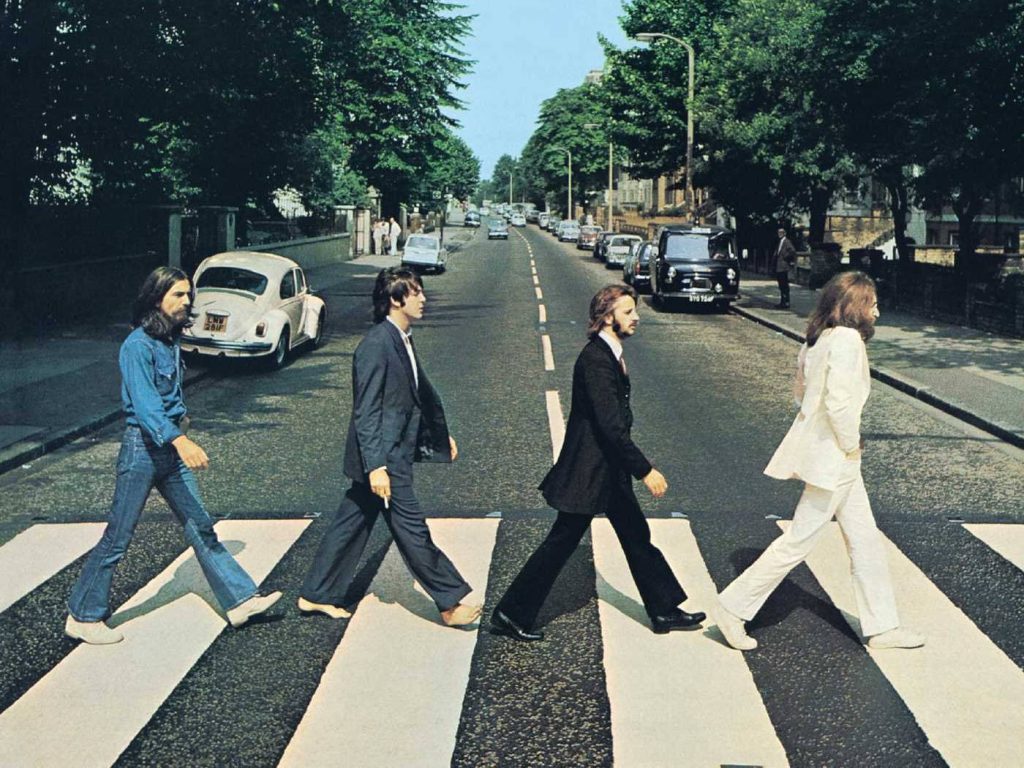
Image Courtesy: Radio X
The iconic cover of The Beatles’ ‘Abbey Road’ album, released in 1969, is steeped in symbolism. The photograph, taken by Iain Macmillan, captures the band members—John Lennon, Paul McCartney, George Harrison, and Ringo Starr crossing the zebra crossing outside Abbey Road Studios. The visual narrative is rife with interpretative possibilities. Some see it as a metaphor for a funeral procession, with McCartney barefoot, symbolizing death; others argue it signifies the Beatles’ symbolic journey and evolution. McCartney’s lack of shoes sparked conspiracy theories, suggesting he had died, fuelling the infamous ‘Paul is dead’ rumours. The simplicity of the image belies its cultural impact, making it one of the most analyzed and imitated album covers in the history of popular music.
The ‘Abbey Road’ album cover’s symbolism extends to the license plate on the white Volkswagen Beetle parked on the left side of the street. The license plate reads ‘LMW 281F,’ and it became a source of speculation and interpretation. Some fans believed that ‘LMW’ stood for “Linda McCartney Weeps,” suggesting a connection to the alleged death of Paul McCartney. However, the license plate was later revealed to have no intentional significance. In reality, the car belonged to an American tourist, and the license plate was simply the registration for the vehicle at the time. Despite the debunking of specific symbolism, the license plate mystery added an extra layer of intrigue to the album cover, contributing to the enduring mystique surrounding Abbey Road.
Pink Floyd, Dark Side Of The Moon (1973)
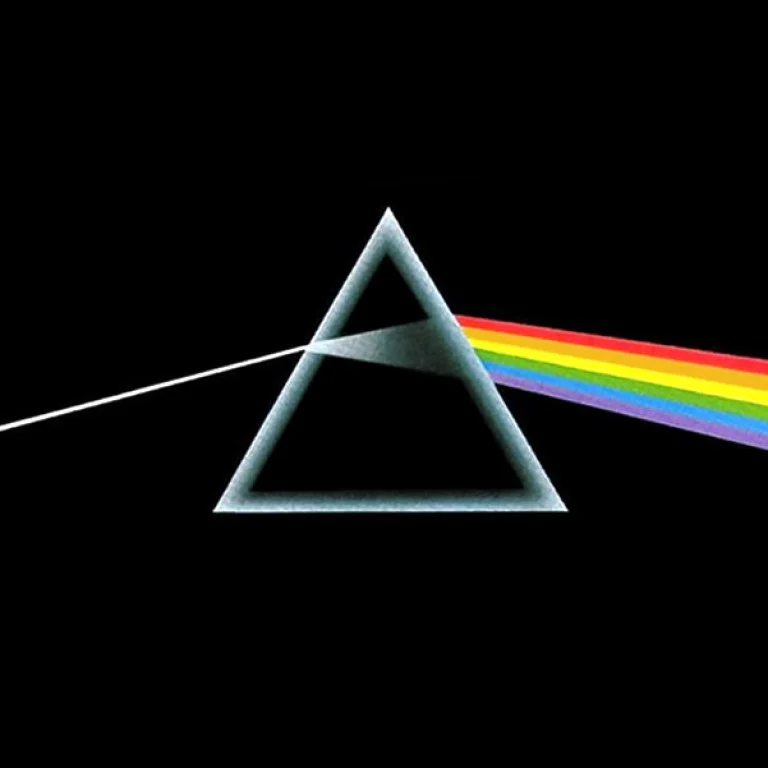
Image Courtesy: South China Morning Post
The album cover of Pink Floyd’s ‘The Dark Side of the Moon,’ released in 1973, is renowned for its profound symbolism and artistic impact. Designed by Storm Thorgerson and Aubrey Powell of the graphic design group Hipgnosis, the cover features a prism refracting light into a spectrum against a black background. This imagery encapsulates the album’s themes of life, death, mental illness and the human experience.
The prism symbolizes the band’s exploration of the spectrum of human emotions and experiences, while the dispersion of light represents the album’s diverse musical styles and thematic range. The absence of a visible horizon on the cover suggests a sense of boundlessness and the cosmic nature of the album’s content.
The choice of a simple and powerful graphic design reflects the band’s desire to convey complex ideas concisely. The triangular prism has become an enduring symbol associated with both Pink Floyd and the album itself, emphasizing the timeless and universal themes explored in ‘The Dark Side of the Moon.’
The Beatles, Sgt. Pepper’s Lonely Hearts Club Band (1967)

Image Courtesy: Amateur Photographer
The album cover of ‘Sgt. Pepper’s Lonely Hearts Club Band,’ released by The Beatles in 1967, is one of the most iconic and elaborate in the history of music. Created by artists Peter Blake and Jann Haworth, the cover is a vibrant collage of images featuring the band members, as well as numerous cultural and historical figures. The symbolism on the cover is rich and diverse, reflecting the album’s themes of nostalgia, experimentation and the transformative power of music. Paul McCartney is credited with having come up with the idea.
The cover includes images of famous personalities, ranging from historical figures like Albert Einstein and Karl Marx to contemporary celebrities like Marilyn Monroe and Bob Dylan. The diverse assembly symbolizes The Beatles’ desire to break away from their pop image and embrace a more eclectic and experimental musical direction.
The background of the cover is filled with an array of symbolic elements, such as flowers, circus imagery, and even a doll wearing a “Welcome The Rolling Stones” sweater. These elements contribute to the album’s overall theme of a colourful and fantastical musical journey.
The uniforms worn by The Beatles on the cover, reminiscent of military outfits, symbolize their transformation into the fictional Sgt. Pepper’s Lonely Hearts Club Band, signalling a departure from their previous personas.
Overall, the album cover of ‘Sgt. Pepper’s Lonely Hearts Club Band’ is a visual feast that encapsulates the spirit of the 1960s counterculture, the band’s artistic evolution, and the album’s revolutionary approach to music.
Fleetwood Mac, Rumours (1977)

Image Courtesy: Discogs
Fleetwood Mac’s best-selling album has a cover featuring only 2 of their band members. Quite odd, isn’t it? Well, here’s the thing..
Fleetwood Mac is infamous for their group dynamic. They dated, butted heads, broke up; ‘Rumours’ is known to be heavily based on that drama. The album cover prominently features Stevie Nicks and Mick Fleetwood while the remaining band members are left out.
Stevie Nicks is posing elegantly, frozen mid-swirl with a shawl flowing behind her while Mick Fleetwood is standing upright with a pair of toilet-chain balls dangling between his legs.
Elvis Presley, Elvis Presley (1956)

Image Courtesy: Retroavangarda
Elvis was aware of what a killer combo green and neon pink were, some 20 years before the Clash copped the cover art for ‘London Calling’. There’s something about that mid-strum snapshot of a vocal howl that always grabs our attention. It graphically introduced rock n’ roll to an unsuspecting America even before the needle hit the vinyl. This record introduced Elvis to the whole world and has some considerable cachet, since it’s the oldest on the list.
Elvis has long been recognised as a legendary household name. He was performing at the Fort Homer Hesterly Armory in Florida in 1955, when this photo was taken. The black and white action shot contrasted with the bright pop of the huge typography is striking and unique. This is one of those timeless albums that will be remembered forever due to the album’s content and the album cover itself.
It reflects the exuberance and charisma of the young rock and roll icon. The symbolism on the album cover is more straightforward compared to some later covers but still encapsulates the spirit of the time and Presley’s impact on the music scene.
David Bowie, Aladdin Sane (1973)

David Bowie’s ‘Aladdin Sane’ album cover, released in 1973, is an iconic image that builds on the persona he established with ‘Ziggy Stardust’. Bowie, who belongs to the specialised genre of ‘glam rock,’ is renowned for his eccentric sense of style and charisma on stage. Although this wasn’t the album that first made Bowie’s spaceman alter ego known to the world, when music lovers think of Ziggy Stardust, this is what they picture. This is classic Bowie, complete with red mullet and lightning-bolt eye makeup.
The cover features Bowie with his face painted in a bold lightning bolt design, emphasizing the album’s title, a play on the words ‘A Lad Insane.’ The symbolism on the cover is layered and reflects Bowie’s artistic and conceptual approach.
The lightning bolt across Bowie’s face has been interpreted in various ways. It can be seen as a symbol of the fractured or divided self, representing the duality of sanity and insanity. The lightning bolt also suggests a sense of energy, rebellion, and a break from convention, aligning with Bowie’s avant-garde and experimental approach to music and fashion.
Bowie’s androgynous appearance on the cover challenges traditional gender norms, underscoring his role as a cultural chameleon and a pioneer in pushing boundaries. The stylized haircut and futuristic aesthetic contribute to the overall sense of otherworldliness and reinvention.
In summary, the ‘Aladdin Sane’ album cover symbolizes David Bowie’s commitment to artistic reinvention, the exploration of identity, and the blending of various musical influences. The lightning bolt face paint has become an enduring symbol associated with Bowie’s legacy and his impact on the evolution of rock and pop culture.
Prince, Purple Rain (1984)
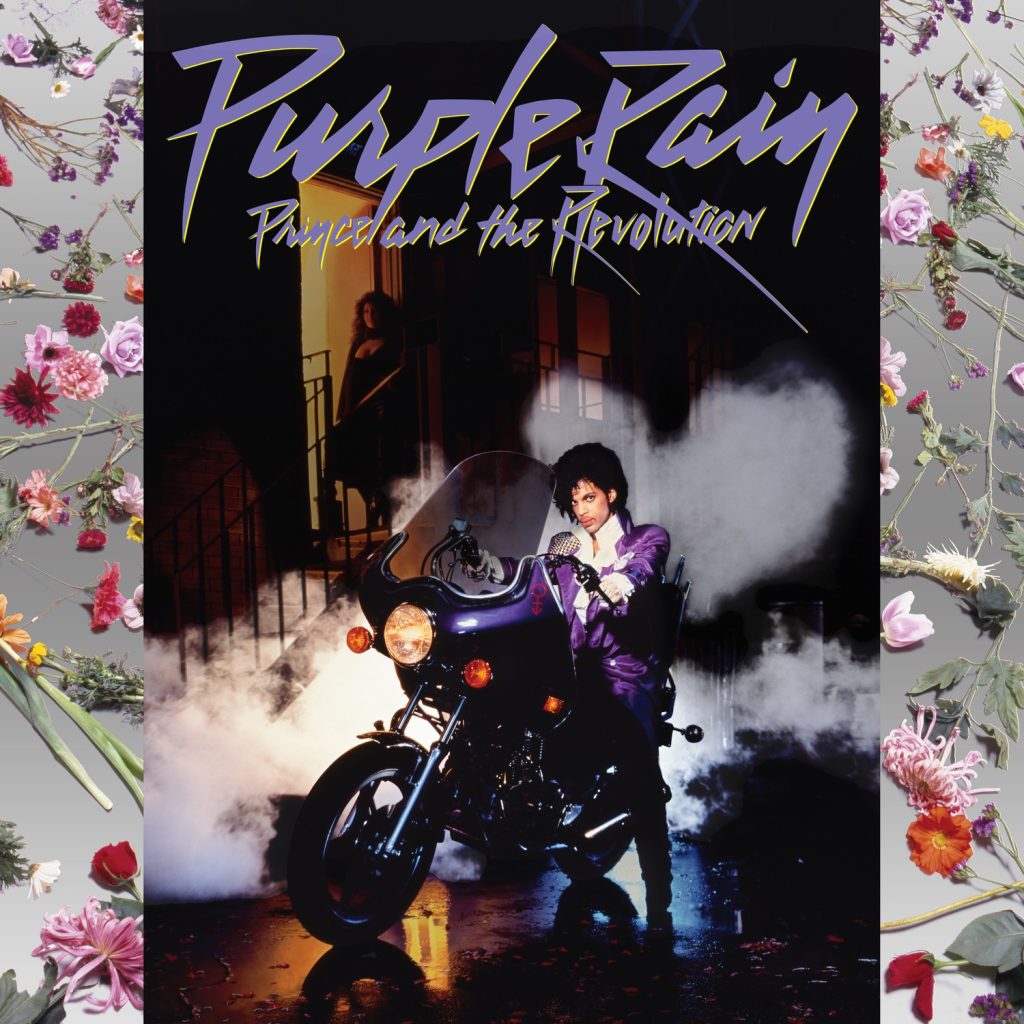
Image Courtesy: BestSellingAlbums.org
Another excellent cover that has become ingrained in pop culture. Who could ever forget this picture of Prince posing on a motorcycle while wearing a purple suit? Prince’s album, ‘Purple Rain’ catapulted him to the top of the charts in the summer of 1984. The music video, cover art and album, all became overnight successes. This cover image was photographed at the Warner Bros studio in California, and the background was purposefully made to resemble a New York City tenement. It’s a perfect sneak peek into what the now-famous music video would look like.
The colour purple, a recurring theme throughout Prince’s career, represents creativity, royalty and spirituality. In the context of ‘Purple Rain,’ it can be seen as a symbol of the emotional and creative intensity expressed in the music. Purple is also associated with mysticism and a sense of otherworldliness, aligning with Prince’s unique and genre-defying approach to music.
Joy Division, Unknown Pleasures (1979)

Image Courtesy: TypeRoom
The cover of Joy Division’s ‘Unknown Pleasures,’ released in 1979, has become one of the most iconic and recognizable album covers in the history of music. The cover art features a series of white lines against a black background, forming a series of pulses or waves. The design is based on a visual representation of radio waves from a pulsar, a type of rotating neutron star.
The image was sourced from ‘The Cambridge Encyclopaedia of Astronomy’ and chosen by Joy Division’s graphic designer, Peter Saville. The choice of this enigmatic and scientific image reflects the band’s interest in unconventional and intellectual aesthetics, and it aligns with the post-punk and avant-garde nature of their music.
The pulses on the cover symbolize the rhythm and pulsating energy found in Joy Division’s music. The stark black-and-white design creates a sense of stark minimalism, contributing to the overall mood of the album. The cover’s simplicity and ambiguity have allowed for various interpretations over the years, adding to its enduring appeal.
This record has left a lasting impression in the world of music. Even Mickey Mouse was featured in a parody of this album’s cover art made by Disney.
Bruce Springsteen, Born In The U.S.A. (1984)

Image Courtesy: Genius
This iconic album cover sums up Springsteen’s persona perfectly. There’s the American flag backdrop, the worn-in jeans, the white T-shirt, and the red hat hanging out of his back pocket after a long day at work. The Boss represents blue-collar America in all its glory. The cover perfectly encapsulates country music at the time. Springsteen is the quintessential American boy, as the album’s title clearly demonstrates.
Pink Floyd, Wish You Were Here (1975)

Image Courtesy: Medium
Pink Floyd was known for their album art. The shot was taken by Aubrey ‘Po’ Powell, and the handshake on the cover was intended to symbolize meaningless gestures. In the snapshot, one man is on fire while the other, who is clad in a business suit, is shaking his hand nonchalantly. There are various possible meanings, but many believe it alludes to the notion that people usually conceal their true emotions for other people and that this gesture is typically made in a half-hearted, empty manner.
Here’s another interpretation. The handshake is a symbol of the business deals and agreements within the music industry. However, one of the hands being on fire suggests the destructive and negative consequences of these transactions. The flames can be seen as a metaphor for the emotional and creative toll that the industry can take on artists.
The title of the album, ‘Wish You Were Here,’ suggests a sense of absence and loss. This sentiment is reinforced by the imagery of the burning man, which represents a missing presence. The album was written during a period when the band members were grappling with the absence of their former bandmate Syd Barrett, who had left the band due to mental health issues.
The album cover symbolizes the emotional toll of the music industry, the absence of Syd Barrett, and the longing for genuine connection. The burning man and the handshake imagery create a powerful and evocative visual representation of the album’s themes.
The Velvet Underground and Nico, The Velvet Underground and Nico (1967)

Image Courtesy: Billboard
The album cover of ‘The Velvet Underground and Nico,’ released in 1967, is as influential and enigmatic as the music it contains. The cover features a banana illustration designed by Andy Warhol, who also produced the album. Some might claim that this album cover has gained more recognition than the album itself. The symbolism on the cover is rich and multifaceted.
The most prominent element is the banana, which is not just a decorative choice but also serves as a peel-off sticker. When peeled, it reveals a flesh-coloured banana underneath. This interactive aspect of the cover design adds a layer of playfulness and subversion, reflecting the avant-garde and experimental nature of both Warhol’s art and The Velvet Underground’s music.
The banana has been interpreted in various ways, including as a phallic symbol or as a commentary on consumerism. The fact that it can be peeled suggests a level of engagement and participation, inviting the listener to interact with the cover and uncover a hidden layer, possibly alluding to the uncovering of deeper meanings within the music itself.
The association with Andy Warhol, a leading figure in the pop art movement, adds an element of artistic collaboration and blurring of boundaries between visual art and music. Warhol’s involvement with the band also contributed to their association with the avant-garde and the art scene of the 1960s.
The cover design, with its simple yet provocative imagery, has become an iconic symbol of the counterculture and the experimental spirit of the time. The album itself, with its unconventional and groundbreaking sound, is often regarded as a seminal work that pushed the boundaries of rock music.
–Silviya.Y

- Best albums
- Your feedback
The best album credited to Journey is Escape which is ranked number 1,772 in the overall greatest album chart with a total rank score of 951.
Journey is ranked number 761 in the overall artist rankings with a total rank score of 2,202.
- Members: N.B. The member list may not contain a full list of members (and there may be notable omissions). If a member has never released a solo album, or their solo albums do not appear on BEA, they will not be able to be listed as a member. These omissions are not meant to cause offense to anybody. The member list is solely meant as an additional navigation aid to browse between the items listed on the site.
- Steve Perry
- Aynsley Dunbar
- Robert Fleischman
- Schon & Hammer
- Abraxas Pool
- John Mayall & The Bluesbreakers
- The Jeff Beck Group
- Jefferson Starship
- The Aynsley Dunbar Retaliation
- Mother's Army
- Soul Sirkus


Upcoming concerts

Listen to Journey on YouTube
Journey best albums.
The following albums by Journey are ranked highest in the greatest album charts:

- « prev
- next »
This may not be a complete discography for Journey.This listing only shows those albums by this artist that appear in at least one chart on this site. If an album is 'missing' that you think deserves to be here, you can include it in your own chart from the My Charts page!
Journey bestography composition
Journey best tracks.
Include tracks from compilations & live albums | Exclude tracks from compilations & live albums The same track can appear on multiple albums, so excluding tracks from compilations and live albums helps to remove duplicates from this list.
- Related links:
- Top tracks of all time
Journey ratings

Showing latest 5 ratings for this artist. | Show all 51 ratings for this artist.

Rating metrics: Outliers can be removed when calculating a mean average to dampen the effects of ratings outside the normal distribution. This figure is provided as the trimmed mean. A high standard deviation can be legitimate, but can sometimes indicate 'gaming' is occurring. Consider a simplified example* of an item receiving ratings of 100, 50, & 0. The mean average rating would be 50. However, ratings of 55, 50 & 45 could also result in the same average. The second average might be more trusted because there is more consensus around a particular rating (a lower deviation). (*In practice, some artists can have several thousand ratings) This artist has a Bayesian average rating of 66.4/100, a mean average of 64.7/100, and a trimmed mean (excluding outliers) of 64.7/100. The standard deviation for this artist is 23.5.
- Top artists of all time
Please log in or register if you want to be able to leave a rating
Journey favourites
Showing all 6 members who have added this artist as a favourite
Journey comments
Showing all 7 comments | Most Helpful First | Newest First | Maximum Rated First | Longest Comments First (Only showing comments with -2 votes or higher. You can alter this threshold from your profile page. Manage Profile )
Shockingly underrated on this site. Few bands come to mind before these guys when I think of classic, good time rock 'n' roll. Obviously they're a hits band, and Don't Stop Believin' is incredibly overplayed, but, man do they have some good hits: Any Way You Want It, Separate Ways, Lovin' Touchin' Squeezin', Open Arms, Faithfully, Who's Crying Now, Wheel in the Sky, Stone in Love, Lights... the list goes on. This site is doing these guys pretty dirty.
I hate Glee for causing Don't Stop Believing to be the sing-along of choice for high school girls everywhere.
This comment is beneath your viewing threshold.
Hard to believe that this band was unnoticed without Perry. Great voice, and plenty of great songs. On a strange side note, Journey's beetle is the only beetle I will ever like looking at. I once saw this hug inch long beetle with a loud buzz. I couldn't kill it. I wanted to, but I didn't want to hear the crunch. For years, I hated even looking at beetle pictures. Journey got me out of that with there awesomeness.
A good "hits" band
ESCAPE was definitely the best album. I actually preferred the second side (remember when albums had sides?). "Escape," "Lay it Down," "Dead or Alive," and "Mother, Father" were some of their strongest tunes and I definitely preferred them over the "Open Arms" sap. For a real treat, definitely check out Journey's first three albums. Incredible stuff that receives, virtually, no airplay these days.
My favorite band of all time
Please log in or register if you want to be able to add a comment
Your feedback for Journey

Artists - A-H
- & Young
- .38 Special
- Aaron Lewis
- Aaron Neville
Artists - I-P
- Iron Butterfly
- Iron Maiden
- Izzy Stradlin
Artists - Q-Z
- Queens of the Stone Age
- Queensrÿche
- Classic Rock

- Keyboardist Jim Beard, Known for His...
- 12 Rock Legends Who Openly Dislike...
- 10 Rock Stars Who Can’t Stand...

- Legendary Motorhead Frontman, Lemmy, To Be...
- Happy 76th Birthday Tony Iommi: How...
- Metallica Secures Best Metal Performance at...

- Unveiling Stevie Ray Vaughan’s Top 10...
- Album Review: “Two Steps From The...
- The Facts In The Early Life...
Journey Have Revealed The True Meaning Behind Their Hit “Faithfully,” And It’s Not What You’d Expect!
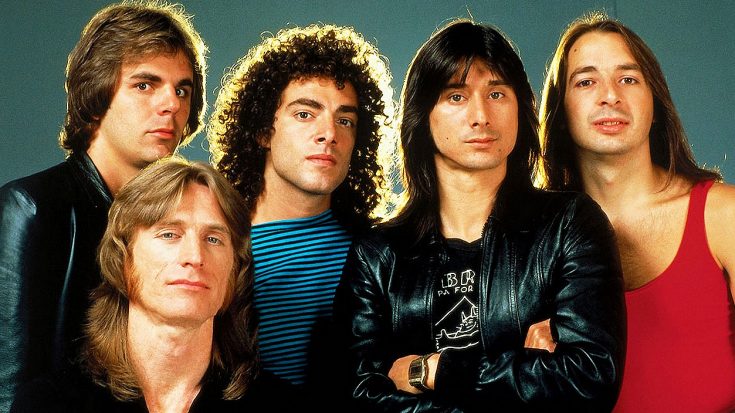
Image via vignette2.wikia.nocookie.net
I’m forever yours…
Back in 1983, Journey released one of their most popular, and emotional songs to date: “Faithfully.” The song is a power ballad that is commonly played as a slow dance song at weddings, proms and other celebrations. It showcases lead vocalist Steve Perry’s amazing voice, and is one of the band’s best songs!
Not many people know the true meaning of this classic tune. The song is a love song, and most people think that it’s about a guy who is just expressing his love to a woman he loves. This is true, however songwriter and keyboardist Jonathan Cain revealed the true meaning behind this amazing song!
Cain wrote this song about the challenges of being a married man on the road in a rock band. He said: “God gave me that song. I started it on the bus heading to Saratoga Springs. I woke up the next day with a napkin on the side of my nightstand and I looked at the lyrics, ‘Highway run into the midnight sun.’ Then I got this supernatural download: This is the rest of the song. I wrote rest of it down, almost frantically. I’d never had a song come to me so quickly that it was anointed, supernatural. Literally, in 30 minutes I had written that song. I had the napkin in my pocket and I put it on the piano. I had a big grand piano there by the orchestra. I played through it and I thought, ‘Man, this is good.’ The Lord gave me permission to finish it. Normally I would go to Steve Perry or somebody and say, ‘Help me finish this song.’ No. God gave me the mind to finish it, and the rest is history. That would be a love song to God, absolutely.”
That’s a pretty inspiring story of how this wonderful song was written! I bet you’ll never listen to it the same way again! Check out the song down below and enjoy!
Don’t Miss Out! Sign up for the Latest Updates
- Music Video
I Love Classic Rock
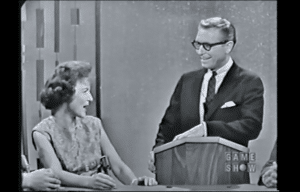
10 60s TV Game Shows That Were Ahead of Their Time
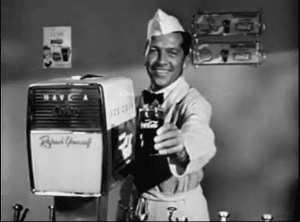
10 60s Ad Campaigns That Changed Marketing
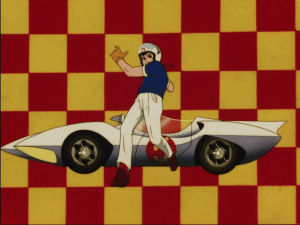
10 60s Cartoons That Are Timeless
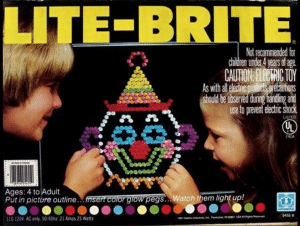
10 60s Toys That Kids Today Would Love
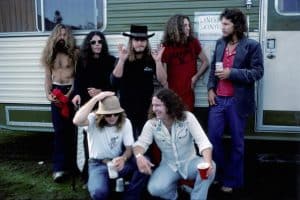
How Lynyrd Skynyrd Got Scared Of Success

Jon Bon Jovi Reveals The Last Song He Would Sing At His End…
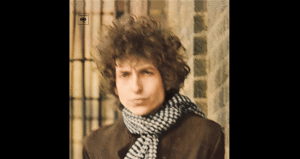
The Reason Why The Bob Dylan Biopic Is Called ‘A Complete…
Premium partners.

Interested in becoming a partner?
Contact us for more info.

© 2024 Society Of Rock
- Terms of Use
- Privacy Policy

- Latest News
‘Kimono My House’: The Story Behind Sparks’ Daring Breakthrough Album
‘fly like an eagle’: when steve miller band took flight, best protest songs in history: 20 timeless political anthems, ‘le parc’: tangerine dream at their most soulful and evocative, ‘(is this the way to) amarillo’: comic relief takes tony christie back to texas, ‘tangram’: tangerine dream’s multi-movement opus, little walter: the true king of blues harp, stephen sanchez announces global world tour, tyler hubbard preps his ‘strong’ world tour, all seasons of ‘reba’ set to debut on netflix, billie eilish announces ‘hit me hard and soft’ world tour, blink-182 returns to north america for final leg of stadium and arena tour, terri clark reimagines ‘now that i found you’ as duet with ben rector, luis fonsi shares new laura pausini collaboration ‘roma’, the beatles album covers explained.
From the psychedelic nostalgia of Sgt. Pepper’s Lonely Hearts Club Band to the simplicity of crossing Abbey Road, these are the stories behind the cover of every Beatles album.
Published on
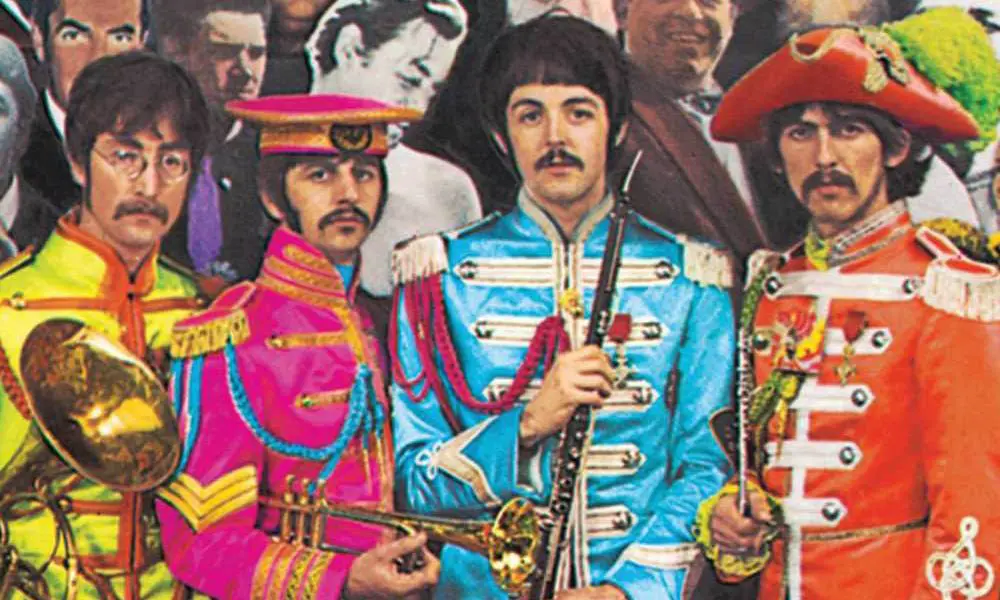
From the very beginning, a big part of The Beatles appeal was visual. In his book The Art of The Beatles , Mike Evans explained, “their image was always unique. Unlike their contemporaries on the music scene, whose style reflected the times, The Beatles invariably helped to establish fashion.” From their pre-fame days, they always had a look – uniform, in every sense. When they first emerged, the press was obsessed with their mop-top haircuts, their matching Cuban-heeled boots, their collarless jackets. How they presented themselves was vital to what made them so… different. And nowhere was this reflected more consistently than on their record covers. Photography, illustration, graphic design – Beatles album covers changed them all.
Before The Beatles, album art was designed to sell the contents – song titles and sales messages on top of the artist’s bright image. But within a few short years, The Beatles album covers were works of art in their own right. Images such as the half-lit heads on With The Beatles , the psychedelic nostalgia of Sgt. Pepper’s Lonely Hearts Club Band , and the simplicity of crossing Abbey Road rank as some of the most influential and enduring art of the 20th century, clearing the way for others like The Rolling Stones, David Bowie, Pink Floyd, and countless others to go even further.
Here are the stories behind some of The Beatles’ iconic album covers.
‘Red Rose Speedway’: Paul McCartney And Wings At Full Throttle
Looking to build your record collection with vinyl from The Beatles? The Sound Of Vinyl is offering a special discount for all readers that click this link .
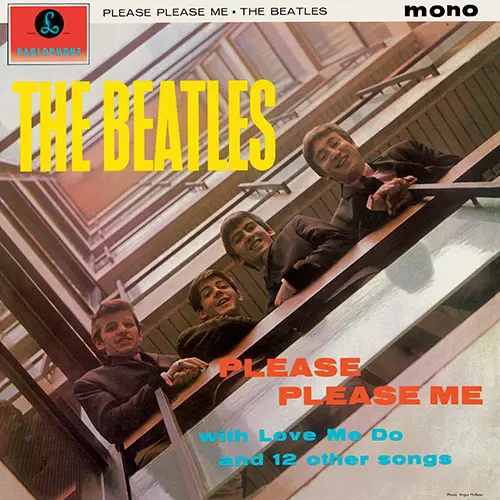
The Beatles – Please Please Me
(1963, cover art photograph by angus mcbean).
The album cover photo introducing The Beatles’ 1963 debut album Please Please Me was shot by Angus McBean. George Martin made the decision. At the time, as well as being the group’s record producer, he was also the head of Parlophone Records. (Martin and McBean had previously already worked on several comedy record covers.) The photo shoot was initially planned for outside the insect house at the London Zoo. The zoo rejected the idea and, eventually, the location of EMI House in London’s Manchester Square was chosen, with a shoot arranged for March 5, 1963. That same day, the group recorded “From Me to You.”
“It was done in an almighty rush, like the music,” recalled Martin. The shot that graced the cover art features the fresh-faced Fab Four grinning down at McBean from a balcony several floors above the lensman: “I only had my ordinary portrait lens, so to get the picture, I had to lie flat on my back in the entrance. I took some shots, and I said, ‘That’ll do.’”
Listen to Please Please Me here .
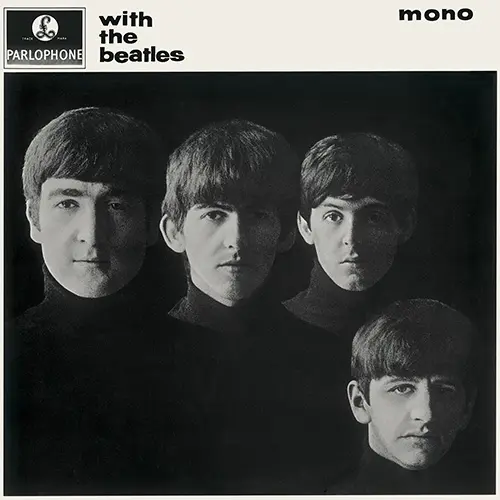
The Beatles – With the Beatles
(1963, cover art photograph by robert freeman).
While their first LP was rushed out to capitalize on their initial success, by the time of their follow up, With The Beatles , released on November 22, 1963 (a date that goes down in American history for another reason), it was becoming clear that The Fab Four were no flash-in-the-pan.
Taking inspiration from photos by their friend Astrid Kirchherr, Robert Freeman shot the album cover not in a studio, but the corridor of the Palace Court Hotel, Bournemouth, while The Beatles were on tour. As Paul McCartney recalled, the shoot on August 22, 1963 was “One hour in a hotel. [Freeman] found the end of a corridor, a little window where natural light spilled in at about 11 o’clock. And he just sat us, ‘You sit in front, there…’” The result is a truly iconic image; four young men in matching haircuts and polo-necks, half-lit in black and white, and unsmiling – itself a considerable departure for a pop act. As George Harrison said, “That cover was the beginning of us being actively involved in The Beatles’ artwork.”
Listen to With the Beatles here .
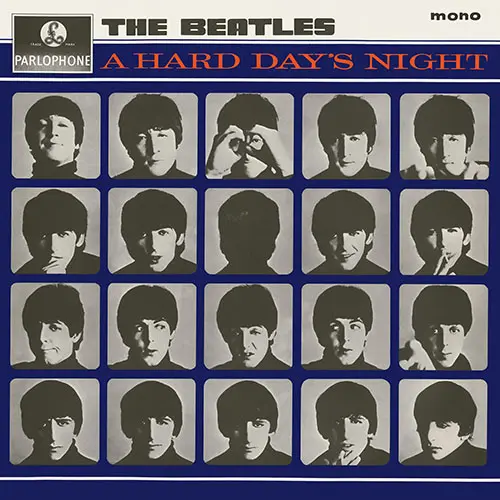
The Beatles – A Hard Day’s Night
(1964, cover art photograph by robert freeman).
As with their previous LP, the cover art for 1964’s A Hard Day’s Night (the accompanying album to The Beatles’ first feature film) consists of black and white portraits of each Beatle in matching polo necks and haircuts. Only now they are playing up to the camera, each pulling a series of faces. The 20 portraits (including one of the back of George’s head) were again taken by Robert Freeman, but this time, the shoot took place in the photographer’s London studio.
By now, The Fab Four had become friends with Freeman – he and Lennon lived in the same apartment block. Freeman reflected on that period, commenting, “Being with The Beatles was being in the center of crazy activity, the eye of a hurricane… It was an altogether lively and amusing time.” Designed to look like reels of film, the sleeve design nods to the scene where the individual band members are bombarded by journalists’ questions and photographers’ flashes.
Listen to A Hard Day’s Night here .
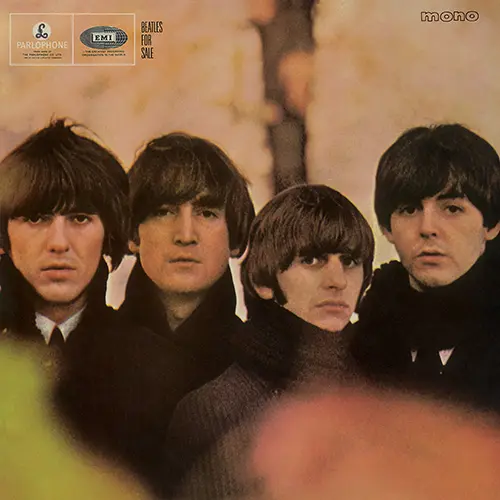
The Beatles – Beatles For Sale
Photographed by Robert Freeman in Hyde Park, London, October 1964, the Beatles For Sale album cover shot presents a weary-looking rock ‘n’ roll band, devoid of smiles, and – again – almost identically attired. “The photographer would always be able to say to us, ‘Just show up,’ because we all wore the same kind of gear all the time,” recalled Paul McCartney. “It was easy. We showed up in Hyde Park by the Albert Memorial. I was quite impressed by George’s hair there. He managed to create his little turnip top.”
This was their first gatefold sleeve, and inside is another Freeman portrait, this time of the four Beatles posing in front of a collage of idols from Hollywood and music hall, such as Jayne Mansfield and Victor Mature – a concept they would return to three years later for Sgt. Pepper’s Lonely Hearts Club Band . In his sleeve notes, Derek Taylor wrote “The kids of AD 2000 will draw from the music much the same sense of well-being and warmth as we do today.” And then some, Derek.
Listen to Beatles For Sale here .

The Beatles – Help!
(1965, cover art photograph by robert freeman).
Released to accompany their second motion picture, 1965’s Help! album sleeve shows the Liverpool band reprising their snowsuit outfits from the movie, and seemingly sending a distress signal in semaphore. While photographer Robert Freeman had initially planned to shoot the boys flagging the letters H-E-L-P, he ultimately abandoned this plan, instead preferring an arrangement that worked well graphically. The final album cover actually spells out N-U-J-V (or possibly C).
By 1965, Freeman had become the de facto Beatles official photographer, shooting five of their album covers, as well as a number of their best-loved photo sessions during the Beatlemania years. On his death in November 2019, Paul McCartney said: “He was one of our favourite photographers during The Beatles years, who came up with some of our most iconic album covers. Besides being a great professional, he was imaginative and a true original thinker.”
Listen to Help! here .
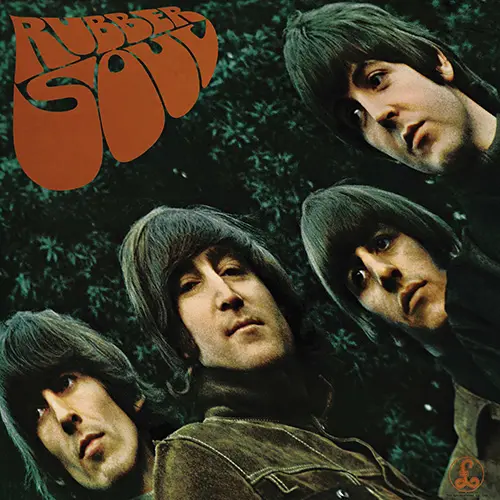
The Beatles – Rubber Soul
The Beatles’ second album of 1965 was their biggest departure to date music-wise, with songs like “Nowhere Man” and “Norwegian Wood.” The cover art reflected that experimentation. For starters, the album art didn’t feature the band’s name, just their four faces, peering distorted at the listener beneath the title, Rubber Soul . “It was Paul’s title,” John Lennon said. “It was like ‘Yer Blues’, I suppose, meaning English soul, ‘Rubber soul’. Just a pun.” The typography was, as with so many Beatles things, just ahead of its time; within a year, that style would be de rigueur on psychedelic poster art.
The stretched effect came about purely by accident. “The photographer Robert Freeman had taken some pictures round at John’s house in Weybridge,” Paul McCartney explained. Back in London, Freeman presented the pictures projected onto an album-sized piece of card. “We had just chosen the photograph when the card that the picture was projected onto fell backwards a little, elongating the photograph. It was stretched and we went, ‘That’s it, Rubber So-o-oul, hey hey! Can you do it like that?’ And he said, ‘Well, yeah. I can print it that way.’ And that was it.”
Listen to Rubber Soul here .
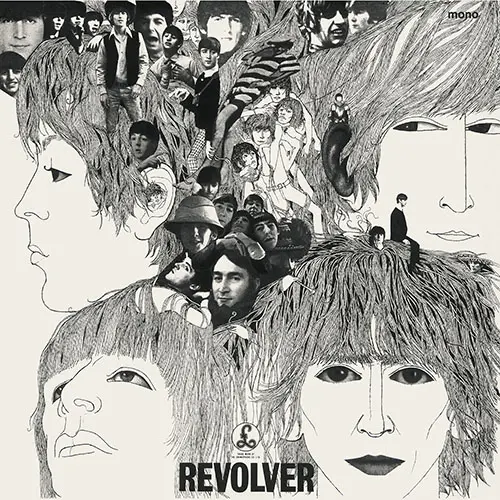
The Beatles – Revolver
(1966, illustrated by klaus voormann).
Having designed The Beatles’ previous five vinyl record covers, Robert Freeman had created a proposed photo collage design for 1966’s Revolver . However, this was rejected in favor of an illustration by an old friend from Hamburg, Klaus Voormann. Perhaps inspired by illustrator Aubrey Beardsley, an exhibition of whose line drawings had drawn huge crowds to London’s V&A Museum in the summer of 1966 (Beardsley would appear on the cover of Sgt. Pepper’s Lonely Hearts Club Band ), the album cover featured line drawings of The Beatles alongside cut-up photos.
Voormann told Mojo ’s Martin O’Gorman: “Because they were being so avant-garde, I thought the cover has to do the same thing. I wanted to push the design further than normal.” When Voormann presented his finished cover art to The Fab Four, along with producer George Martin and manager Brian Epstein, he was at first met with silence. But it soon became clear that they loved it. Epstein told Voormann: “Klaus, this is exactly what we needed. I was worried that this whole thing might not work, but now I know that this cover, this LP, will work – thank you.”
Listen to Revolver here .
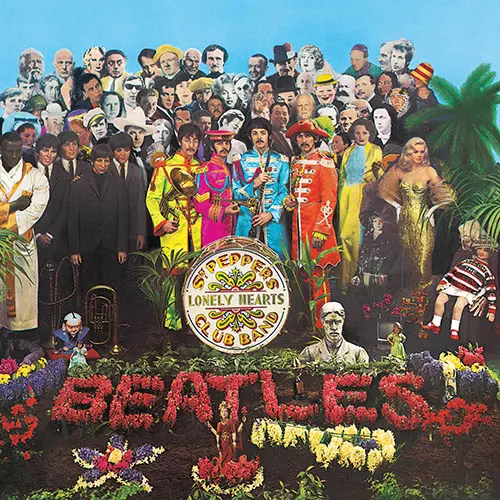
The Beatles – Sgt. Pepper’s Lonely Hearts Club Band
(1967, designed by peter blake and jann haworth; cover art photograph by michael cooper).
Sgt. Pepper’s Lonely Hearts Club Band in 1967 was perhaps more nostalgic than psychedelic, as the uniformed Beatles fronted a montage of over 60 life-size photographs representing friends, heroes, and icons, alongside waxworks of their Mop Top selves. “We wanted the whole of Pepper to be so that you could look at the front cover for years,” Paul McCartney explained, “and study all those people and read all the words on the back.”
The Beatles called upon artist Peter Blake and Jann Haworth to pull it all together. The most celebrated album cover ever made was a revolution in design, and saw the packaging itself raised up to the level of art; specifically pop art. As Ringo Starr remembered, “ Sgt. Pepper was a special album, so when the time came for the sleeve we wanted to dress up, and we wanted to be these people, all the ‘Peppers’. It was Flower Power coming into its fullest. It was love and peace; it was a fabulous period, for me and the world.”
Listen to Sgt. Pepper’s Lonely Hearts Club Band here .
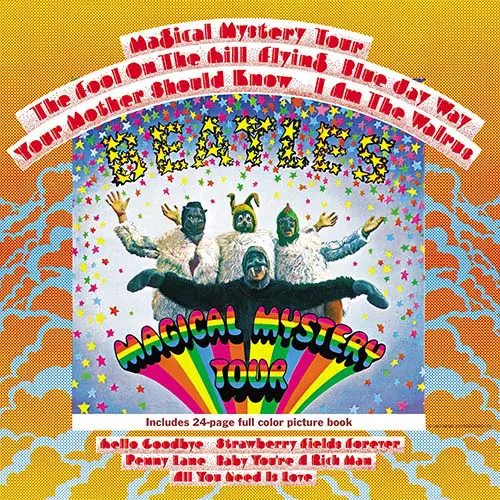
The Beatles – Magical Mystery Tour
(1967, designed by john van hamersveld).
Although not originally released as an LP in the UK, where instead a double EP plus booklet accompanied the made-for-TV movie, the 1967 US Magical Mystery Tour album has become the only US release to have become a de facto part of their catalog. The cover art shows the group in their I Am the Walrus outfits from the film (in which, contrary to what John Lennon wrote in “Glass Onion,” the Walrus was John; Paul was the hippo). It was the first album cover by The Beatles where the group member’s faces didn’t appear at all.
For the song “I Am the Walrus,” John had taken his inspiration from Lewis Carroll’s poem “The Walrus and the Carpenter.” “It never dawned on me that Lewis Carroll was commenting on the capitalist and social system,” John told Playboy in 1980. “Later, I went back and looked at it and realized that the walrus was the bad guy in the story and the carpenter was the good guy. I thought, ‘Oh, shit, I picked the wrong guy’. I should have said, ‘I am the carpenter’. But that wouldn’t have been the same, would it? (singing) ‘I am the carpenter…’”
Listen to Magical Mystery Tour here .
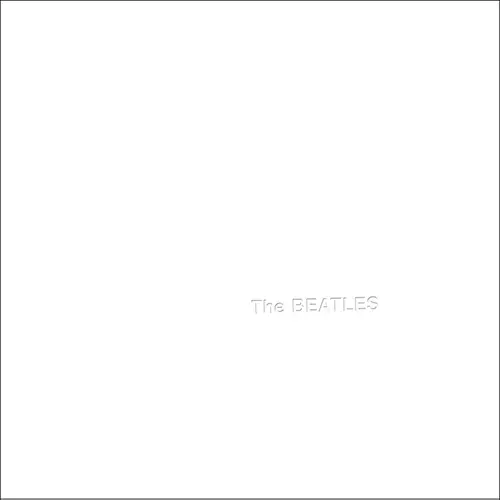
The Beatles – The Beatles (The White Album)
(1968, designed by richard hamilton).
In many ways, the cover art of The Beatles – known to all as The White Album – was the exact opposite of its predecessor, Sgt. Pepper’s Lonely Hearts Club Band . Where Pepper was busy and vibrant, 1968’s White Album was, well, white. But as with Pepper, they turned to an established artist to bring their ideas to fruition. Enter Richard Hamilton, one of the pioneers of pop art. As Hamilton recalled, “Paul McCartney requested the design be as stark a contrast to Sgt. Pepper’s day-glo explosion as possible… he got it!”
The package also included four portraits taken by John Kelly, as well as a collage poster created by Hamilton, with Paul acting as his assistant. “For me, that was a great lesson that I was getting from the hands of someone like Richard Hamilton,” said Paul, “a whole week of his thoughts. No mean teacher, man!” To continue the artistic theme, initial copies were given individual numbers, resembling editions of limited-run artworks or poetry books. In 2015, Ringo Starr’s personal copy, numbered 0000001, became the world’s most expensive record, when it sold at auction for $790,000.
Listen to The Beatles here .
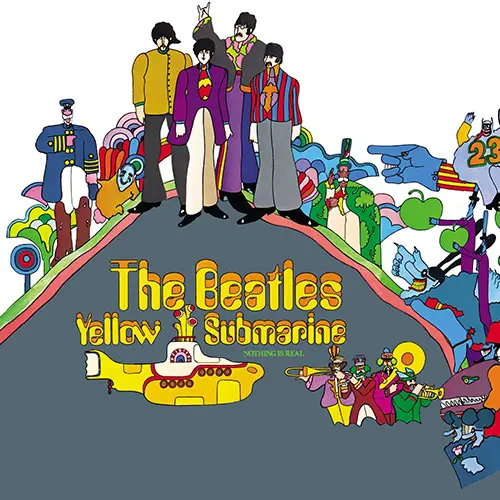
The Beatles – Yellow Submarine
(1969, director george dunning and illustrator heinz edelmann).
The soundtrack album to the 1968 animated movie Yellow Submarine is unique among Beatles albums, in that only one side of the record contains any Beatles music – side two features George Martin’s orchestral score for the film. There are, in fact, just four new Beatles songs on the entire LP.
By the time the soundtrack album was released in January 1969 (while The White Album was still at number one, and as the group began their Get Back project), their psychedelic alter-egos, as imagined by illustrator Heinz Edelmann, were so far from their current look as to make the movie appear nostalgic. Despite not being of The Beatles’ creation, the Yellow Submarine artwork remains iconic today, and adorns everything from notebooks and tote bags to playing cards and socks – there’s even a Yellow Submarine edition of Monopoly. “I loved Yellow Submarine ,” Ringo Starr recalled. “I thought it was really innovative, with great animation. The Sea of Holes, the Blue Meanie syndrome – it’s still great and I’m glad we were involved with it.”
Listen to Yellow Submarine here .
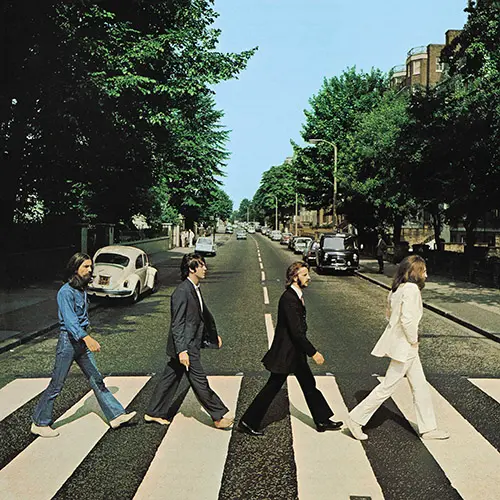
The Beatles – Abbey Road
(1969, cover art photograph by iain macmillan).
Finished up over the summer of 1969, Abbey Road was the last album recorded by The Beatles, and the working title of Everest (after engineer Geoff Emerick’s brand of cigarettes) suggested a cover shot of the group in front – or even on top – of the world’s highest peak. But when that idea was scuttled, they settled on doing almost the exact opposite; popping out the studio’s front door and naming the album Abbey Road , after the street where EMI’s studios were located.
The shoot took place on the morning of August 8, 1969, and created the most famous zebra crossing in the world. With rumors that Paul McCartney had died and been replaced by a look-a-like, fans scoured the new artwork for clues. Some thought that Paul being barefoot was a sign. John Lennon later dismissed that idea: “Paul walked barefoot across the road because Paul’s idea of being different is to look almost straight, but just have his ear painted blue – something a little subtle. So Paul decided to be barefoot that day walking across the road.”
Listen to Abbey Road here .
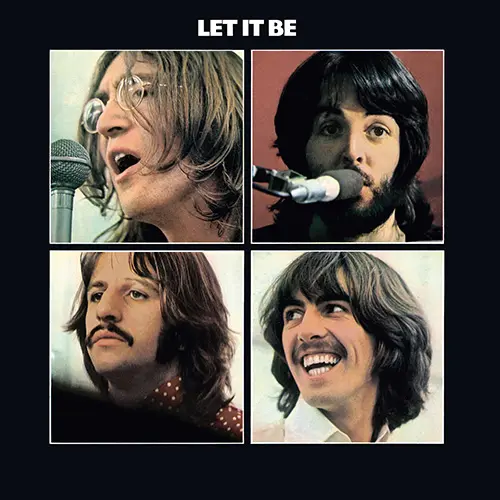
The Beatles – Let It Be
(1970, cover art photograph by ethan russell).
Although not the last album The Beatles would record, by the time Let It Be was finally edited together for release in 1970, this rock band was already part of history. Initial copies in certain territories were issued as part of a lavish box set, which included a luxurious book of Ethan Russell’s photographs. On the album cover, the four Beatles are presented simply against a black background, each shot individually and within his own box.
But that hadn’t always been the plan. The original idea was for the record to be called Get Back , with a sleeve mimicking that of their debut, Please Please Me . Photographer Angus McBean was recalled to copy his 1963 shot – at great expense. However, why this idea was ultimately rejected appears to have been lost in the mists of time. Indeed, in a 1971 open letter to Paul McCartney in Melody Maker , John Lennon asked, “By the way, what happened to my idea of putting the parody of our first album cover on the Let It Be cover?”
Listen to Let It Be here .
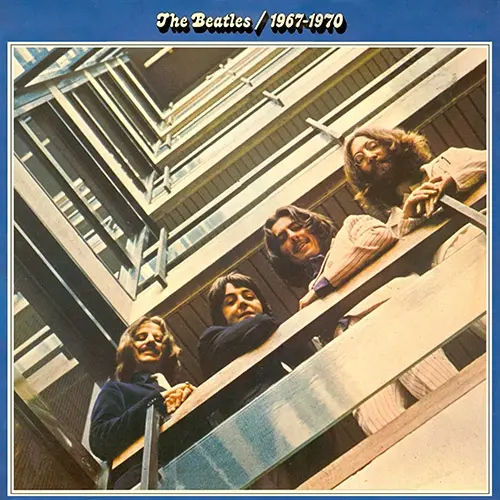
The Beatles – Red & Blue
(1973, cover art photograph by angus mcbean).
The idea had been for The Beatles’ shelved 1969 Get Back LP to mimic their 1963 debut, Please Please Me . As it was, the public had to wait until the two volumes of what became known as the Red and Blue albums were released in 1973 to enjoy the dramatic comparison of the group pictured in the same spot, just six years apart.
Angus McBean took charge of both shoots at EMI’s Manchester Square HQ. But the second shoot proved trickier than the first. An initial attempt had to be aborted as a new porch had been built in the intervening years, preventing McBean from taking up his original position. With the porch removed, they completed the shot a week or so later.
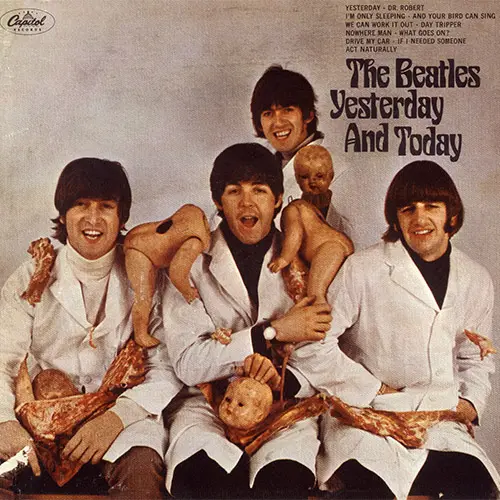
The Beatles – Yesterday & Today
(1966, cover art photograph by robert whitaker).
One of the most sought-after Beatles album covers, the infamous ‘Butcher cover’ of their June 1966 Yesterday and Today LP in the United States was a piece of conceptual art, taken by British photographer Robert Whitaker. For the shoot, the four Beatles were dressed in butchers’ jackets and draped with hunks of meat and broken parts of baby dolls. “My original idea for the cover was better,” John Lennon insisted: “Decapitate Paul. But he wouldn’t go along with it.”
As soon as the first copies of the US versions were sent out, however, the shocked reaction to the Butcher cover made Capitol Records recall the album. Their solution? Paste a new picture over the top of the old one. As Ringo Starr recalled in Anthology , “The sleeve was great for us because we were quite a nice bunch of boys and we thought, ‘Let’s do something like this!’ What was crazy about that sleeve was that, because it was banned, they glued paper over it and everyone started steaming it off. They made it into a really heavy collector’s item.” Today, copies change hands for – at least – four-figure sums.
Listen to the album here.
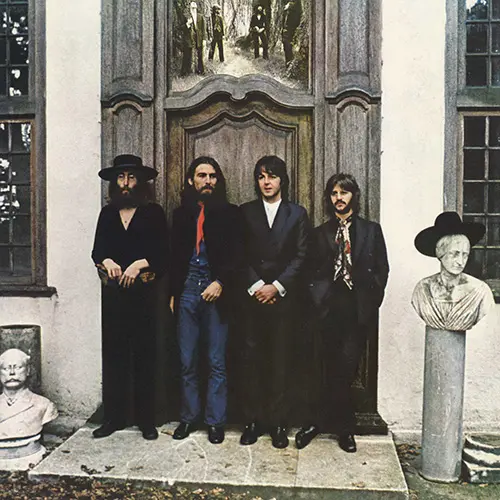
The Beatles – Hey Jude
It was likely the last time the four Beatles would all be together for a photo session. But, as Ringo Starr explained in Anthology , that was never meant to be the case. “It was just a photo session. I wasn’t there thinking ‘This is the last photo session’.” The resulting photographs included one selected to adorn their 1970 US compilation album, Hey Jude . Taken by Ethan Russell, the shoot took place at John and Yoko’s recently purchased Tittenhurst Park mansion just outside Ascot, in Surrey, on August 22, 1969.
The album cover portrait was taken in front of the estate’s Victorian Assembly Hall, the four Beatles dressed with little of the color seen on Sgt. Pepper’s Lonely Hearts Club Band . And yet despite the darkness, there is plenty of light to be found – George’s hat perched atop a Victorian bust, for example, while it’s easy to believe from the expressions on their faces that George and Paul are sharing a wry moment.
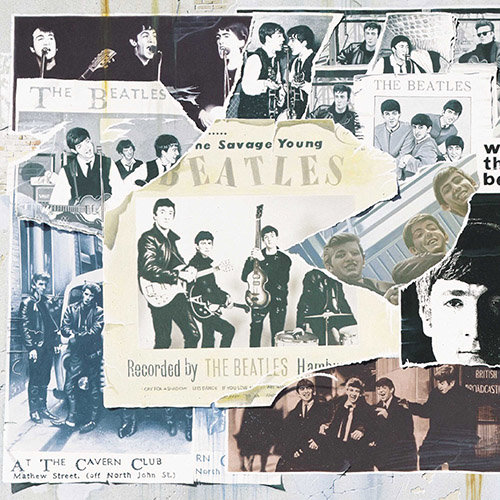
The Beatles – Anthology vols 1-3
(1995, illustration by klaus voormann).
The artwork that accompanied Anthology , The Beatles’ 1995 telling of their own story, was illustrated by Klaus Voormann, a friend from their pre-fame Hamburg days, who had played bass on a number of their solo recordings – including John Lennon’s Imagine and George Harrison’s All Things Must Pass – and had previously illustrated the cover for their 1966 Revolver LP. When placed side by side, the three volumes of Anthology make up one long collage.
Hidden in Voormann’s illustration are a number of ‘easter eggs’ for fans to enjoy. On the artwork for volume 1, for example, the artwork from an unofficial album The Savage Young Beatles sees the head of original drummer Pete Best torn off, allowing his replacement, Ringo Starr, to peer through. As a wry nod to this, Best later used the missing section as the cover of his 2008 album, Haymans Green . Another, even less-obvious gem related to Voormann’s Revolver sleeve. On the 1966 cover, Voormann hid a small snap of himself aged 28 within the artwork. For the 1995 artwork, Voormann hid a photo of his 57-year-old self in the re-drawn album cover.
Capitol Records Albums in the United States
The Beatles’ US LPs were markedly different to those issued in the UK. Early mixes, rough edits, and a thorough drenching in echo meant that – until the UK versions superseded them on CD in the 1980s – Beatles fans stateside were hearing something quite different from what The Beatles were producing. With the notable exception of Yesterday & Today (1966), The Beatles had very little to do with the artwork on US albums like Meet The Beatles . Indeed, the album art often boasted sales messages on the cover – “Electrifying big-beat performances by England’s Paul McCartney, John Lennon, George Harrison, and Ringo Starr” hollered The Beatles Second Album , while Beatles ’65 boasted “Great new hits by John • Paul • George • Ringo.”
Noranne Hertler
March 30, 2022 at 1:33 pm
What happened to “Beatles’65”? I personally owned that album and it is my favorite. It’s not mentioned anywhere in this article.
February 24, 2023 at 2:14 am
Beatles ’65 was a Capital release. These are the Parlephone albums. The Parlephone release that has most of the Beatles ’65 songs was Beatles For Sale.
February 24, 2023 at 6:55 pm
syllable Counter
September 28, 2023 at 3:47 pm
This is a great blog post! I’ve always been interested in the Beatles album covers and this post has really enlightened me. Thank you for writing it!
Roberto Berberena
March 9, 2024 at 3:23 pm
Excellent… Thank you so much for the valuable information.
March 9, 2024 at 3:24 pm
Would you add information regarding Let it Be… NAKED
Your email address will not be published. Required fields are marked *
Save my name, email, and website in this browser for the next time I comment.

Albums in Order
Get here List of Albums in order.
Uncategorized
The List of Journey Albums in Order of Release
by Ram · September 22, 2023

Journey Albums in Order: This iconic American rock band, emerged onto the music scene in 1973 in the vibrant city of San Francisco.
Journey, the iconic American rock band, emerged onto the music scene in 1973 in the vibrant city of San Francisco. Founded by former members of illustrious groups such as Santana, the Steve Miller Band, and Frumious Bandersnatch, the band has undergone various transformations over the years while maintaining its core spirit. As of 2021, the lineup featured the indomitable guitarist and vocalist Neal Schon, the longest-serving original member, as well as the talents of keyboardist, guitarist, and vocalist Jonathan Cain, keyboardist and vocalist Jason Derlatka, drummer and vocalist Deen Castronovo, bassist Todd Jensen, and lead vocalist Arnel Pineda.
Journey’s journey to musical stardom encompasses a remarkable timeline of success, with their pinnacle period spanning from 1978 to 1987 when Steve Perry assumed the role of lead vocalist. During this era, the band produced a string of chart-topping hits, including the timeless anthem “Don’t Stop Believin’,” which earned the distinction of becoming the top-selling track in iTunes history for songs not released in the 21st century. Their album “Escape” soared to number one on the Billboard 200, while “Frontiers” continued to captivate audiences in the United States and beyond. With numerous gold and platinum albums, record-breaking sales, and a reputation as one of America’s most influential rock/pop bands, Journey’s legacy is etched in the annals of music history.
Their enduring impact is celebrated globally, and their induction into the Rock and Roll Hall of Fame in 2017 solidified their place among the legends of rock. With a worldwide fan base and an enduring presence on rock radio, Journey’s melodies continue to resonate, ensuring their status as one of the world’s best-selling and most cherished bands of all time.So, if you are a die heart fan of Journey Albums then check out here we have list of Journey albums in order of release so far.
Journey Albums Available on: Apple Music
How many albums does Journey have?
The discography of American rock band Journey has released 15 studio albums, five live albums, 11 compilation albums, and 51 singles.
All Journey Albums in Order: Check Out The List of Journey Albums in Order of Release Here!
- Journey — April 1, 1975
- Look into the Future — January 1, 1976
- Next — February 1977
- Infinity — January 20, 1978
- Evolution — March 23, 1979
- Departure — February 29, 1980
- Dream, After Dream — December 10, 1980
- Escape — July 17, 1981
- Frontiers — February 22, 1983
- Raised on Radio — April 21, 1986
- Trial by Fire — October 22, 1996
- Arrival — December 1, 2000
- Generations — August 29, 2005
- Revelation — June 3, 2008
- Eclipse — May 24, 2011
- Freedom — July 8, 2022
Journey Band Albums List
1. journey (1975).

- Of a Lifetime
- In the Morning Day
- To Play Some Music
- In My Lonely Feeling / Conversations
- Mystery Mountain
Released on April 1, 1975, “Journey” marked the debut studio album of the iconic American rock band Journey, distributed by Columbia Records. In contrast to their later works, this album embraced a jazzy progressive rock style, showcasing the band’s instrumental prowess. Notably, it featured rhythm guitarist George Tickner, a unique inclusion in their lineup. Prior to this release, Journey recorded a demo album, featuring the same songs but in a different order and with Prairie Prince as the drummer. Several unreleased tracks, including instrumental pieces and the original title track “Charge of the Light Brigade,” didn’t make the final cut of this foundational album.
2. Look into the Future (1976)
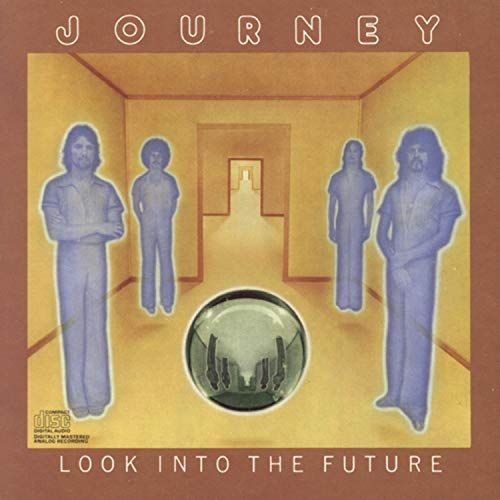
- On a Saturday Nite
- It’s All Too Much
- She Makes Me (Feel Alright)
- You’re on Your Own
- Look into the Future
- Midnight Dreamer
- I’m Gonna Leave You
“Look into the Future,” Journey’s second studio album, marked a shift in the band’s musical direction upon its January 1976 release through Columbia Records. While tempering the overt progressiveness of their debut self-titled album, this sophomore effort still retained elements of experimentation, notably in tracks like the title song and “I’m Gonna Leave You.” The album also featured a cover of The Beatles’ “It’s All Too Much” from the Yellow Submarine film. “Look into the Future” stands out as the longest recorded Journey song. Notably, this album saw the departure of rhythm guitarist George Tickner, leaving behind a lineup that included Gregg Rolie, Neal Schon, Ross Valory, and Aynsley Dunbar.
3. Next (1977)
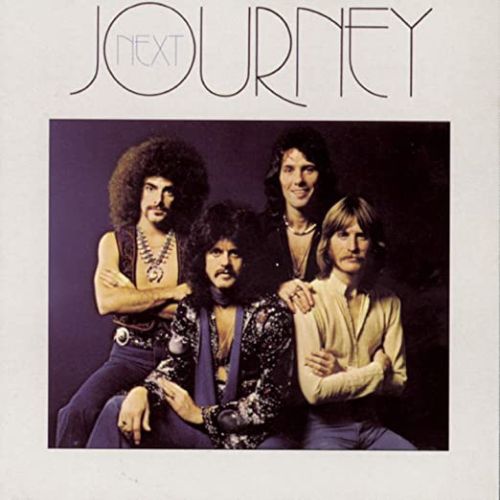
- I Would Find You
- Here We Are
- Nickel and Dime
“Released in 1977, ‘Next’ stands as Journey’s third studio album, a continuation of their signature sound that melded elements from 1976’s ‘Look into the Future’ with traces of their earlier jazzy progressive rock style. Notably, ‘Next’ marked the end of an era, being the final album to showcase Gregg Rolie as the primary lead singer. The album’s single, ‘Spaceman’/’Nickel and Dime,’ was a notable release. Interestingly, an instrumental track titled ‘Cookie Duster’ was initially listed on early pressings but not included. ‘Next’ reached No. 85 on the Billboard 200 Albums chart and witnessed the beginnings of lead vocalist Robert Fleischman’s journey with the band, setting the stage for the group’s evolving musical direction.”
4. Infinity (1978)
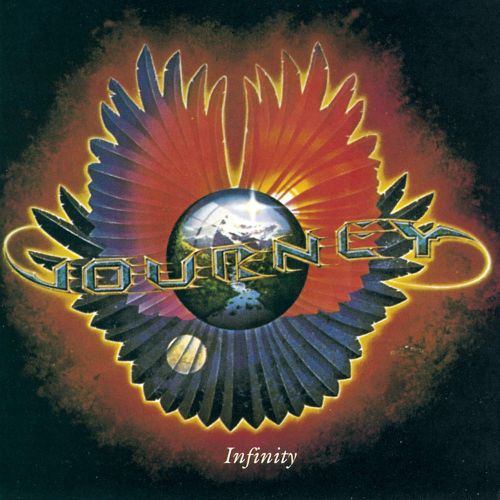
- Feeling That Way
- Wheel in the Sky
- Somethin’ to Hide
- Winds of March
- Opened the Door
“Infinity,” the fourth studio album by the renowned American rock band Journey, marked a pivotal moment in the group’s history. Released in January 1978 under Columbia Records, this album represented a significant transition for the band as it introduced the powerful vocals of Steve Perry, becoming their first album with him as the lead singer. Simultaneously, it marked the end of an era, being the final album to feature drummer Aynsley Dunbar. This milestone release showcased Journey’s evolving sound and set the stage for their future successes, laying the foundation for the iconic musical journey that lay ahead.
5. Evolution (1979)
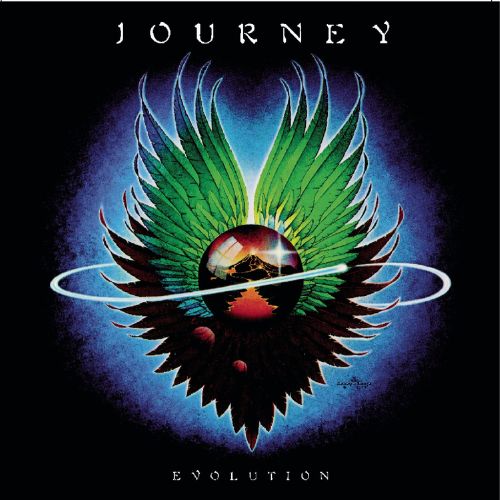
- Lovin’, Touchin’, Squeezin’
- City of the Angels
- When You’re Alone (It Ain’t Easy)
- Sweet and Simple
- Lovin’ You Is Easy
- Just the Same Way
- Do You Recall
“Evolution,” the fifth studio album by American rock band Journey, marked a significant turning point in their career. Released in March 1979 under Columbia Records, this album introduced drummer Steve Smith to the band’s lineup. “Evolution” proved to be their most successful album at the time, peaking at No. 20 on the US Billboard 200 chart and selling three million copies in the US. Produced by Roy Thomas Baker, known for his work with Queen, the album featured the hit “Lovin’, Touchin’, Squeezin’,” their first top 20 single, and “Just the Same Way,” which showcased both original lead vocalist Gregg Rolie and Steve Perry. With tracks like “Too Late,” “Evolution” pushed the boundaries of rock ballads, featuring Neal Schon’s impressive guitar work.
6. Departure (1980)
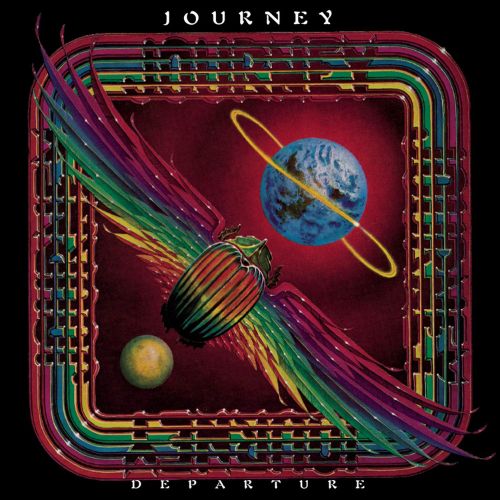
- Any Way You Want It
- Walks Like a Lady
- Someday Soon
- People and Places
- Precious Time
- Where Were You
- I’m Cryin’
- Line of Fire
- Good Morning Girl
- Stay Awhile
- Homemade Love
- Natural Thing
- Little Girl
“Departure,” the sixth studio album by American rock band Journey, made its debut on February 29, 1980, under the Columbia Records label. This album marked a significant milestone for Journey as it became their first top 10 Billboard 200 album, reaching No. 8. Featuring the hit track “Any Way You Want It,” which also made it to the top 25 singles chart, “Departure” showcased a slightly edgier sound due to its unique “live in studio” recording approach. The album included three singles, with “Walks Like a Lady” and a medley of “Good Morning Girl” and “Stay Awhile” also making their mark on the charts.
Notably, this album marked the departure of founding member Gregg Rolie and paved the way for Jonathan Cain to join the band. In subsequent years, “Departure” underwent remastering and reissues to introduce bonus tracks for fans worldwide.
7. Dream, After Dream (1980)
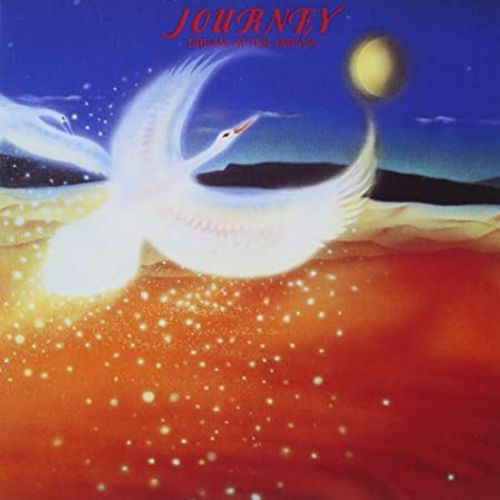
- Sandcastles
- A Few Coins
- When the Love Has Gone
- Festival Dance
“Dream, After Dream,” the soundtrack album by American rock band Journey, accompanies the Japanese fantasy film “Yume, Yume No Ato,” directed by Kenzo Takada. Released in 1980 on Columbia Records, it marked the band’s seventh album and a significant departure from their hard rock sound, embracing their progressive rock roots. The album, with nine tracks, includes vocals on “Destiny,” “Sand Castles,” and “Little Girl,” the latter becoming the B-side of “Open Arms.” This soundtrack also holds historical significance as it was the last studio album featuring founding member Gregg Rolie. While the film remained relatively obscure, the album remains a unique chapter in Journey’s musical journey.
8. Escape (1981)

- Don’t Stop Believin’
- Stone in Love
- Who’s Crying Now
- Keep On Runnin’
- Still They Ride
- Lay It Down
- Dead or Alive
- Mother, Father
Escape, stylized as E5C4P3 on the album cover, marks the pinnacle of Journey’s musical journey. This seventh studio album, released on July 17, 1981, via Columbia Records, soared to the top of the American Billboard 200 chart. A true chart-topping sensation, Escape boasts an impressive quartet of Billboard Hot 100 singles, including the iconic anthem ‘Don’t Stop Believin’ (no. 9), ‘Who’s Crying Now’ (no. 4), ‘Still They Ride’ (no. 19), and the heartfelt ballad ‘Open Arms’ (no. 2). This rock masterpiece also gifted the airwaves with the enduring classic ‘Stone in Love.’ In July 2021, the RIAA certified it as diamond, solidifying its status as Journey’s most successful studio album and second most successful overall, following only behind their Greatest Hits compilation.
9. Frontiers (1983)

- Separate Ways (Worlds Apart)
- Send Her My Love
- Chain Reaction
- After the Fall
- Edge of the Blade
- Troubled Child
“Frontiers,” the eighth studio album by the American rock band Journey, was released on February 1, 1983, under Columbia Records. Notably, it marked the last appearance of bassist Ross Valory until 1996’s “Trial by Fire.” The album achieved great success, reaching No. 2 on the Billboard 200 chart and spawning four top 40 singles: “After the Fall” (No. 23), “Send Her My Love” (No. 23), “Faithfully” (No. 12), and “Separate Ways (Worlds Apart)” (No. 8). “Frontiers” was later certified six times platinum by the RIAA. Interestingly, the album’s tracklist underwent last-minute changes, with two songs replaced, one of which, “Only the Young,” gained popularity in the movie “Vision Quest.”
10. Raised on Radio (1986)
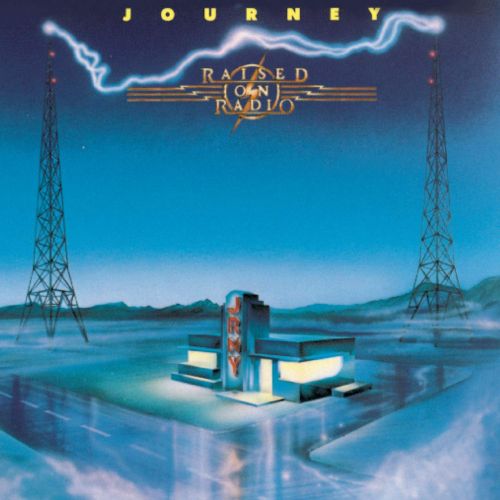
- Girl Can’t Help It
- Positive Touch
- Be Good to Yourself
- Once You Love Somebody
- Happy to Give
- Raised on Radio
- I’ll Be Alright Without You
- It Could Have Been You
- The Eyes of a Woman
- Why Can’t This Night Go on Forever
“Raised on Radio,” the ninth studio album by the American rock band Journey, made its debut in April 1986 under the Columbia Records label. This album marked a significant transition as it was the first without founding bassist Ross Valory, replaced initially by session bassist Bob Glaub and later by Randy Jackson. Drummer Steve Smith contributed to select tracks but was eventually replaced by session drummer Larrie Londin and later Mike Baird for the subsequent tour. The album was a commercial success, yielding three top 20 singles in the US, including “Girl Can’t Help It,” “I’ll Be Alright Without You,” and “Suzanne.” It reached No. 4 on the Billboard 200 chart and achieved double platinum certification in the USA.
11. Trial by Fire (1996)
- Message of Love
- When You Love a Woman
- If He Should Break Your Heart
- Forever in Blue
- Castles Burning
- Don’t Be Down on Me Baby
- Still She Cries
- Colors of the Spirit
- When I Think of You
- Easy to Fall
- Can’t Tame the Lion
- It’s Just the Rain
- Trial by Fire
- Baby I’m a Leavin’ You
- I Can See It in Your Eyes
“Trial by Fire,” the tenth studio album by American rock band Journey, released on October 22, 1996, marked a significant reunion. It brought together the classic 1981–1985 lineup, which hadn’t recorded together since 1983’s “Frontiers.” Produced by Kevin Shirley, the album featured bassist Ross Valory and drummer Steve Smith, rejoining since “Frontiers” and marked the final collaboration with vocalist Steve Perry. Notable tracks include the Grammy-nominated hit “When You Love a Woman” and spiritually-inspired songs. Despite its success, it’s the only Journey album without a supporting tour, due to internal disputes and Perry’s hip injury. “Trial by Fire” reached No. 3 on the Billboard 200 and was certified platinum.
12. Arrival (2001)
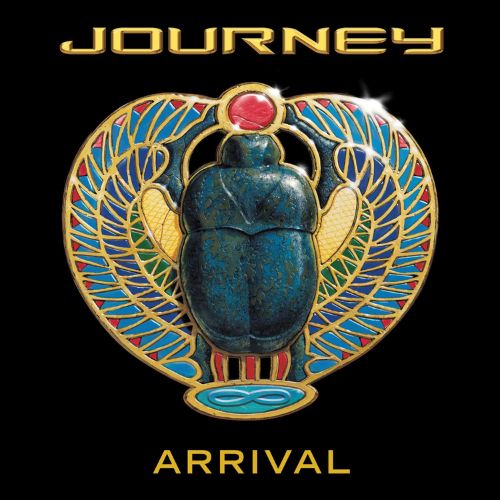
- Higher Place
- All the Way
- Signs of Life
- All the Things
- Loved by You
- Livin’ to Do
- World Gone Wild
- I Got a Reason
- With Your Love
- Lifetime of Dreams
- Live and Breathe
- Nothin’ Comes Close
- To Be Alive Again
- Kiss Me Softly
- We Will Meet Again
“Arrival,” the eleventh studio album by the iconic American rock band Journey, made its debut on April 3, 2001, following a Japanese release in 2000 with one substituted song. This record marked a significant transition for the band, as it introduced new lead vocalist Steve Augeri, taking the reins from the beloved Steve Perry, and featured Deen Castronovo as the new drummer, succeeding Steve Smith. “Arrival” showcased a blend of hard rock influences reminiscent of the band’s ’70s and ’80s material, alongside signature ballads akin to Perry’s style. While commercially successful, peaking at #12 on Billboard’s Top Internet Albums chart, the album garnered mixed critical reviews, with praise for Neal Schon’s guitar work but criticism for its formulaic elements.
13. Generations (2005)
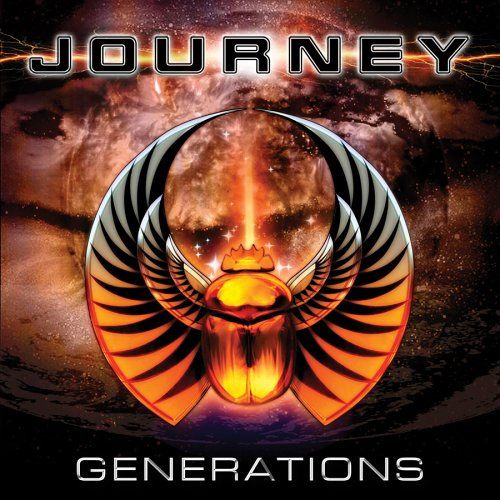
- Faith in the Heartland
- The Place in Your Heart
- A Better Life
- Every Generation
- Butterfly (She Flies Alone)
- Knowing That You Love Me
- Out of Harms Way
- In Self-Defense
- Better Together
- Beyond the Clouds
- Never Too Late
- Pride of the Family
“Generations,” the twelfth studio album by iconic American rock band Journey, marked the end of an era with lead singer Steve Augeri. Released in 2005 on Sanctuary Records, it solidified the line-up that had debuted in 2000’s “Arrival” and continued with 2002’s “Red 13 EP,” featuring Deen Castronovo on drums. A distinctive feature of this album was that all band members shared lead vocal duties, driven by Augeri’s vocal fatigue. Critical reception was mixed, with praise for Augeri’s performance and the band’s diverse musical direction, but uncertainty about the vocal-sharing decision. The album peaked at No. 170 on the Billboard 200 chart, and Augeri left the band during the 2006 tour due to a throat infection, marking the end of an era for Journey’s sound.
14. Revelation (2008)

- Never Walk Away
- Like a Sunshower
- Change for the Better
- Wildest Dream
- After All These Years
- Where Did I Lose Your Love
- What I Needed
- What It Takes to Win
- Turn Down the World Tonight
- The Journey (Revelation)
- Let It Take You Back
“Revelation,” the thirteenth studio album by American rock band Journey, marked a significant chapter in the band’s history as their first featuring lead singer Arnel Pineda. The album boasted 11 new songs and 11 re-recorded greatest hits, all showcasing Pineda’s vocal prowess. Additionally, the North American version included a DVD capturing the band’s energetic March 8, 2008 concert in Las Vegas. Notable singles like “Never Walk Away,” “Where Did I Lose Your Love,” and “After All These Years,” penned by Neal Schon and Jonathan Cain, found success on the adult contemporary charts. The album received positive reviews, lauding Pineda’s vocals and the band’s return to form. A bonus track, “Let It Take You Back,” was included in the European release.
15. Eclipse (2011)

- City of Hope
- Edge of the Moment
- Chain of Love
- Anything Is Possible
- She’s a Mystery
- To Whom It May Concern
Eclipse (stylized as ECL1P53) marks the fourteenth studio album by the iconic American rock band Journey and the second featuring lead singer Arnel Pineda. Released on various dates worldwide in 2011, with the United States and Canada receiving it on May 24, followed by Japan on May 27, the United Kingdom on May 30, and the international release on June 3, this album showcases the songwriting prowess of Neal Schon and Jonathan Cain, with contributions from Pineda. Notably, it stands as the final album with bassist Ross Valory, who departed the group in 2020. ‘Eclipse’ adds another chapter to Journey’s enduring musical legacy.
16. Freedom (2022)
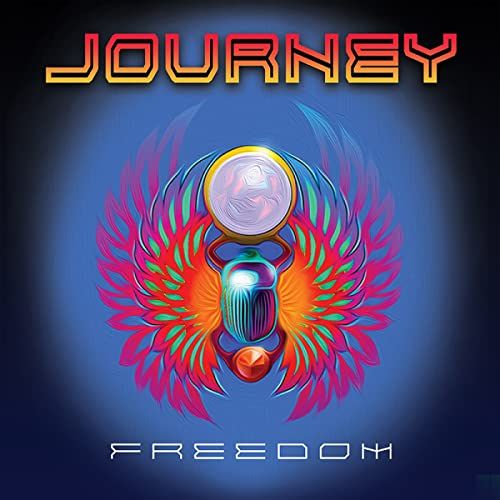
- Together We Run
- Don’t Give Up on Us
- Still Believe in Love
- You Got the Best of Me
- Live to Love Again
- The Way We Used to Be
- Come Away with Me
- Let It Rain
- Holdin’ On
- All Day, All Night
- Don’t Go
- United We Stand
- Life Rolls On
- Beautiful as You Are
“Freedom,” the fifteenth studio album by the iconic American rock band Journey, made its debut on July 8, 2022, under the labels BMG Rights Management and Frontiers Records. Marking a significant change, it stands as the band’s second album without founding bassist Ross Valory, replaced by Randy Jackson, who last appeared on “Raised on Radio” in 1986. Boasting fifteen tracks and a runtime of an impressive one hour and thirteen minutes, it secures the title of Journey’s lengthiest album, excluding compilation records. While lauded for performances and musicianship, the album garnered mixed critical reviews, with attention drawn to production, mixing, and its extended duration.
Thanks for Visit!
Tags: Albums
You may also like...
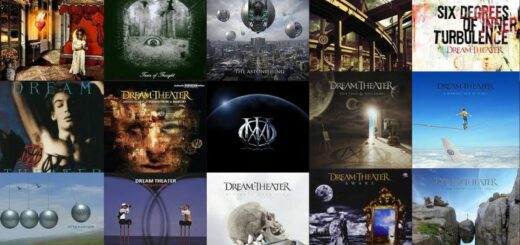
The List of Dream Theater Albums in Order of Release
December 6, 2023
by Ram · Published December 6, 2023
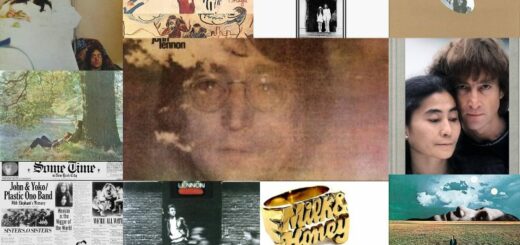
The List of John Lennon Albums in Order of Release
August 4, 2023
by Ram · Published August 4, 2023
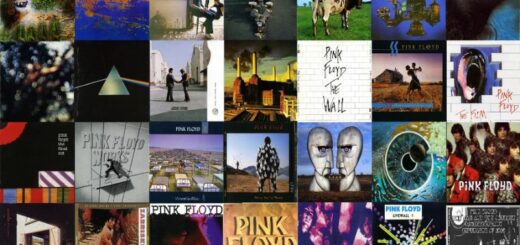
The List of Pink Floyd Albums in Order of Release Date
April 22, 2024
by Ram · Published April 22, 2024
Leave a Reply Cancel reply
Your email address will not be published. Required fields are marked *
Save my name, email, and website in this browser for the next time I comment.
- Next story The List of R. Kelly Albums in Order of Release
- Previous story The List of Zach Bryan Albums in Order of Release
Recent Posts
The List of Billie Eilish Albums in Order of Release Date
The List of Imagine Dragons Albums in Order of Release
The List of Fall Out Boy Albums in Order of Release
The List of Chayce Beckham Albums in Order of Release Date
- The List of Justin Bieber Albums in Order of Release
Recent Comments
- Privacy Policy
- Sample Page
- February 2024
- January 2024
- December 2023
- November 2023
- October 2023
- September 2023
- August 2023
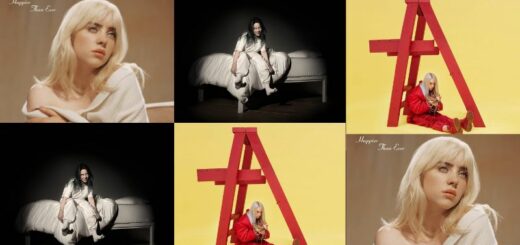
May 1, 2024
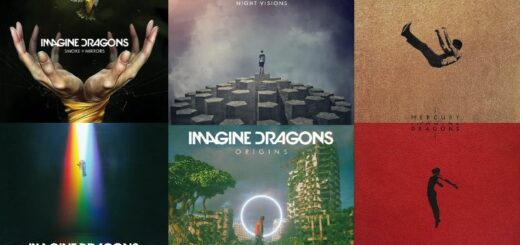
April 27, 2024

April 26, 2024
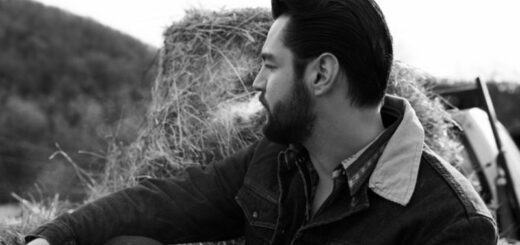

IMAGES
VIDEO
COMMENTS
Other artists prepared modified scarabs that appeared on subsequent Journey album covers - including 2001's Arrival, 2005's Generations and 2011's Eclipse - but the image remained crucial for ...
(Updated April 23, 2017: Twitter user @raycoopteacher pointed out that Journey released a live album Captured that featured the dung beetle prior to Escape.. Google mysteriously comes up short in providing an explanation as to why the band chose to incorporate the scarab beetle on its album covers.
In the number eight spot on our 10 Best Journey Album Covers List we present the album entitled Eclipse. This is a much more modern day looking depiction of the Journey Space bug beetle ship that we see on many of the band's album covers. The album was released on May 24, 2011.
Escape (stylized as E5C4P3 on the album cover) is the seventh studio album by American rock band Journey, released on July 17, 1981 by Columbia Records. It topped the American Billboard 200 chart and features four hit Billboard Hot 100 singles - "Don't Stop Believin'" (No. 9), "Who's Crying Now" (No. 4), "Still They Ride" (No. 19) and "Open Arms" (No. 2) - plus rock radio staple "Stone in ...
August 8, 2012 ·. Apparently, the scarab beetle appears on the majority of the Journey album covers because the band,s former manager, Walter "Herbie" Herbert decided upon using this artwork for Journey,s album covers, although there seems to be no explanation for why this was done. My impression is that Journey,s former manager did this in an ...
Departure is the sixth studio album by American rock band Journey.It was released on February 29, 1980, by Columbia Records.. Departure was Journey's highest-charting album to that point, giving them their first appearance in the top 10 of the Billboard 200 album charts, peaking at No. 8. The album includes "Any Way You Want It", the leadoff track and top 25 single.
In music, We can see the rock band Journey, from the 80's, used the scarab beetle as their main logo and in the cover art of the albums, including their greatest hits, departure and escape. In literature, P. G. Wodehouse's first Blandings novel - Something Fresh (1915) - involves the pilfering of a rare Egyptian scarab (a "Cheops of ...
Eclipse (stylized as ECL1P53) is the fourteenth studio album by American rock band Journey and the second with lead singer Arnel Pineda. Penned by Neal Schon and Jonathan Cain with contributions from Pineda, the album was released in the United States and Canada on May 24, 2011, on May 27, 2011, in Japan, in the United Kingdom on May 30, 2011, and internationally on June 3, 2011.
From the moment that Don't Stop Believin' was used as the final piece of music in The Sopranos to the endless cover versions of Open Arms on American TV talent shows, Escape has become a piece of music that Jonathan Cain said "has lasted somehow. The songs are bigger than we are." Cain, formerly of The Babys, was Journey's missing piece. When he replaced Greg Rolie, the band left ...
Journey's interest in experimental jazz-fusion was confirmed on their self-titled debut album issued in 1975. A classy work, the album resonates with a surety beyond their recent formation, all players coming across as both fluid and experienced. Neal Schon in particular rips up his fretboard like combination of Jeff Beck and Robert Fripp.
It follows that the band's album covers are as cryptic and weird as its songs. The artwork of the band's 2006 album, 10,000 Days, depicts a creepy, somewhat ancient-looking face with deep eyes. Then a closer look reveals it's three faces; it's like one of those Magic Eye pictures but with more existential dread.
Google mysteriously comes up short in providing an explanation as to why the band chose to incorporate the scarab beetle on its album covers. Fortunately for us, that allows us to create our own interpretation. First, a quick primer on Egyptian mythology: the scarab beetle was notable for a couple of things: first, it's a dung beetle.
One of the biggest bands of the late 1970s and early 1980s, Journey is considered one of the best rock bands of all time. List of the best Journey albums, including pictures of the album covers when available. This Journey discography is ranked from best to worst, so the top Journey albums can be found at the top of the list.
The Beatles, Abbey Road (1969) The iconic cover of The Beatles' 'Abbey Road' album, released in 1969, is steeped in symbolism. The photograph, taken by Iain Macmillan, captures the band members—John Lennon, Paul McCartney, George Harrison, and Ringo Starr crossing the zebra crossing outside Abbey Road Studios.
Frontiers is the eighth studio album by the American rock band Journey, released in February 1983, by Columbia Records. This was the band's last album to feature bassist Ross Valory until 1996's Trial by Fire.. The album reached No. 2 on the Billboard 200 chart and would garner four top 40 singles: "After the Fall" (No. 23), "Send Her My Love" (No. 23), "Faithfully" (No. 12), and "Separate ...
The top ranked albums by Journey are Escape, Infinity and Frontiers. The top rated tracks by Journey are Separate Ways (Worlds Apart), Don't Stop Believin', Open Arms, Don't Stop Believin' and Any Way You Want It. ... a mean average of 64.7/100, and a trimmed mean (excluding outliers) of 64.7/100. ... Journey's beetle is the only beetle I will ...
I'm forever yours… Back in 1983, Journey released one of their most popular, and emotional songs to date: "Faithfully." The song is a power ballad that is commonly played as a slow dance song at weddings, proms and other celebrations.It showcases lead vocalist Steve Perry's amazing voice, and is one of the band's best songs! Not many people know the true meaning of this classic tune.
In his book The Art of The Beatles, Mike Evans explained, "their image was always unique. Unlike their contemporaries on the music scene, whose style reflected the times, The Beatles invariably ...
In subsequent years, "Departure" underwent remastering and reissues to introduce bonus tracks for fans worldwide. 7. Dream, After Dream (1980) Tracks. "Dream, After Dream," the soundtrack album by American rock band Journey, accompanies the Japanese fantasy film "Yume, Yume No Ato," directed by Kenzo Takada.
2. Singles. 52. Soundtrack albums. 1. American rock band Journey has released 15 studio albums, five live albums, 11 compilation albums, and 52 singles since 1975.
Because of the dung beetle's significance in ancient Egypt, the scarab beetle came to represent the eternal cycle of life. Like the dung beetle's revolving ball, the scarab became a symbol of birth, life, death, and resurrection.
Greatest Trios in Rock History; Top 10 Denny Laine Songs; Neil Young Album Review; Denny Laine Dies; McCartney's Tribute to Laine; Black Crowes Interview; How an Unused Jimi Hendr